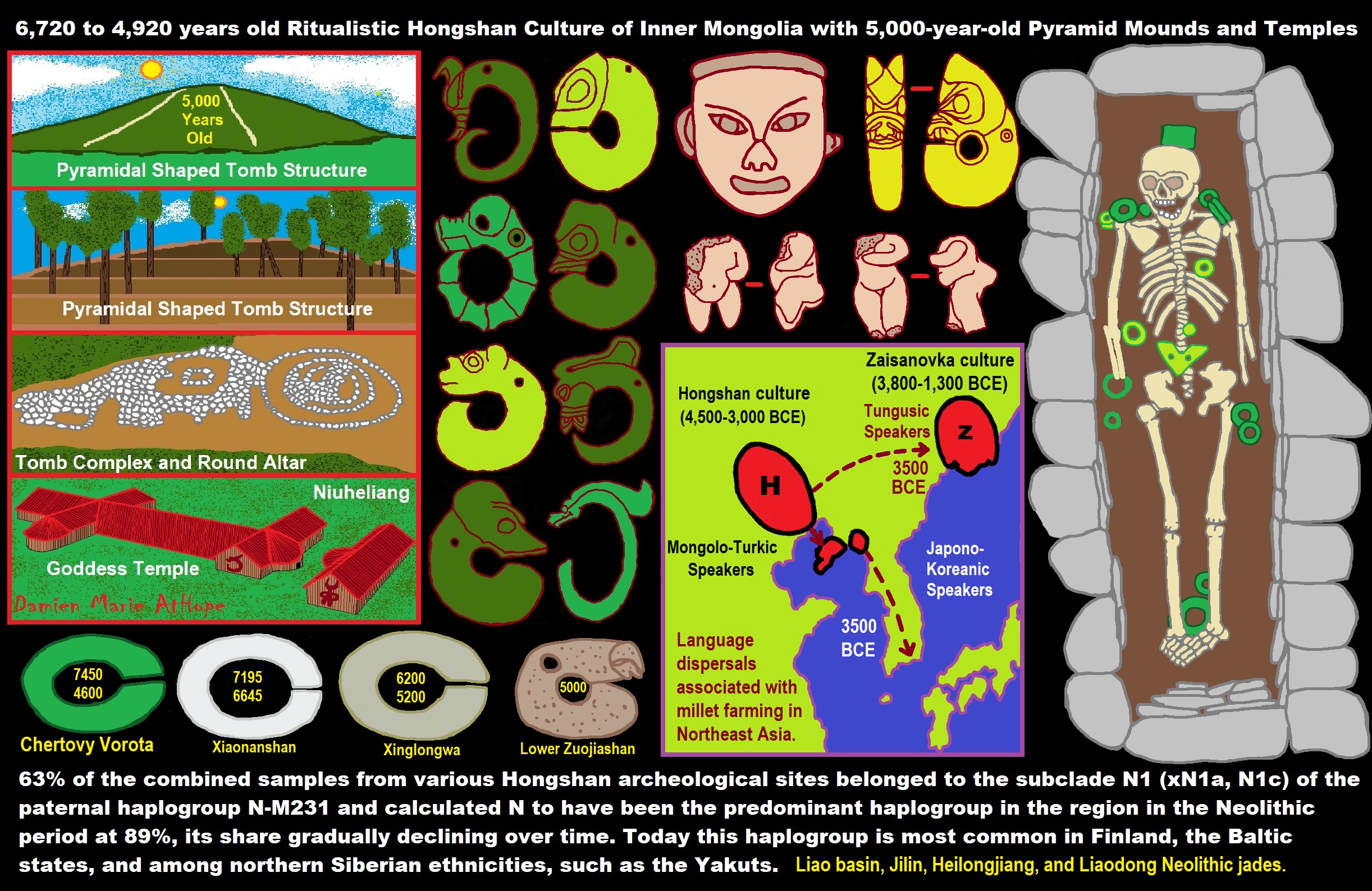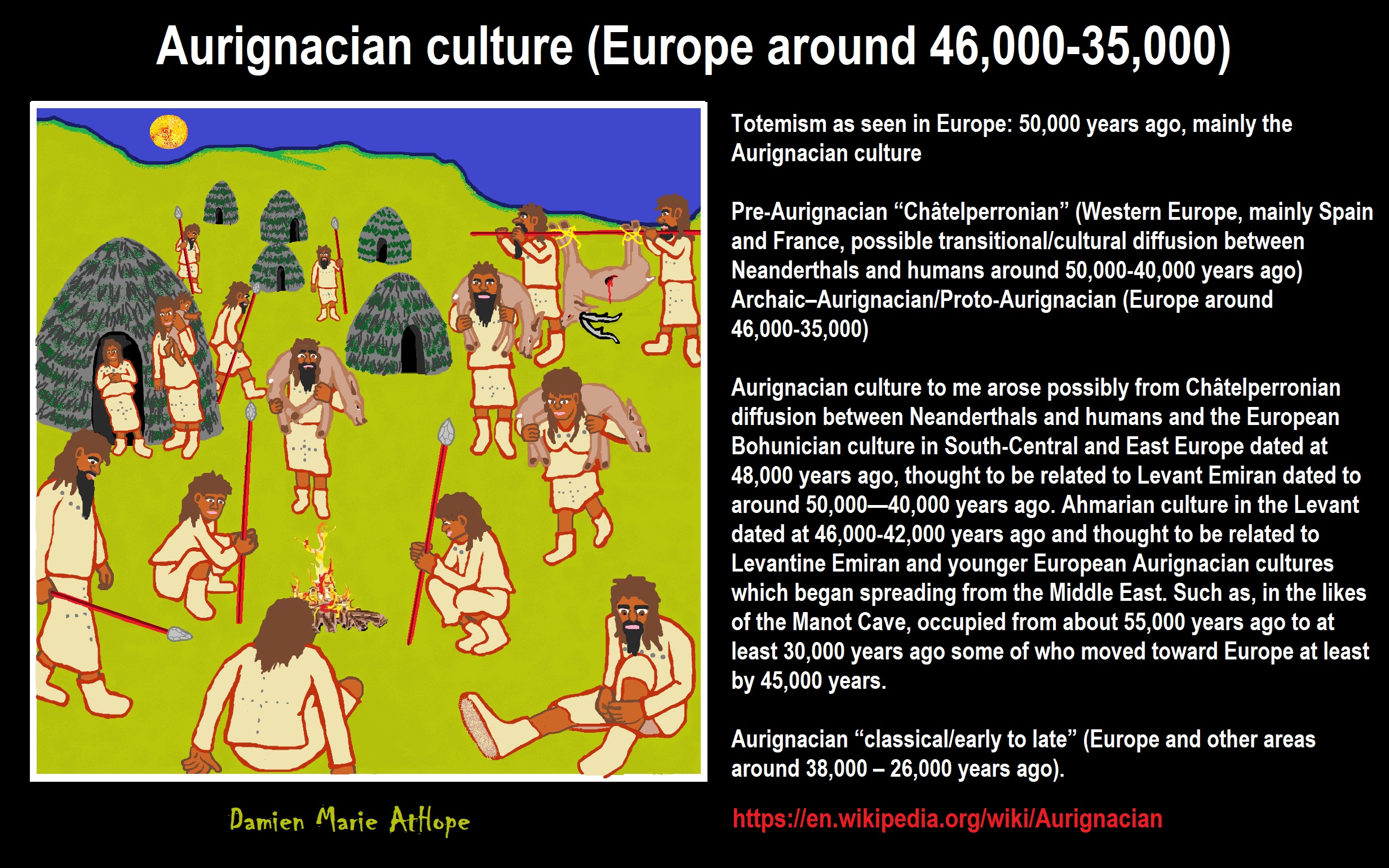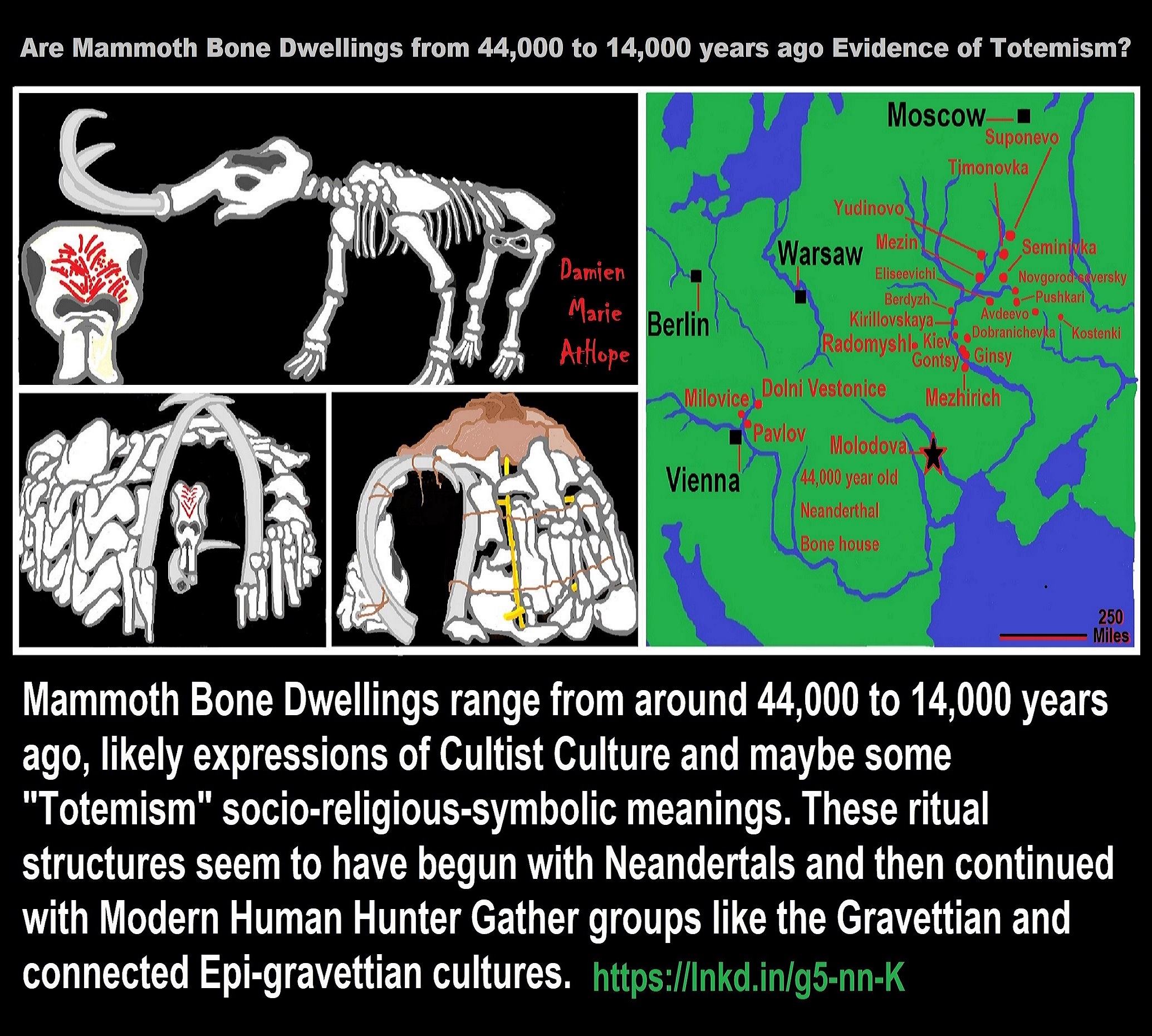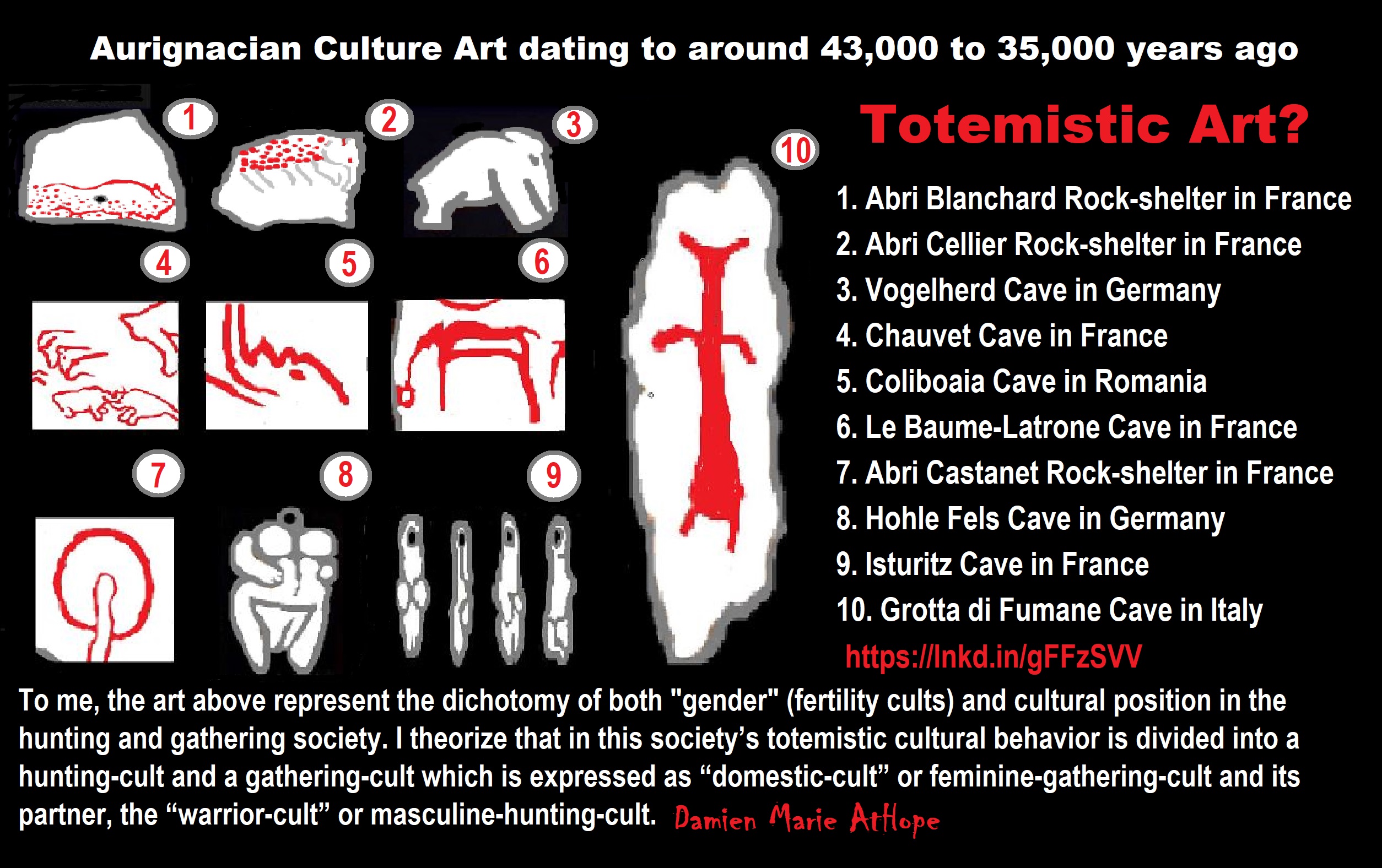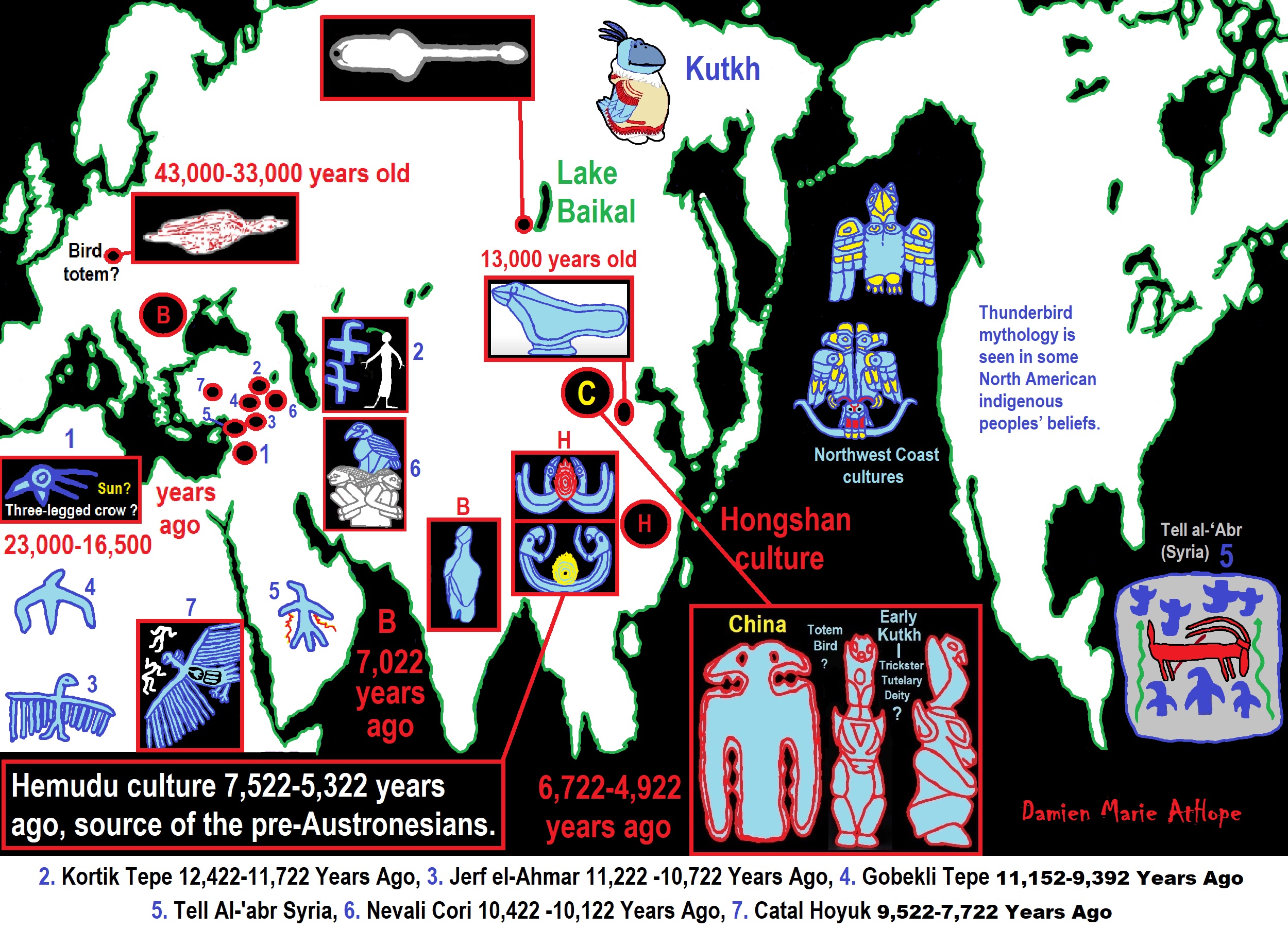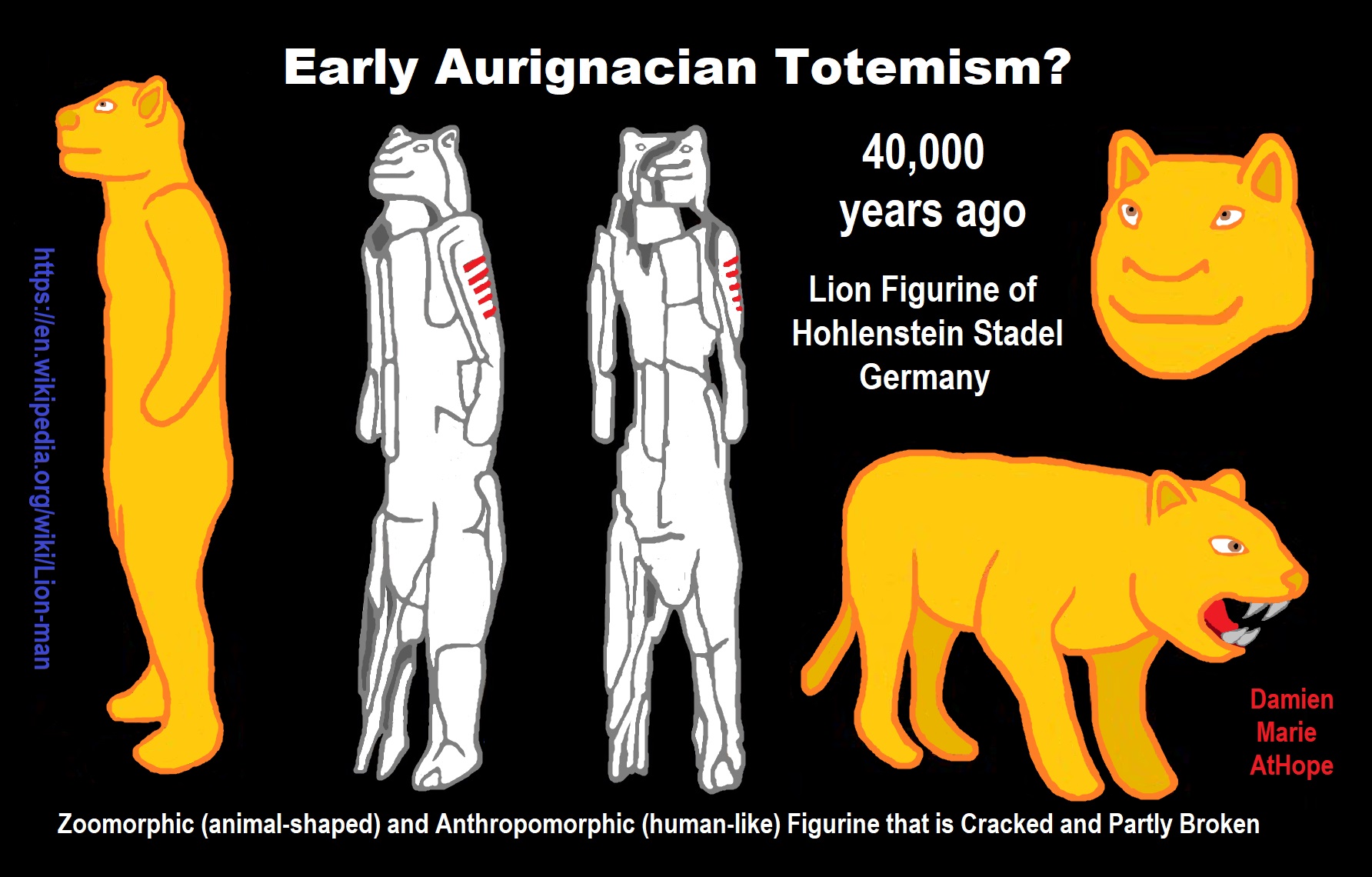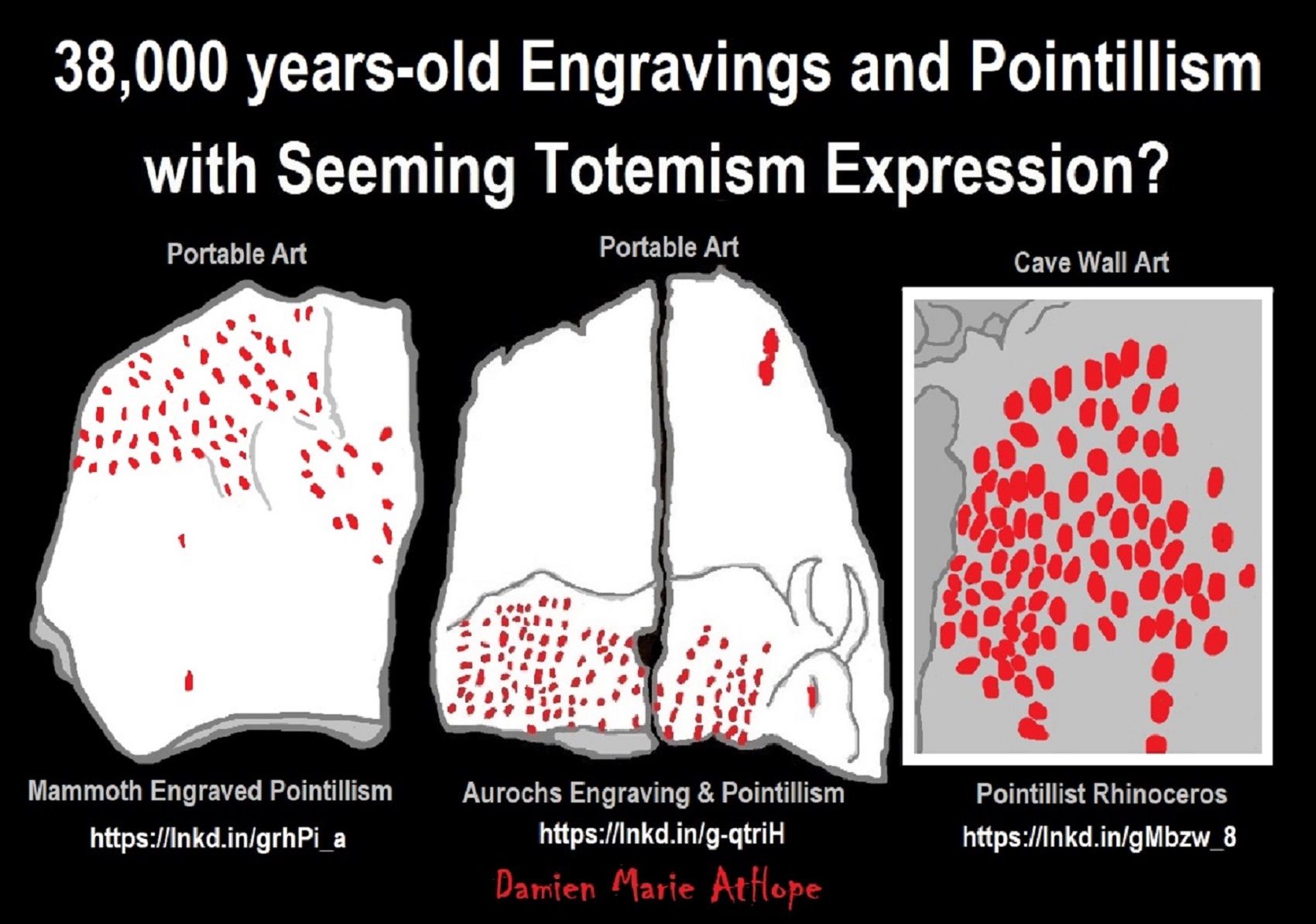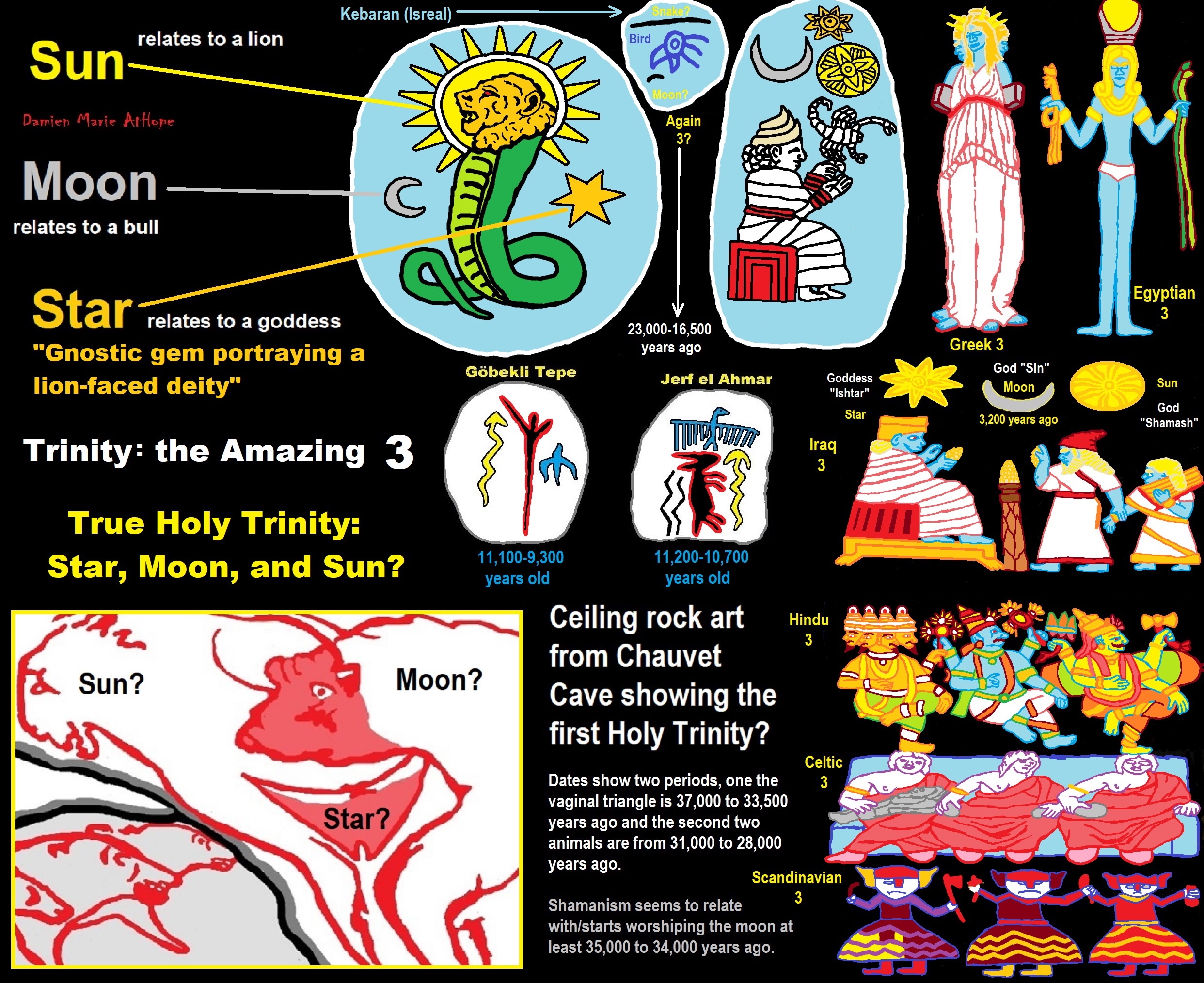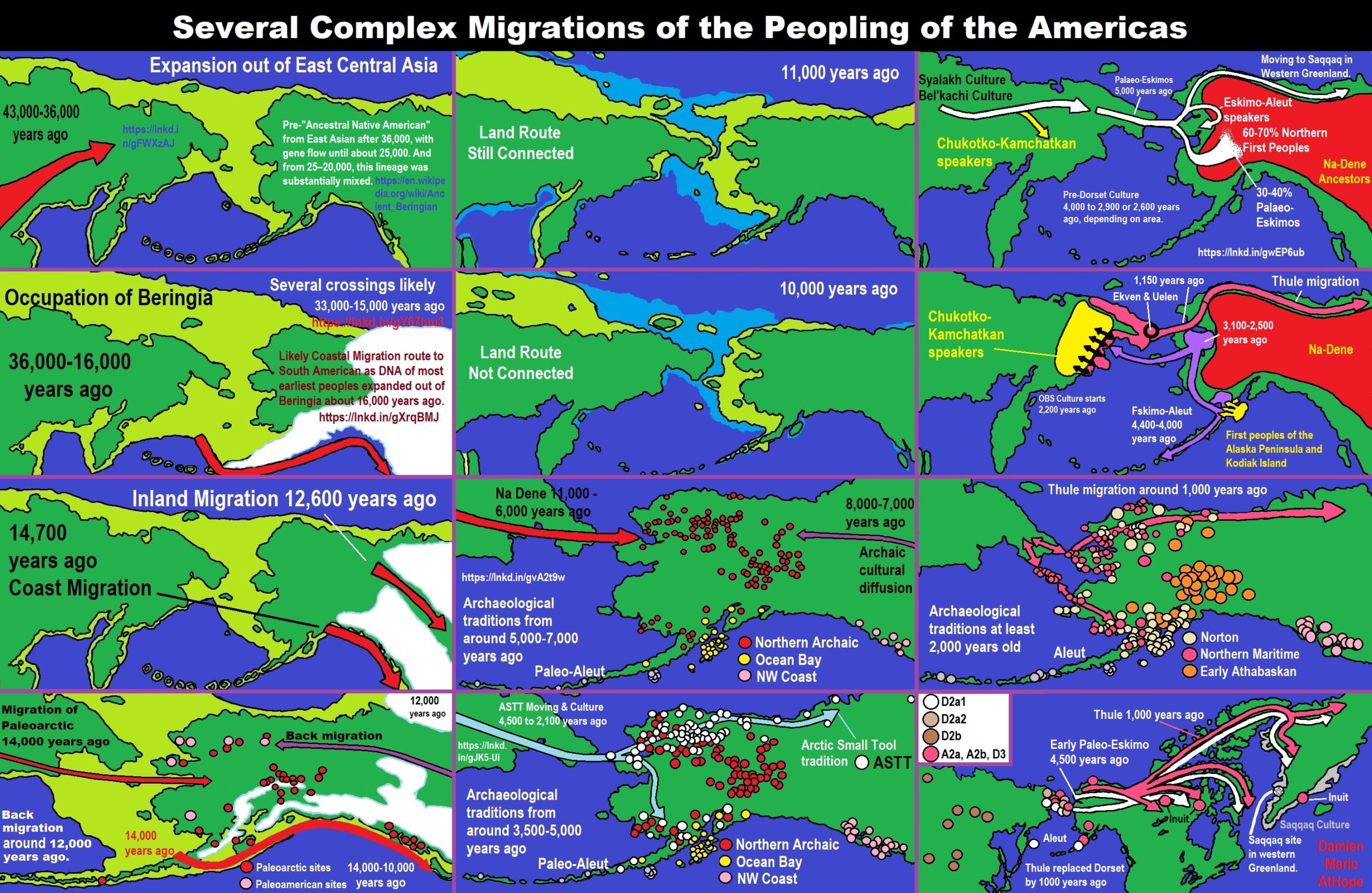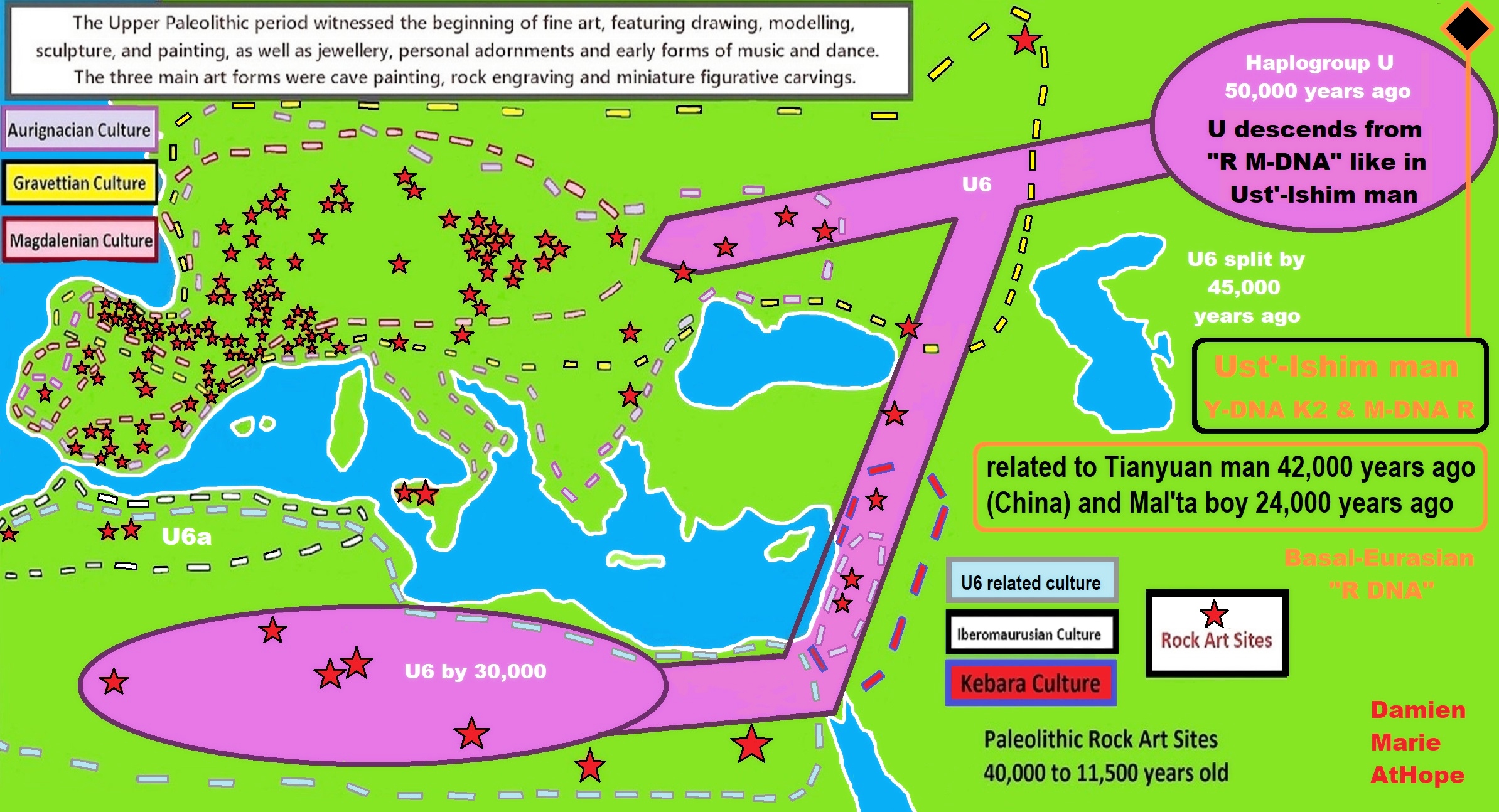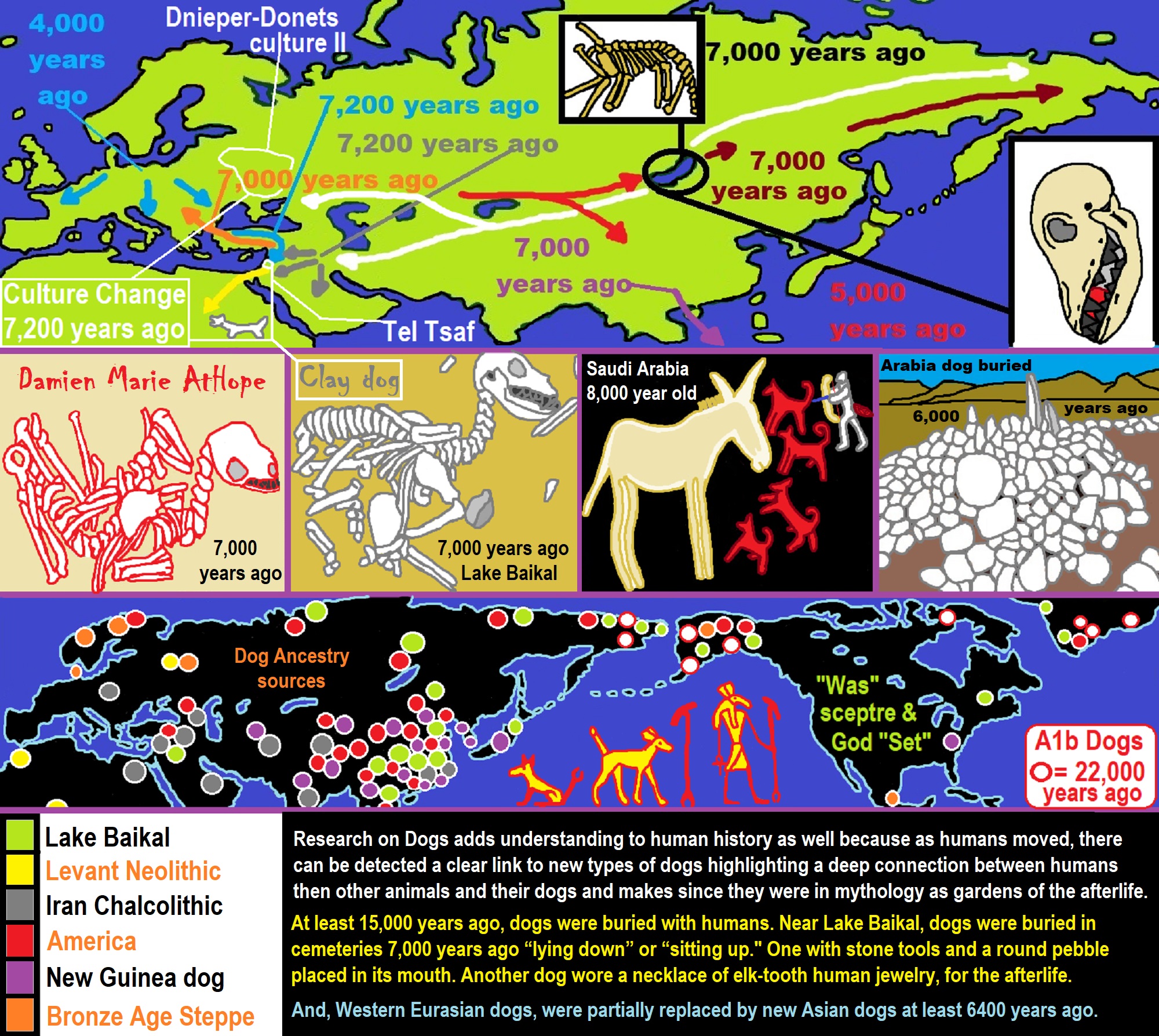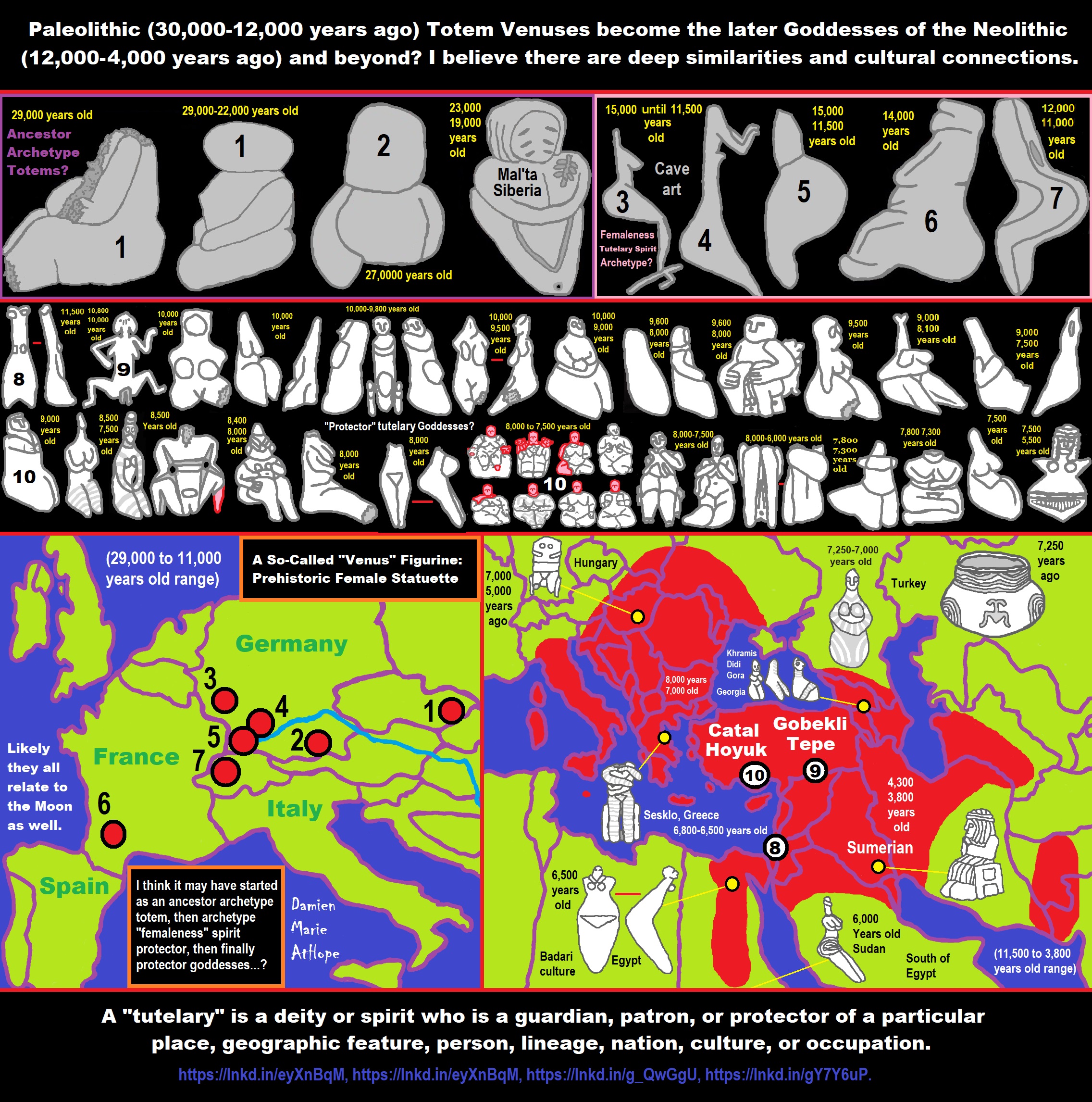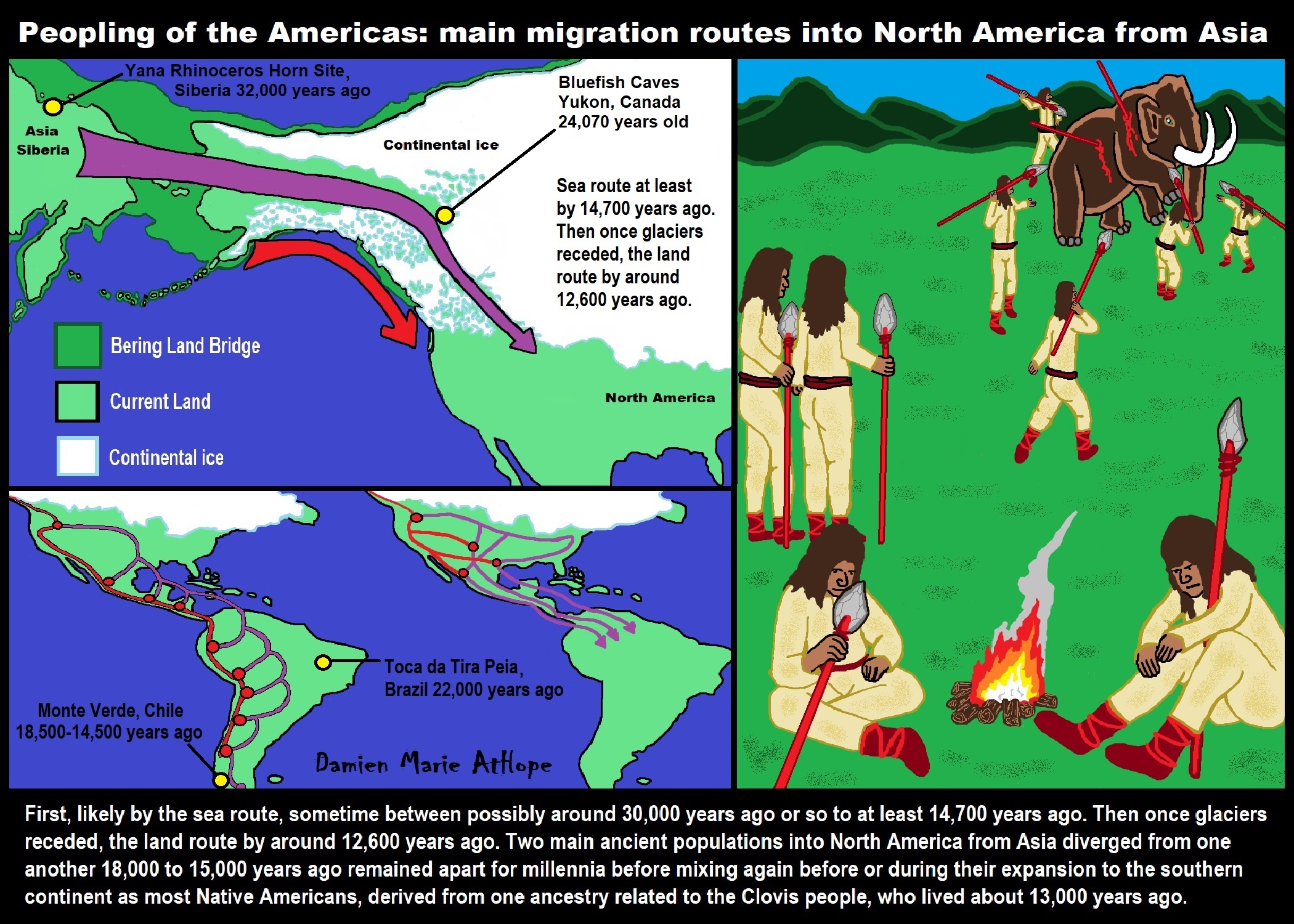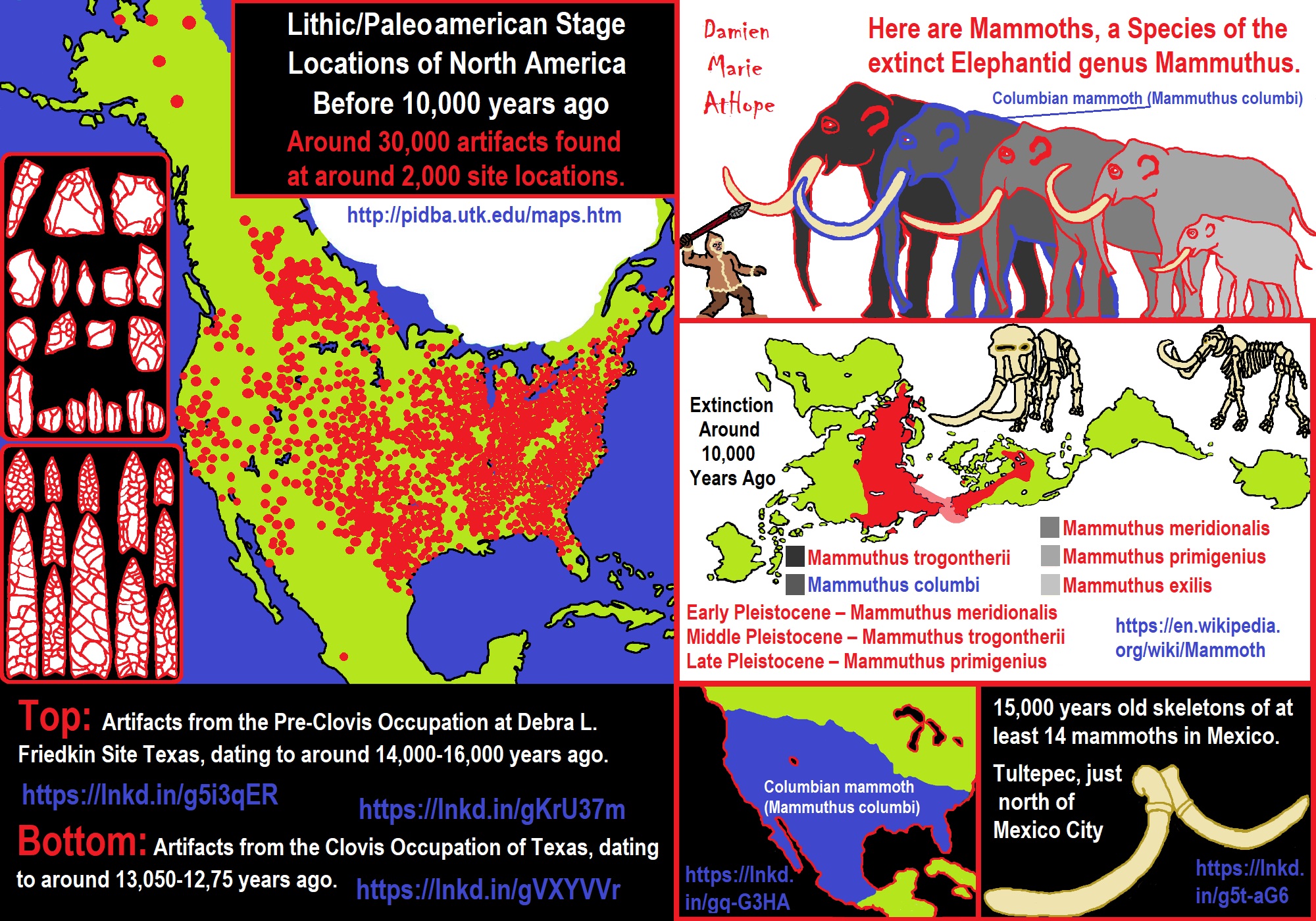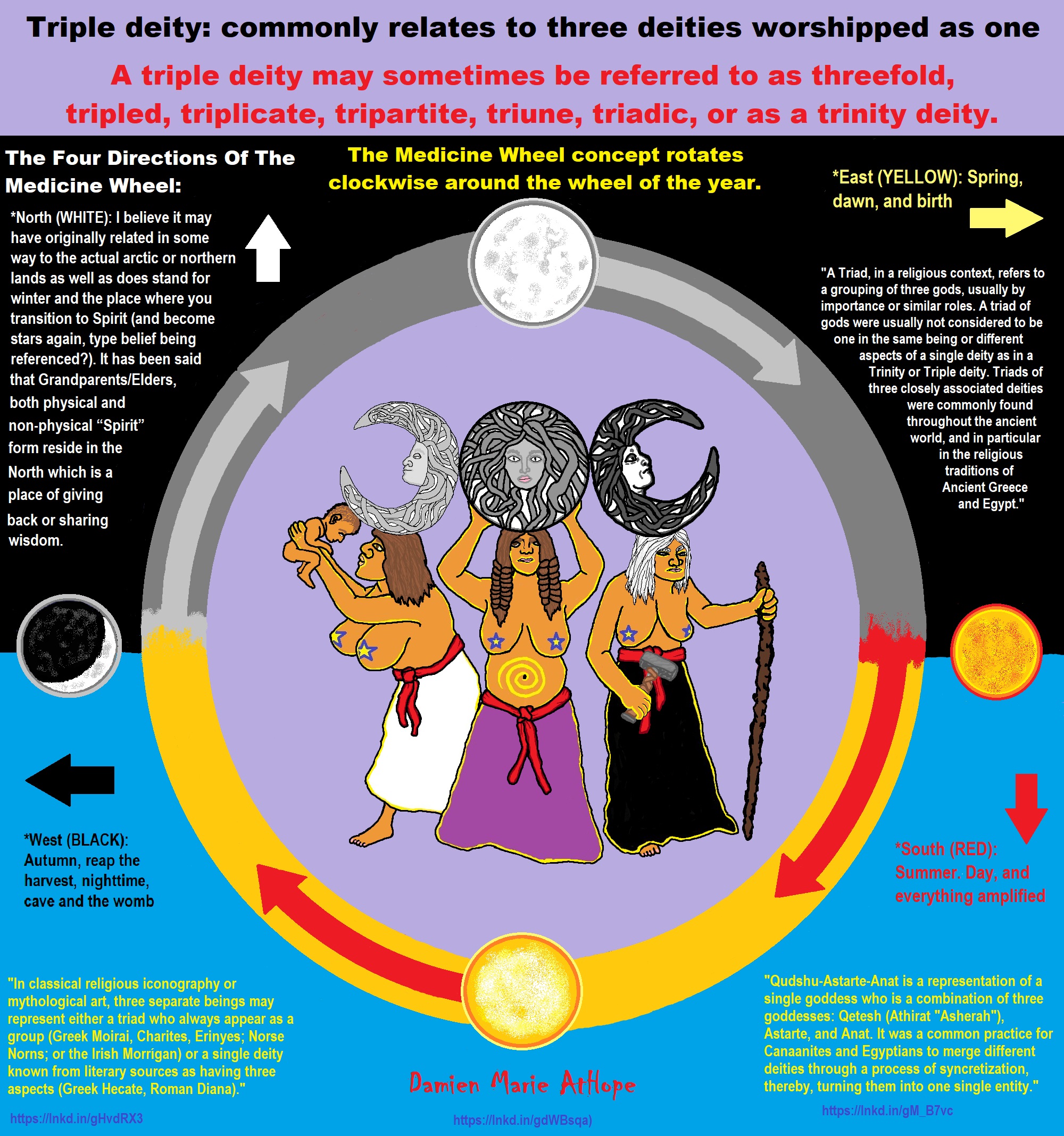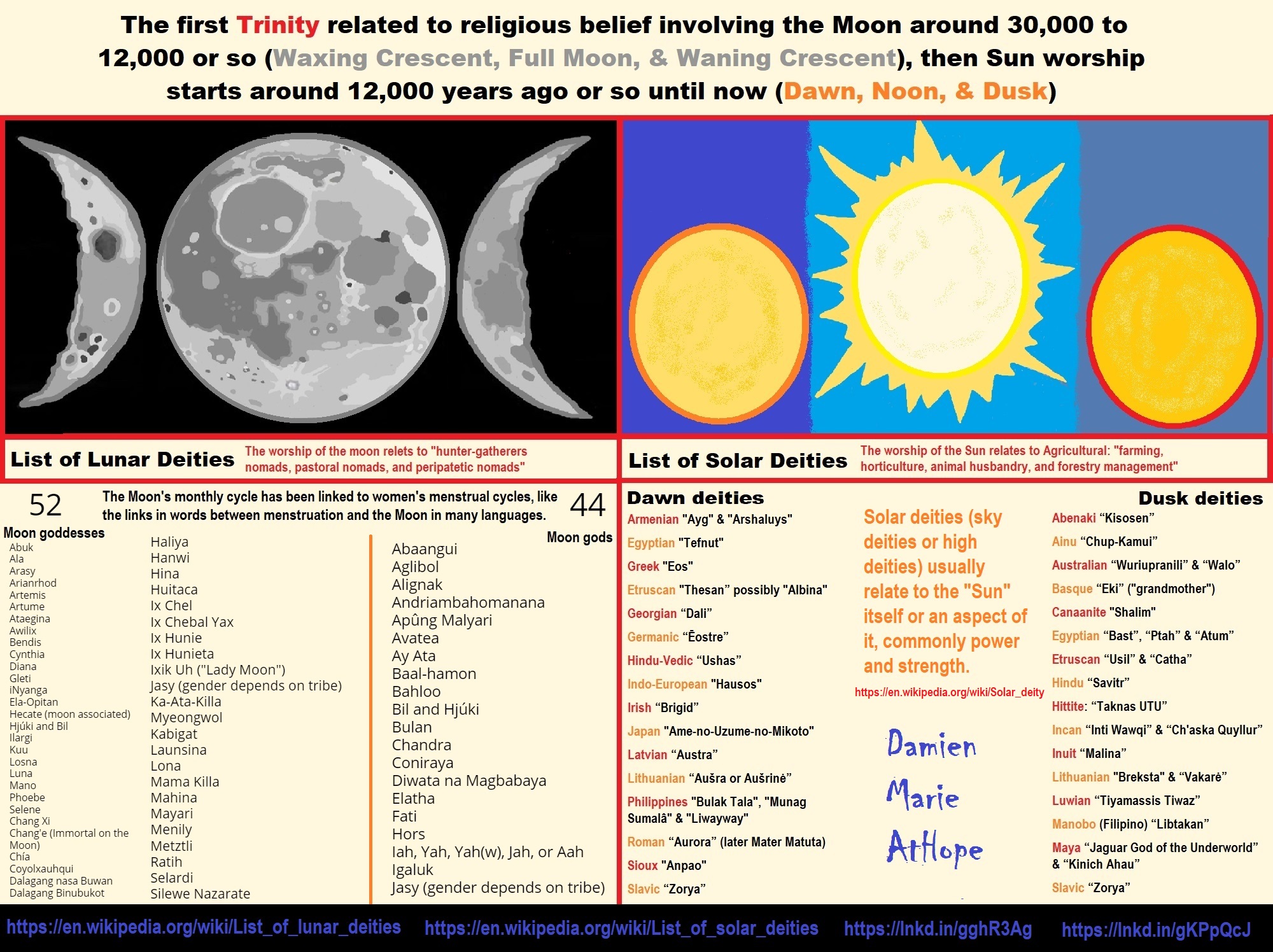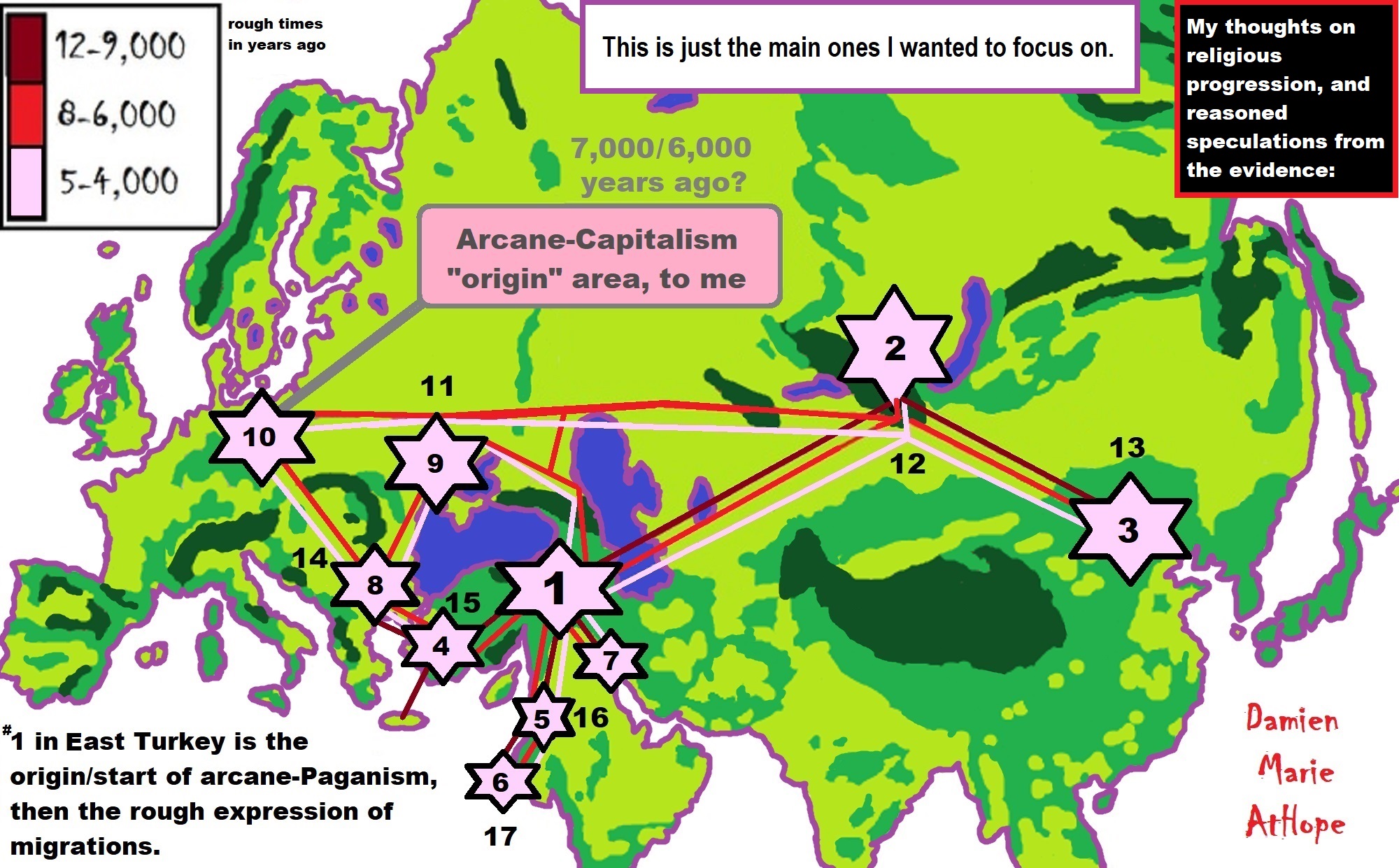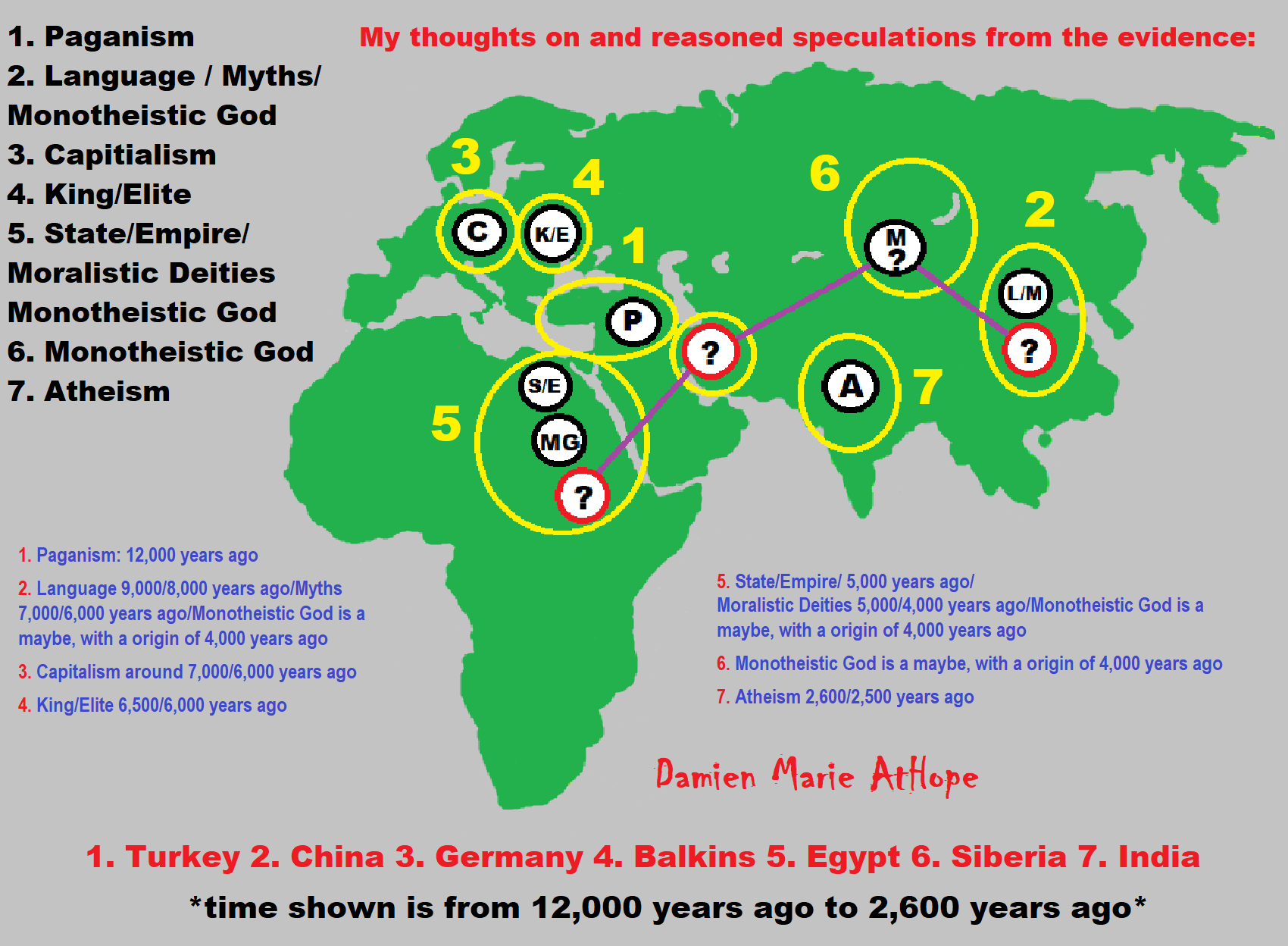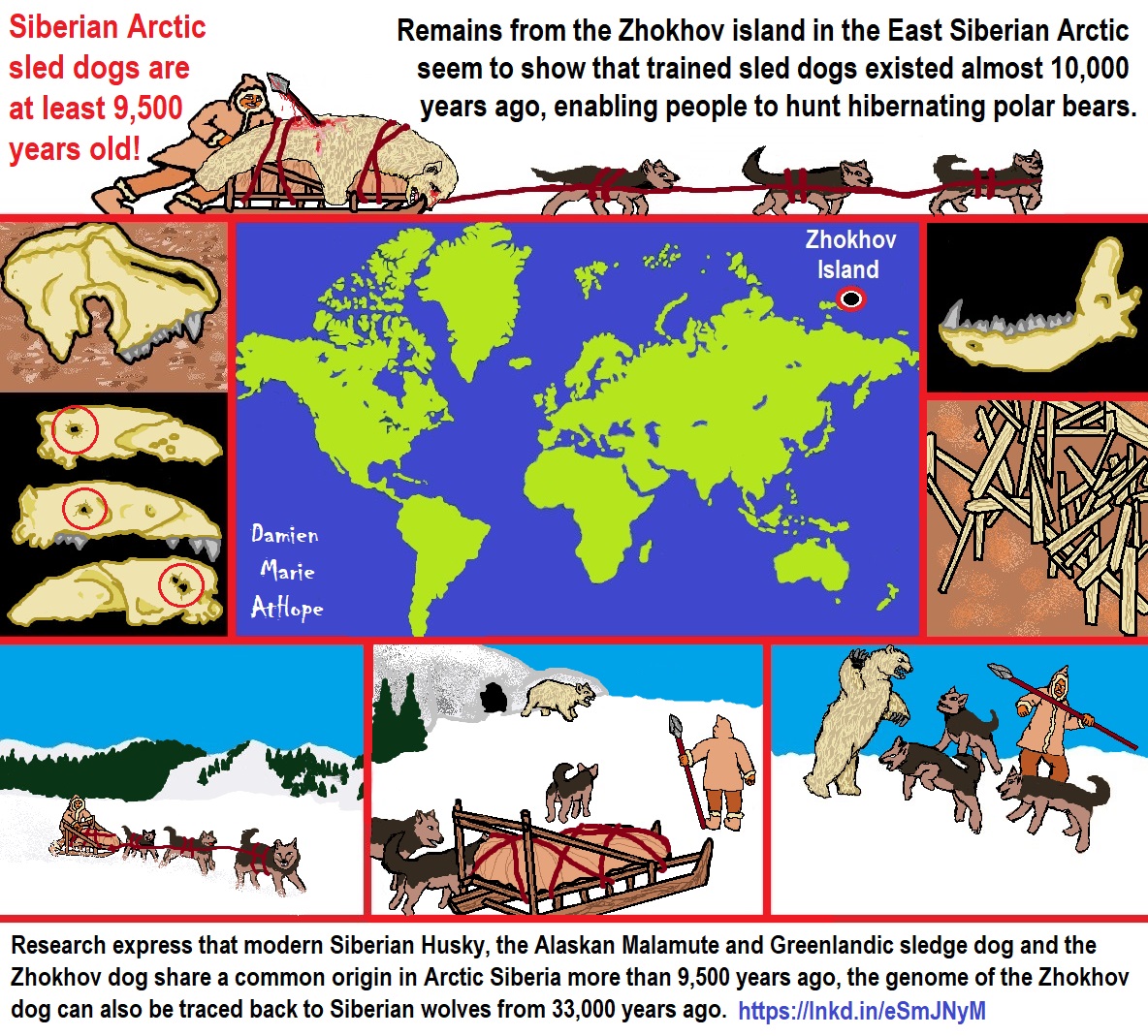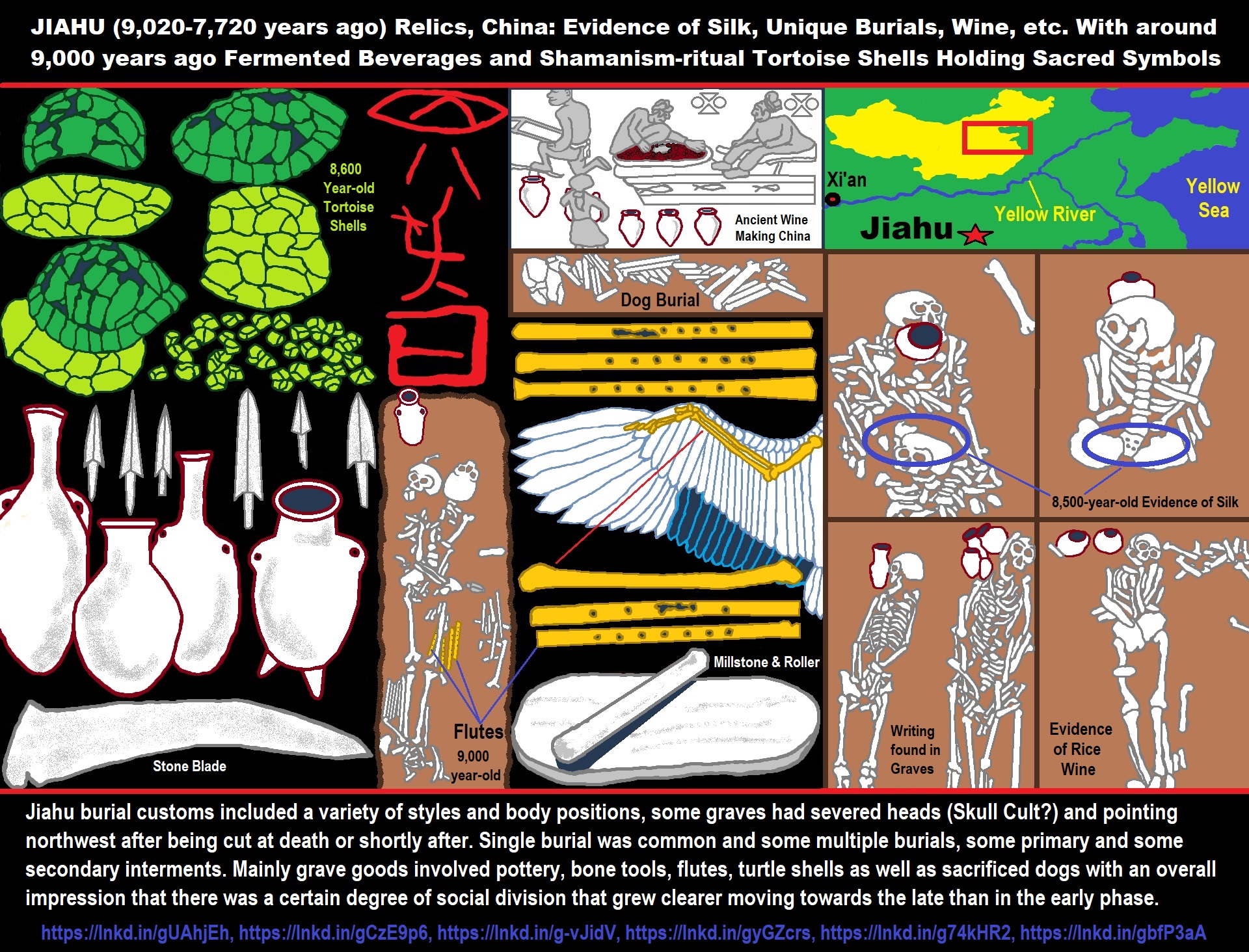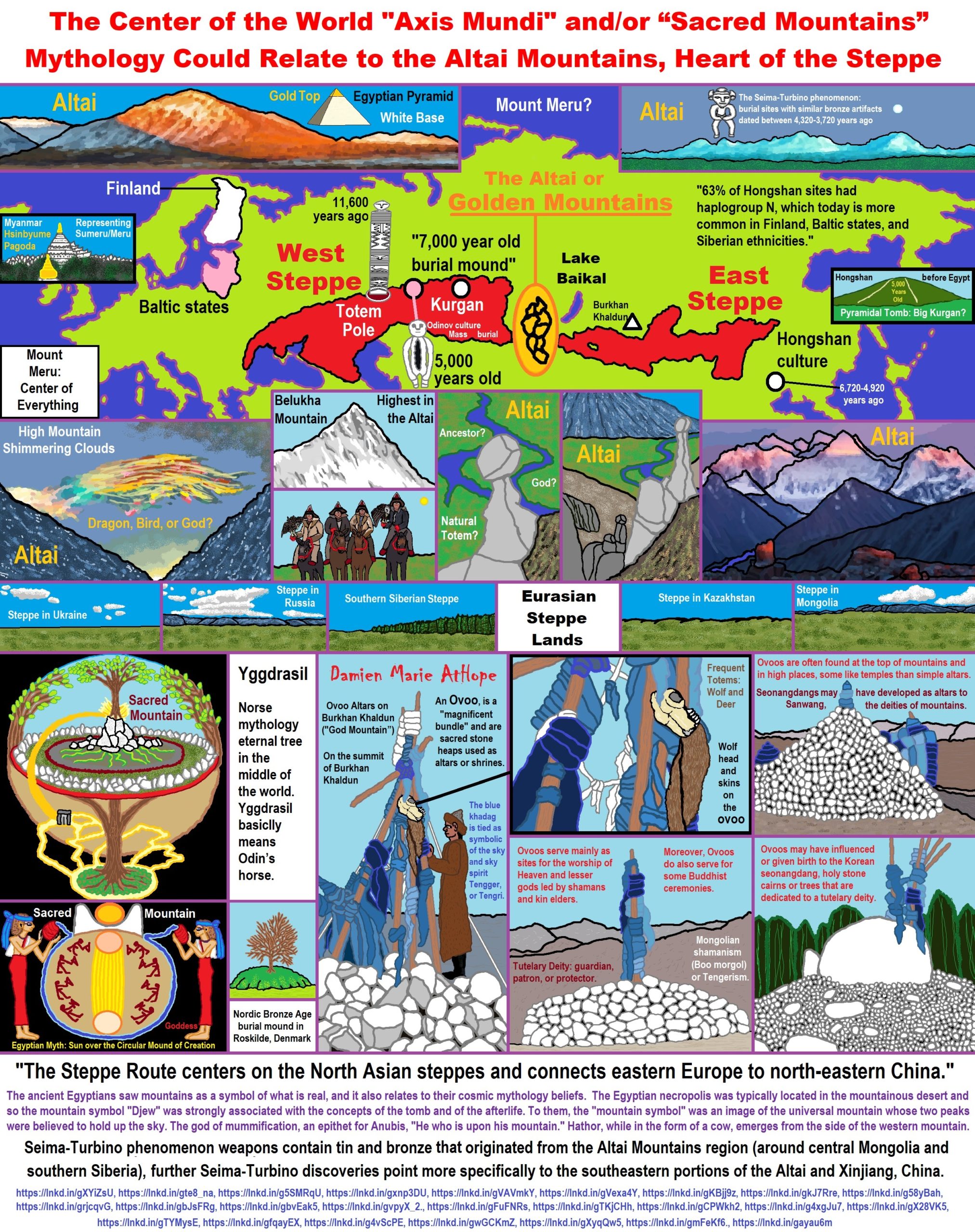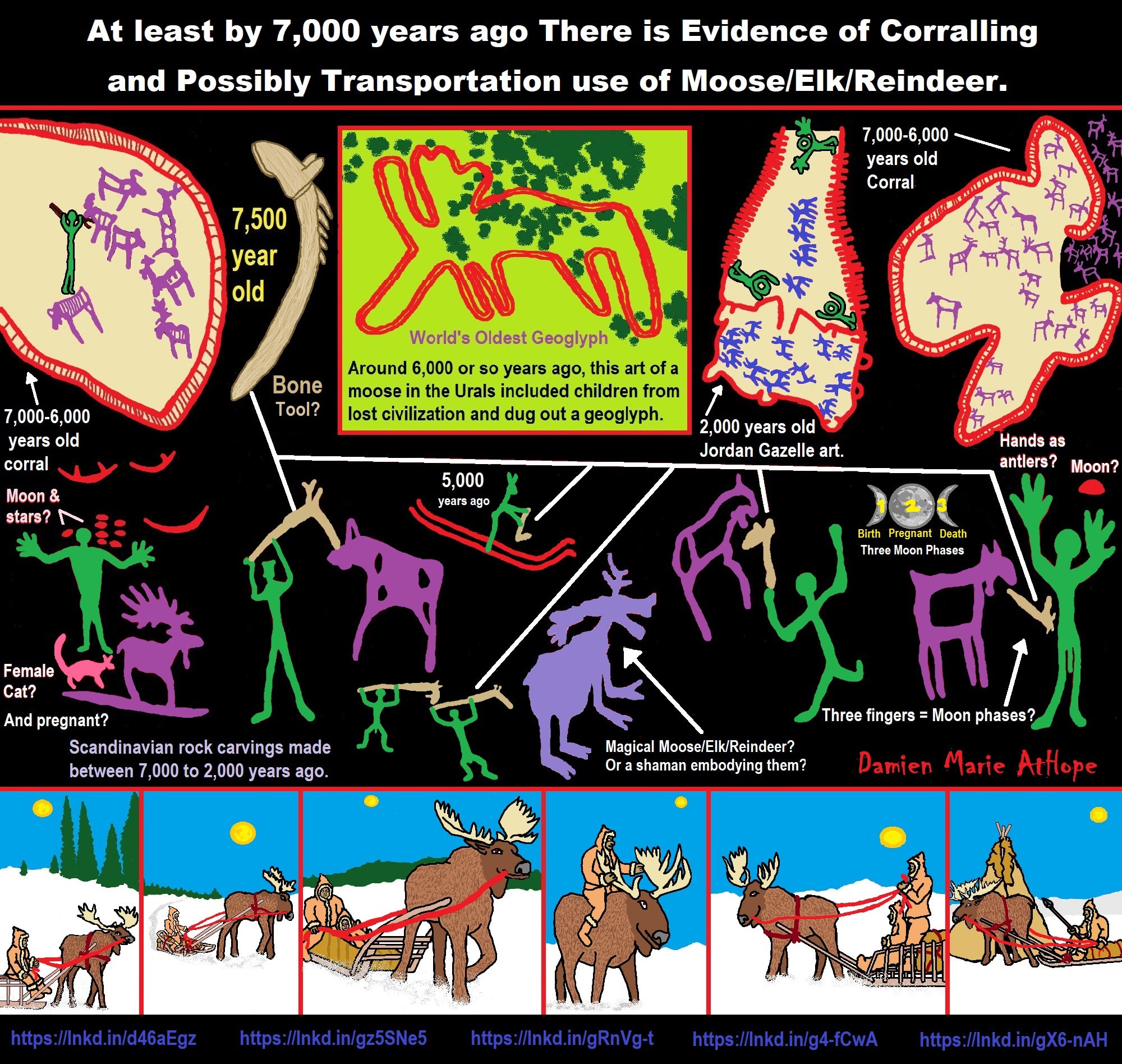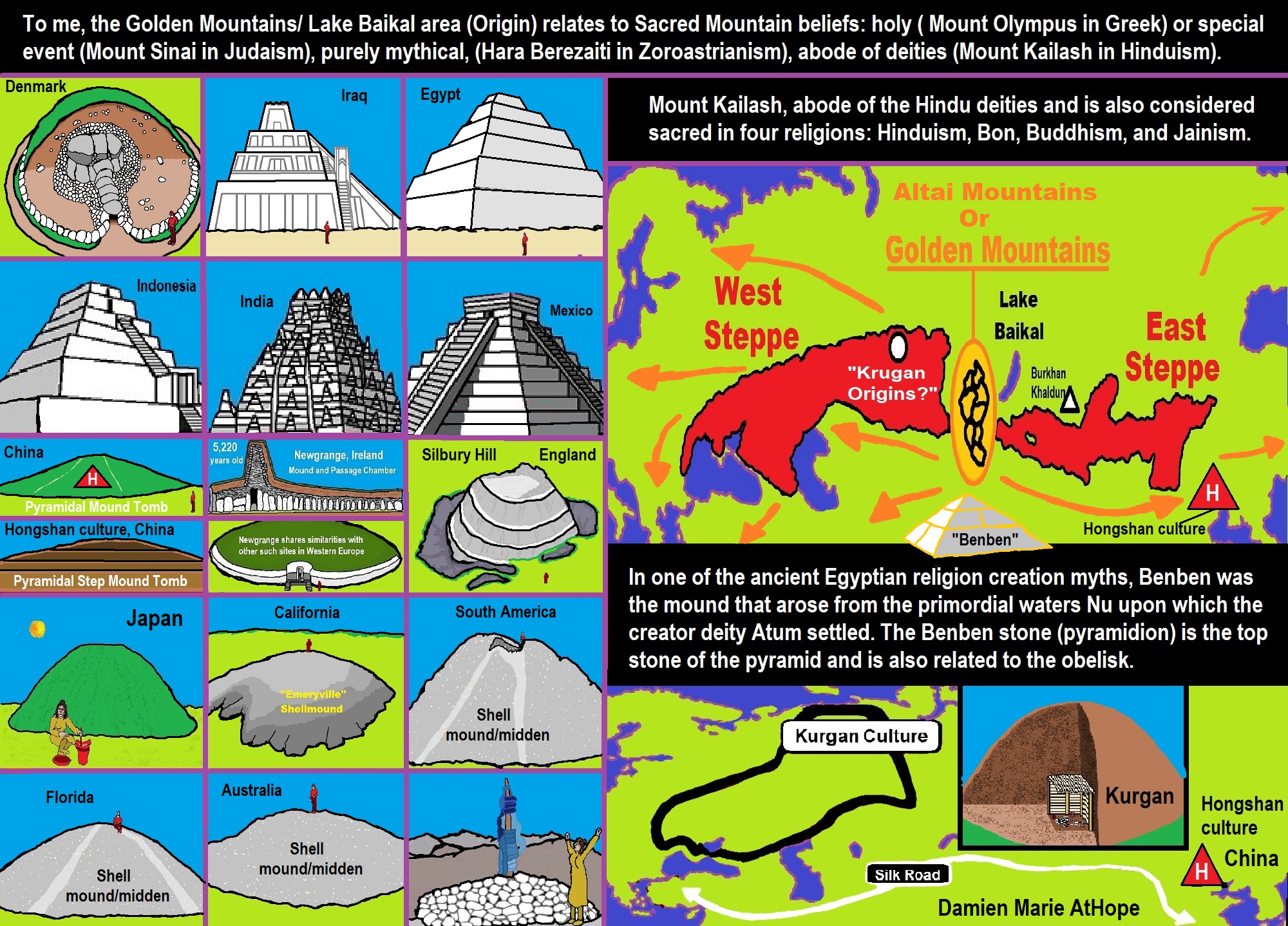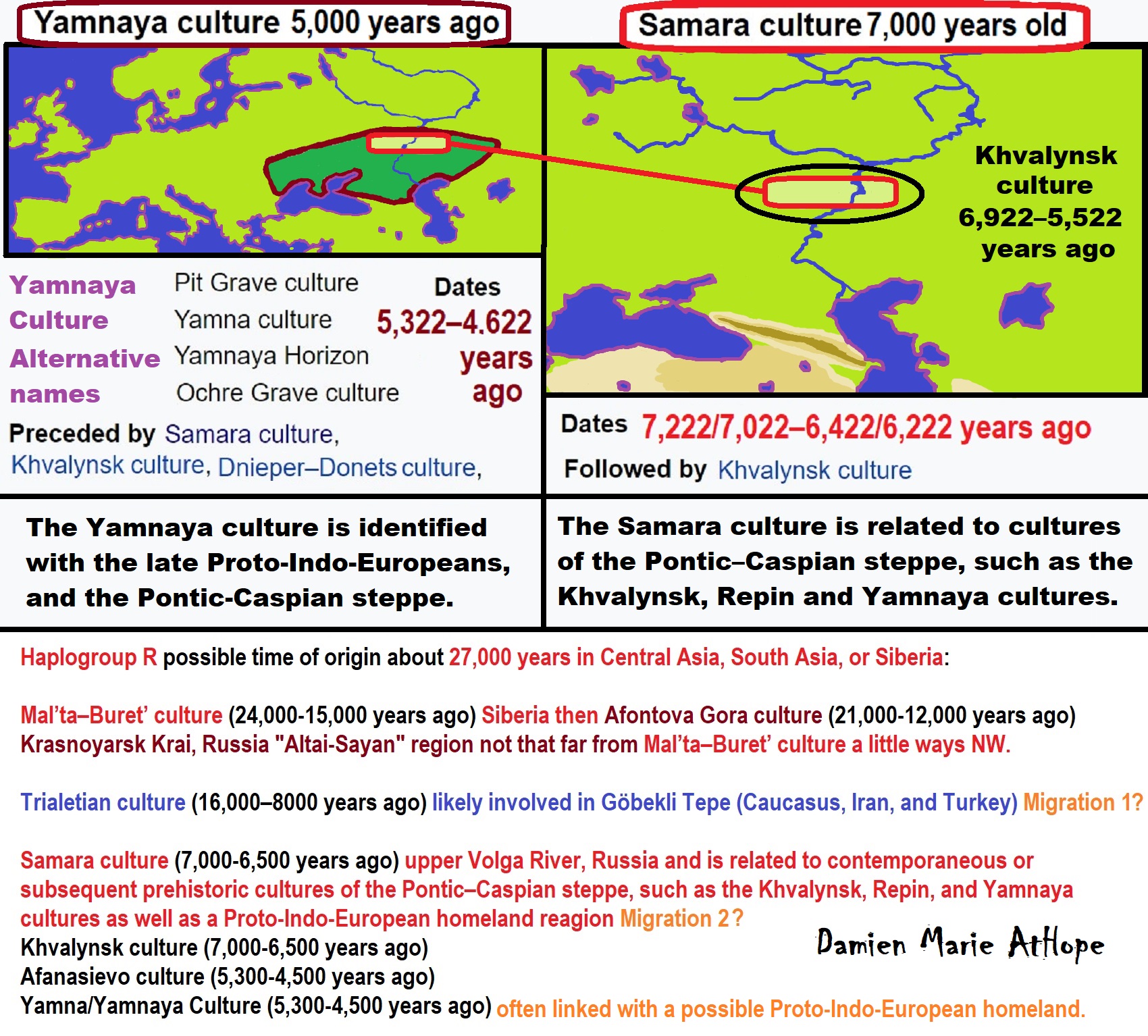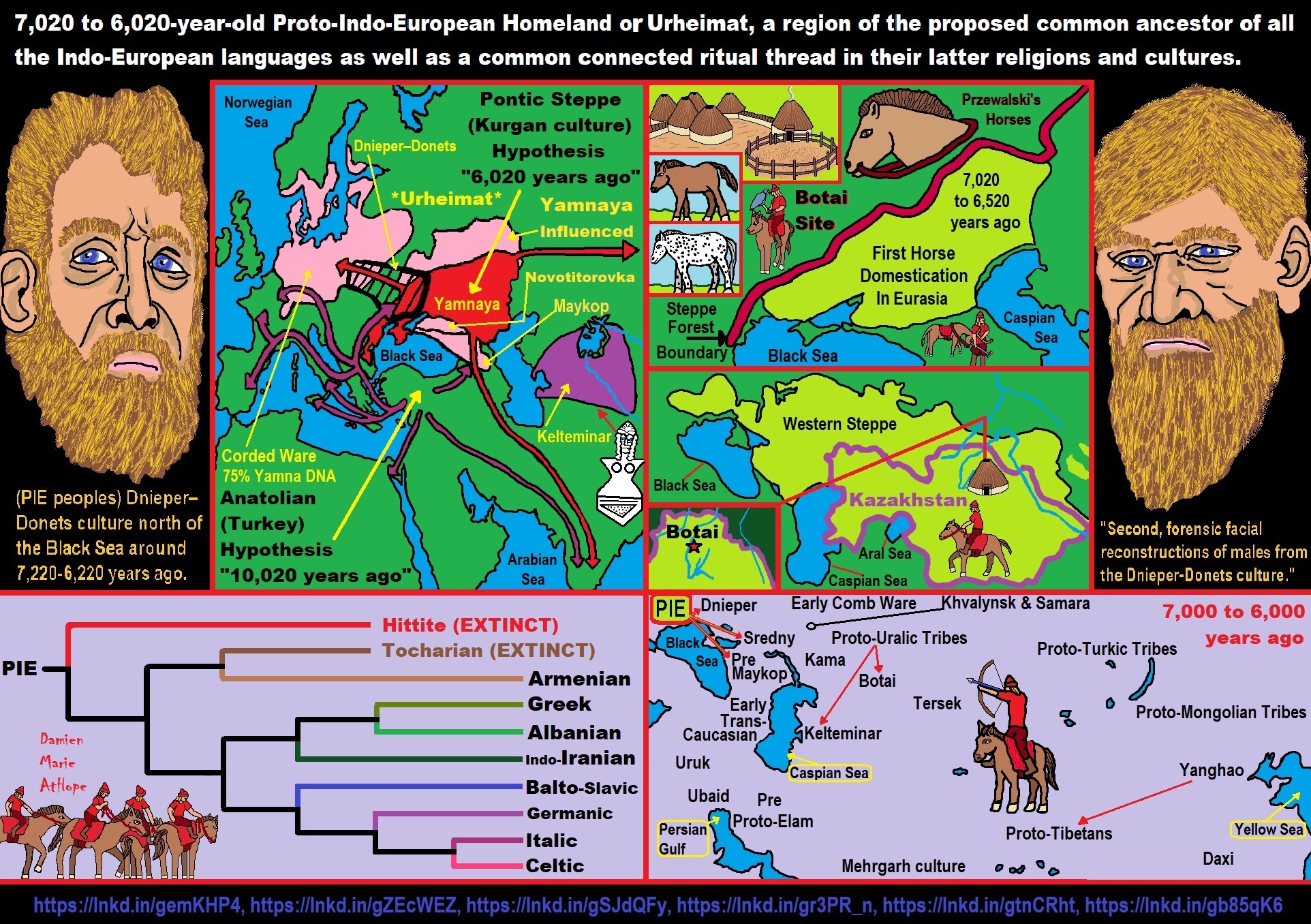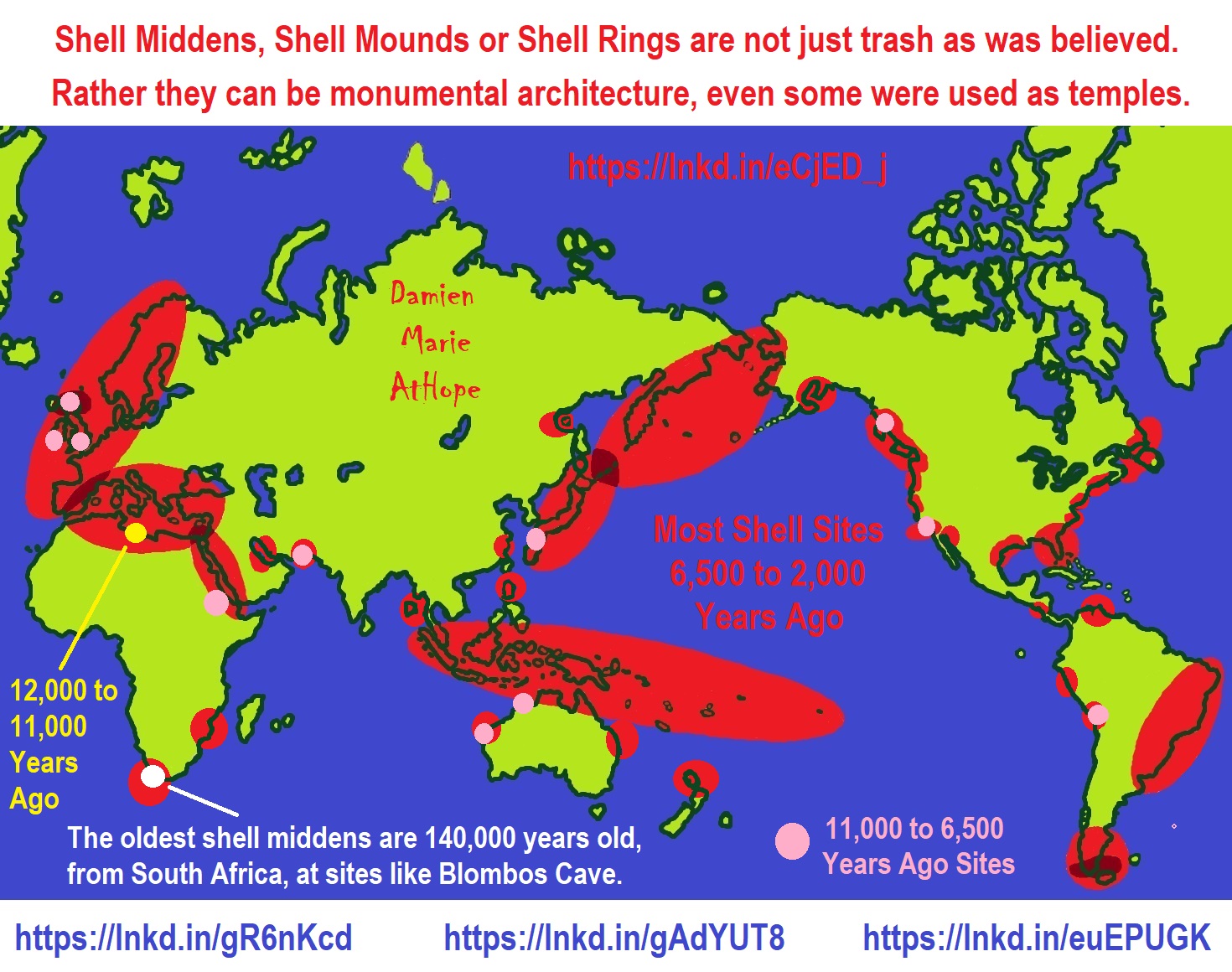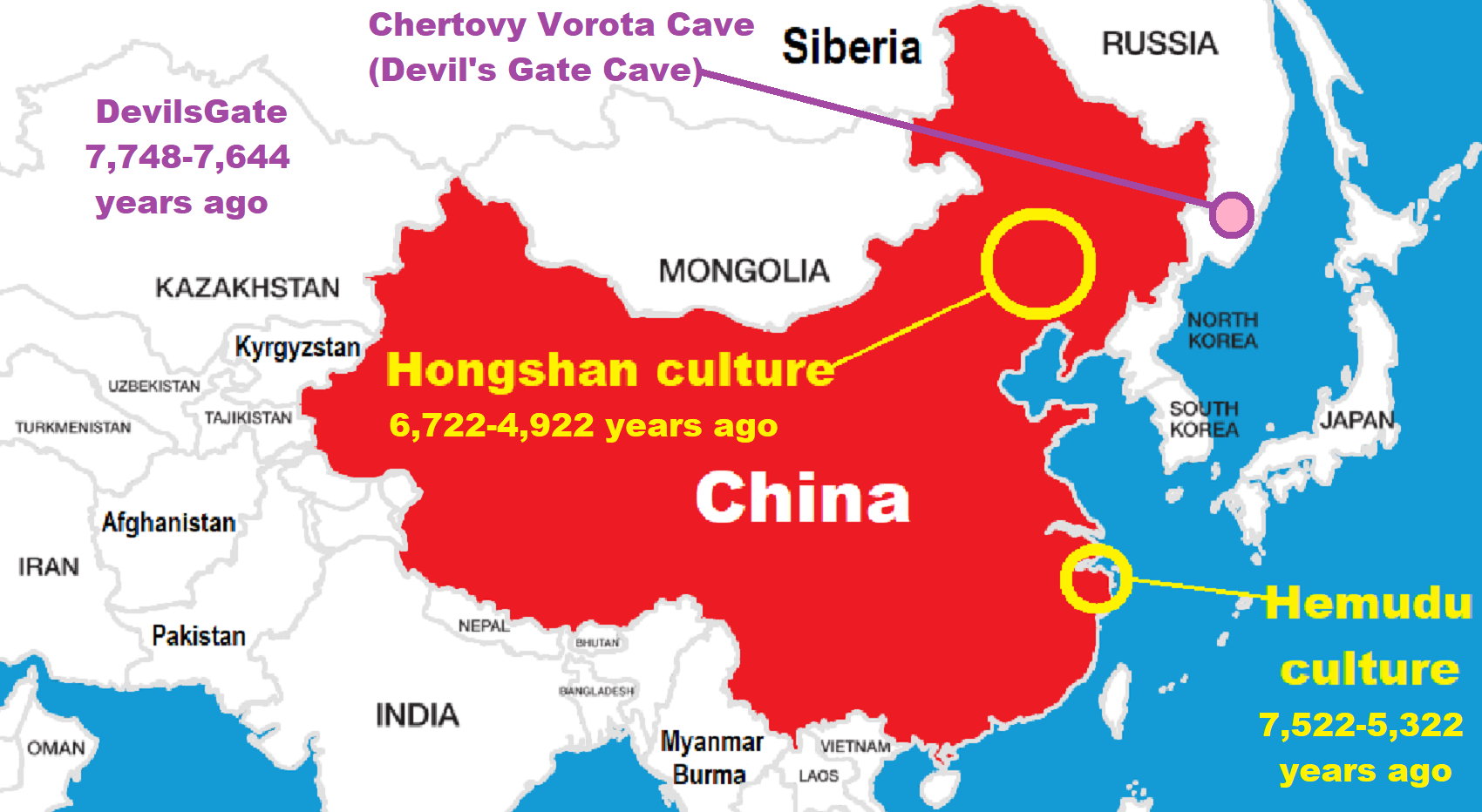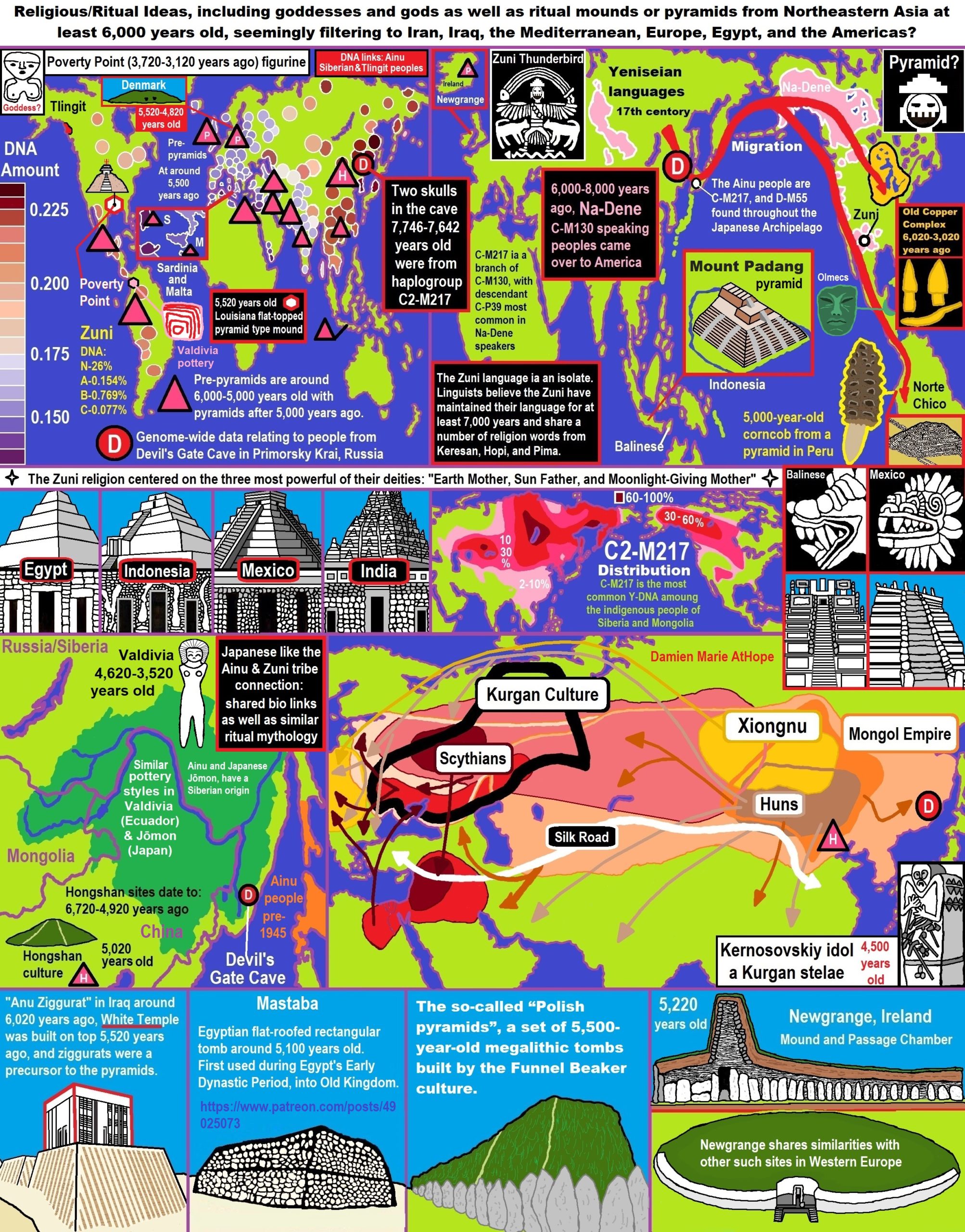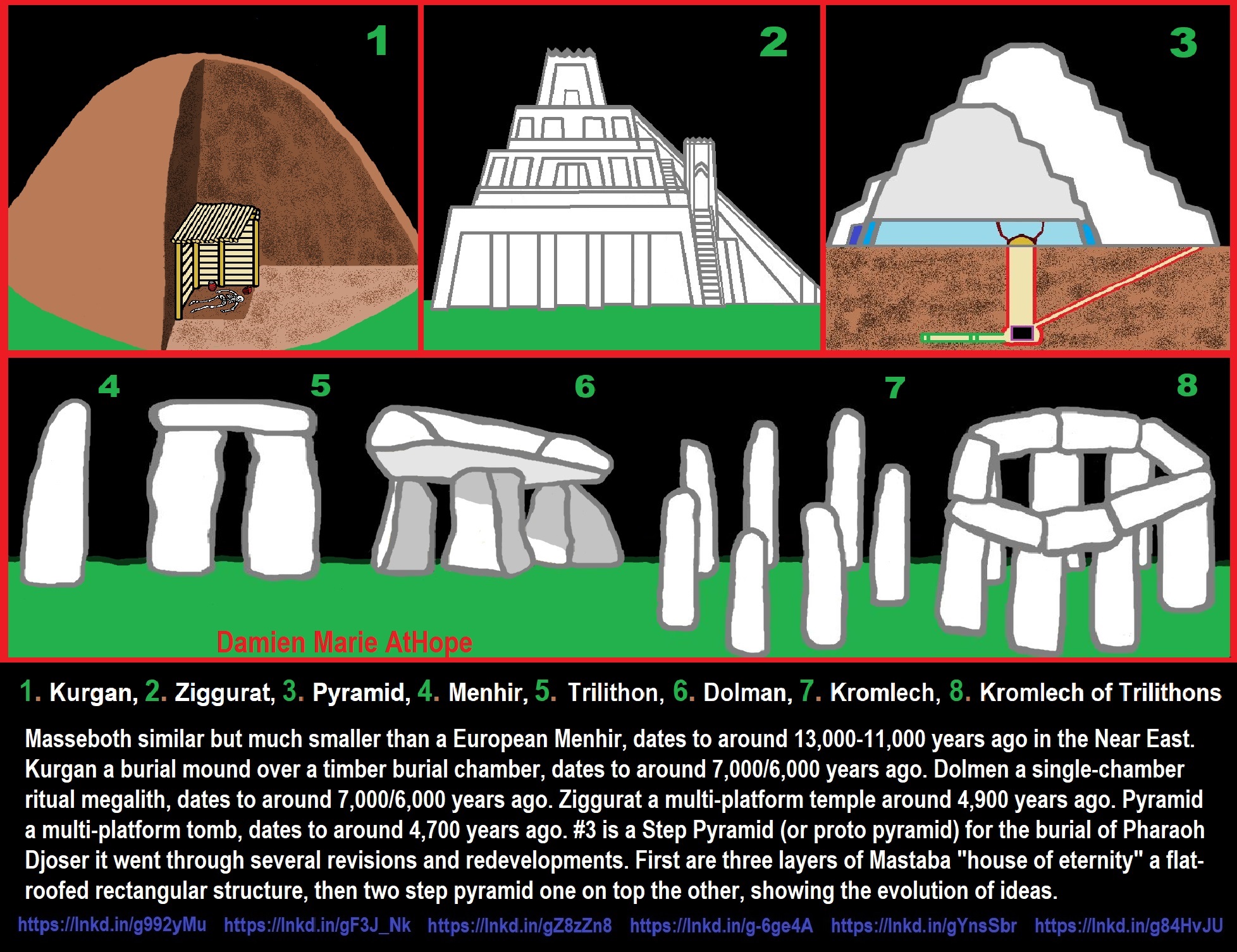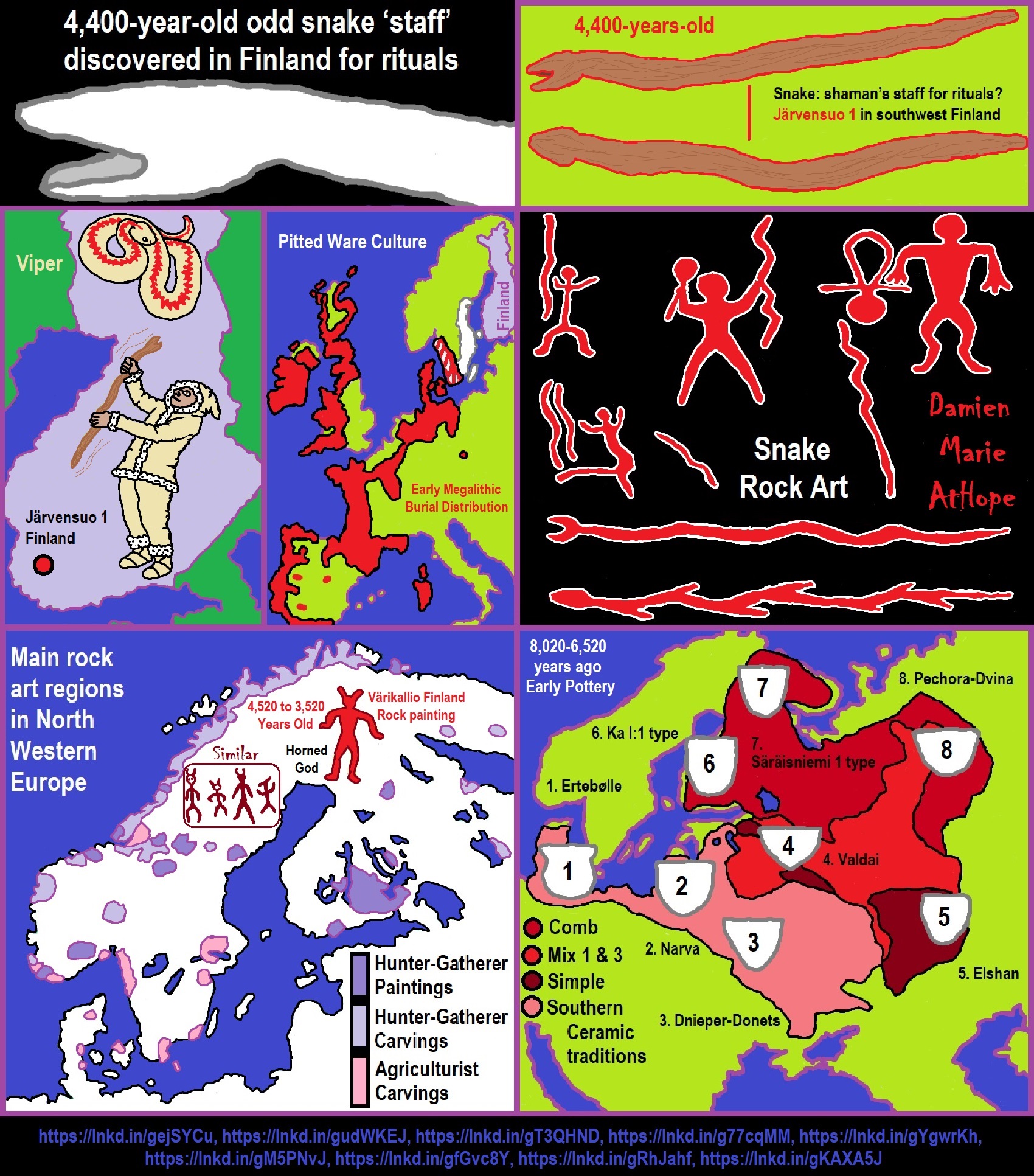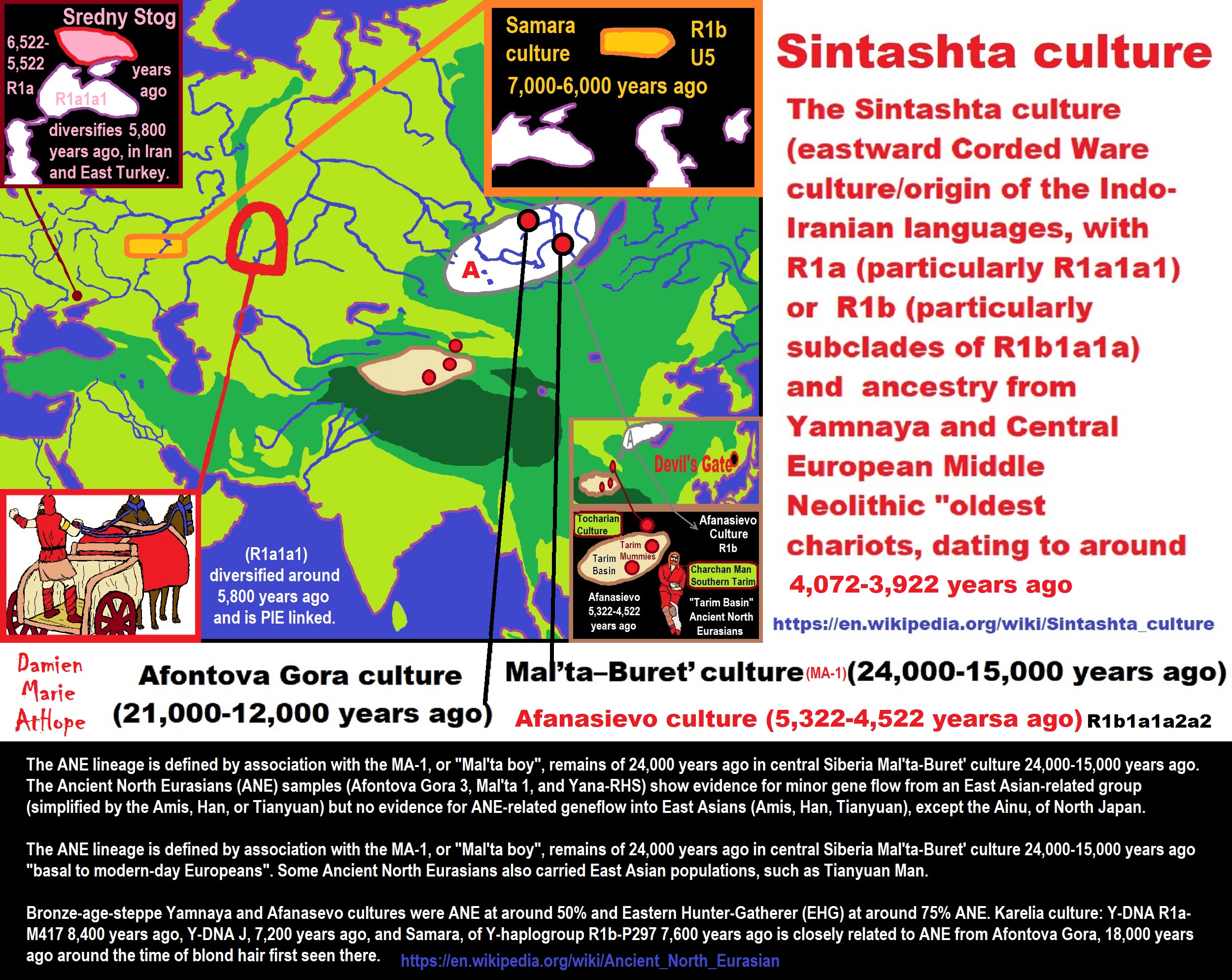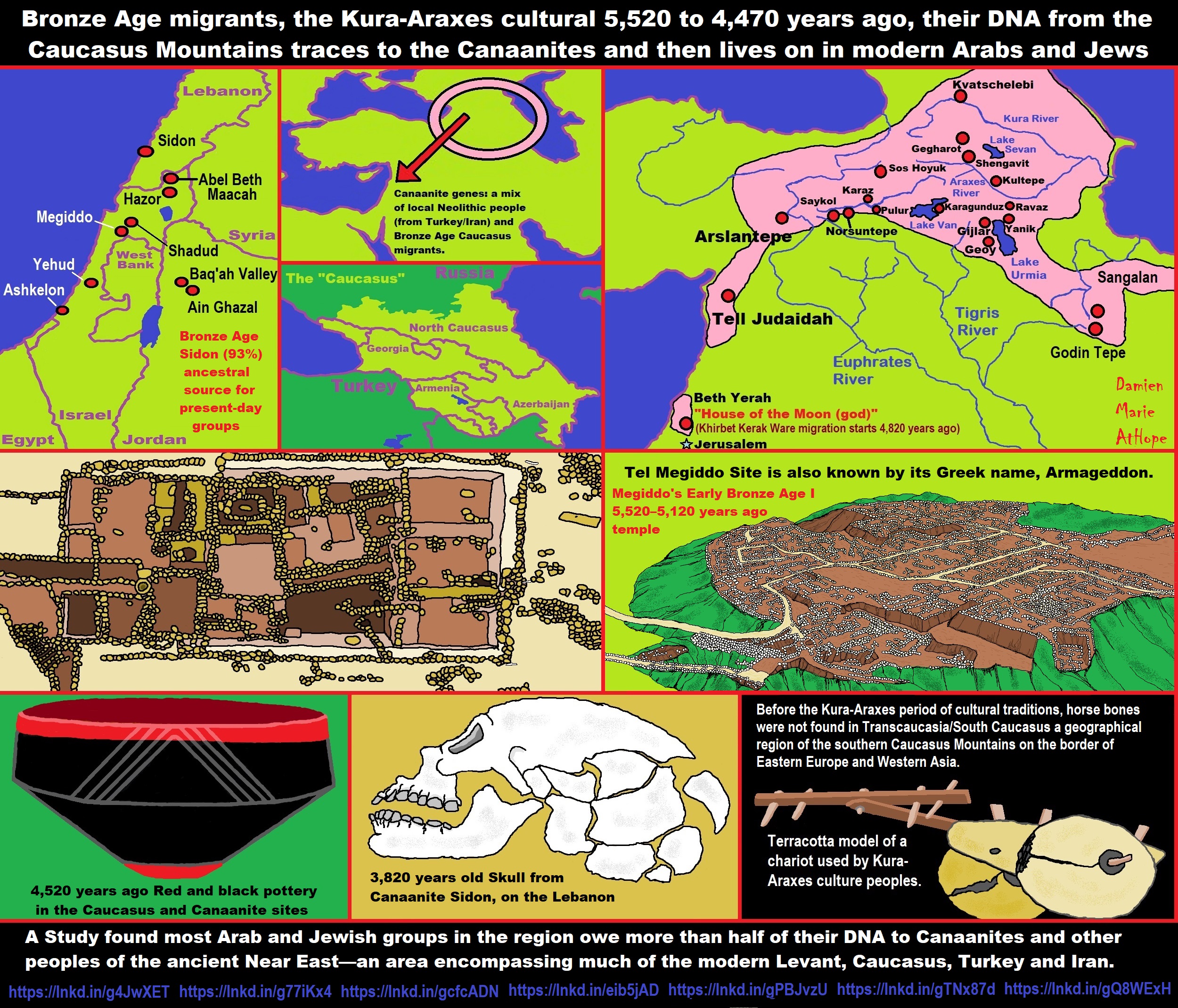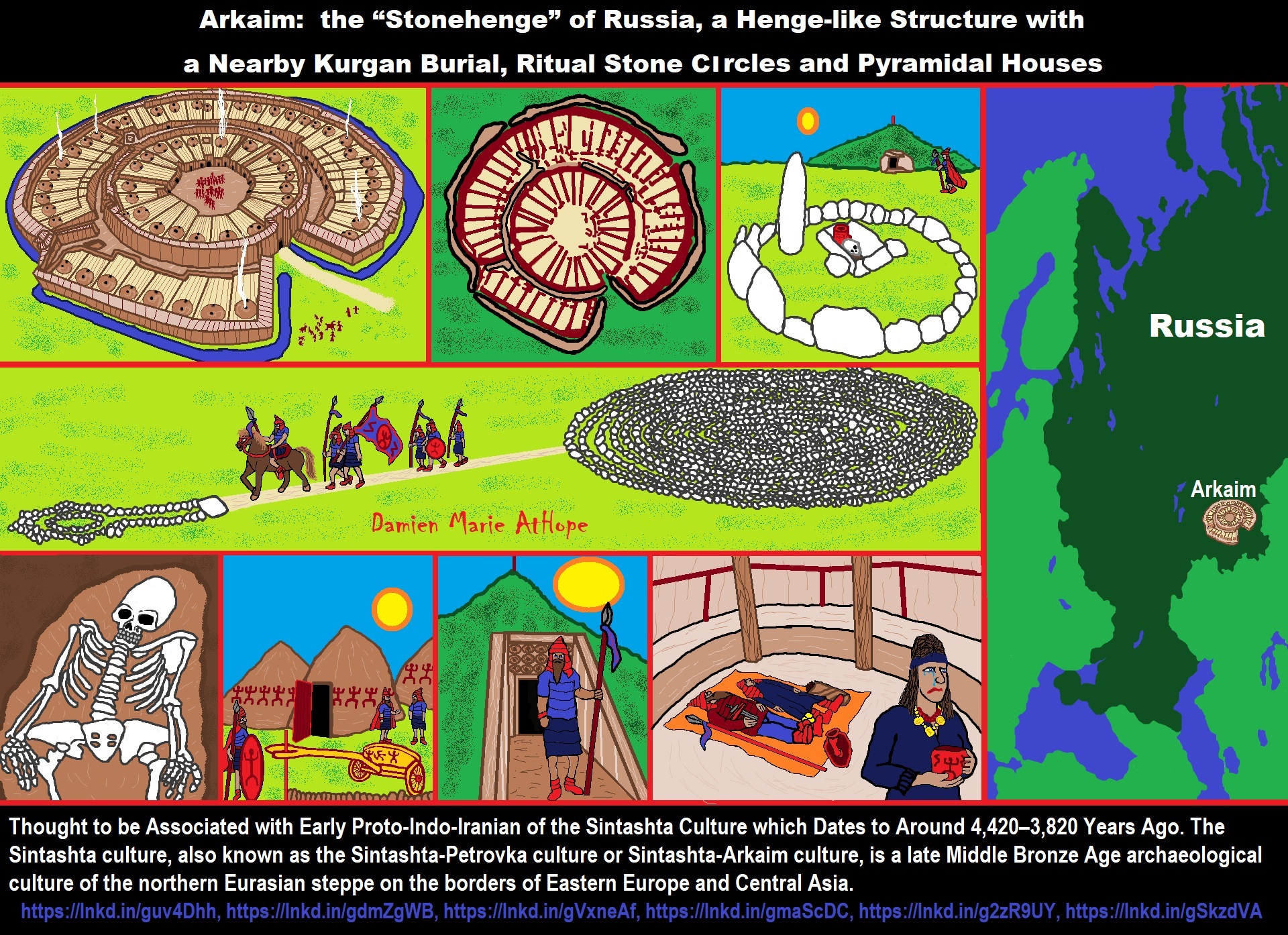
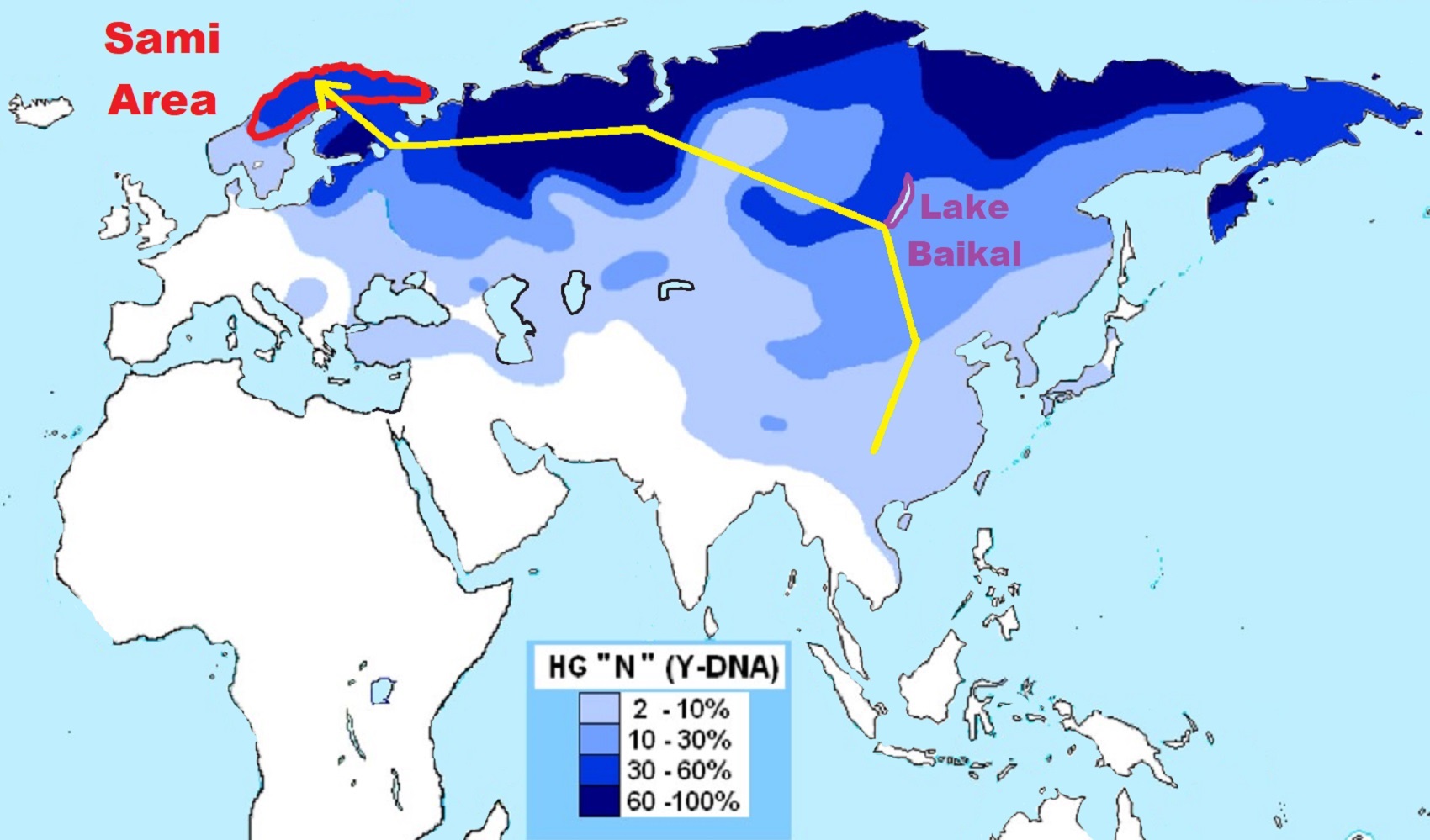
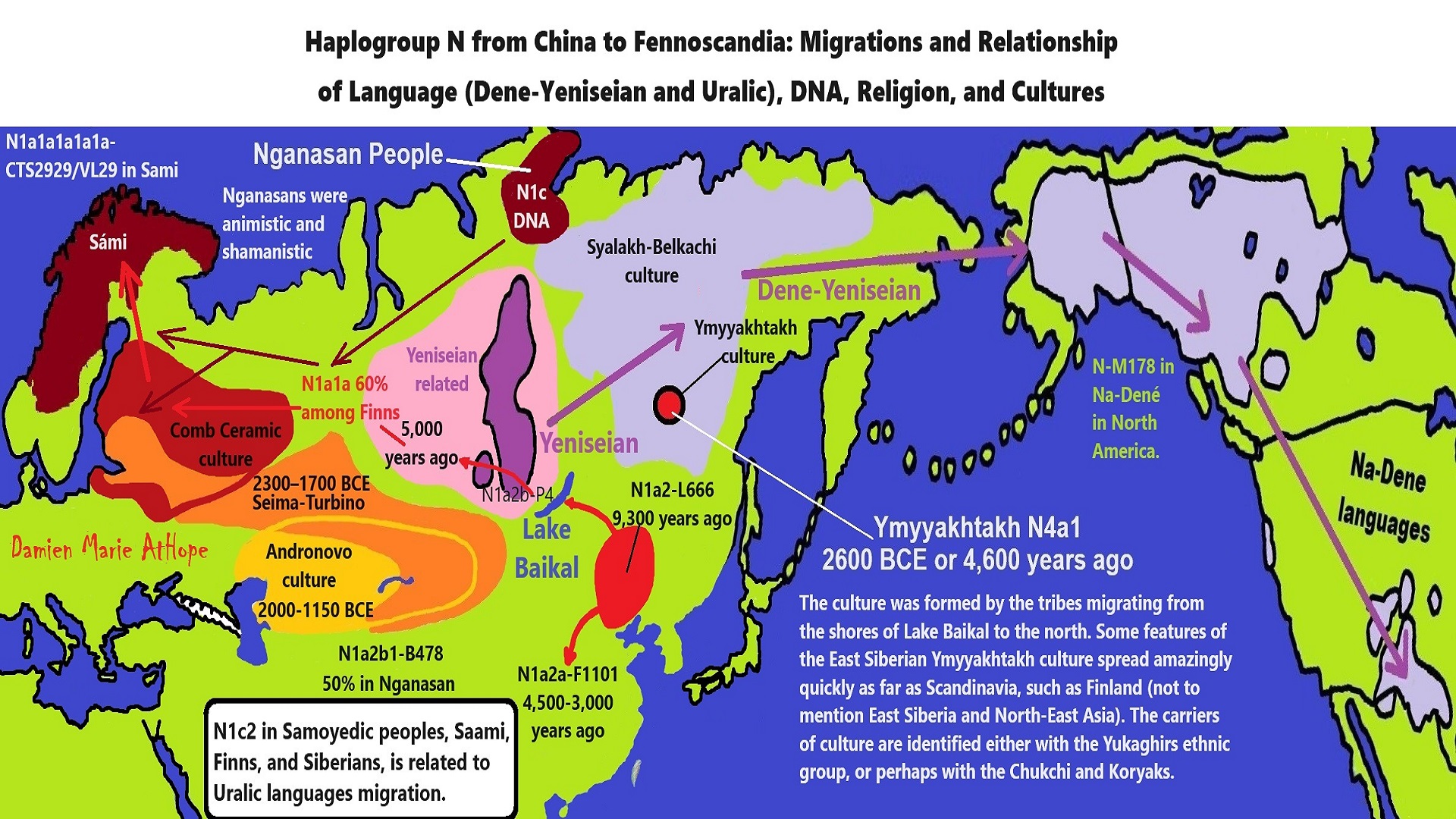
ref, ref, ref, ref, ref, ref, ref, ref, ref, ref, ref, ref, ref, ref, ref, ref
Postglacial genomes from foragers across Northern Eurasia reveal prehistoric
mobility associated with the spread of the Uralic and Yeniseian languages
Abstract
“The North Eurasian forest and forest-steppe zones have sustained millennia of sociocultural connections among northern peoples. We present genome-wide ancient DNA data for 181 individuals from this region spanning the Mesolithic, Neolithic, and Bronze Age. We find that Early to Mid-Holocene hunter-gatherer populations from across the southern forest and forest-steppes of Northern Eurasia can be characterized by a continuous gradient of ancestry that remained stable for millennia, ranging from fully West Eurasian in the Baltic region to fully East Asian in the Transbaikal region. In contrast, cotemporaneous groups in far Northeast Siberia were genetically distinct, retaining high levels of continuity from a population that was the primary source of ancestry for Native Americans. By the mid-Holocene, admixture between this early Northeastern Siberian population and groups from Inland East Asia and the Amur River Basin produced two distinctive populations in eastern Siberia that played an important role in the genetic formation of later people. Ancestry from the first population, Cis-Baikal Late Neolithic-Bronze Age (Cisbaikal_LNBA), is found substantially only among Yeniseian-speaking groups and those known to have admixed with them. Ancestry from the second, Yakutian Late Neolithic-Bronze Age (Yakutia_LNBA), is strongly associated with present-day Uralic speakers. We show how Yakutia_LNBA ancestry spread from an east Siberian origin ~4.5kya, along with subclades of Y-chromosome haplogroup N occurring at high frequencies among present-day Uralic speakers, into Western and Central Siberia in communities associated with Seima-Turbino metallurgy: a suite of advanced bronze casting techniques that spread explosively across an enormous region of Northern Eurasia ~4.0kya. However, the ancestry of the 16 Seima-Turbino-period individuals–the first reported from sites with this metallurgy–was otherwise extraordinarily diverse, with partial descent from Indo-Iranian-speaking pastoralists and multiple hunter-gatherer populations from widely separated regions of Eurasia. Our results provide support for theories suggesting that early Uralic speakers at the beginning of their westward dispersal where involved in the expansion of Seima-Turbino metallurgical traditions, and suggests that both cultural transmission and migration were important in the spread of Seima-Turbino material culture.” ref
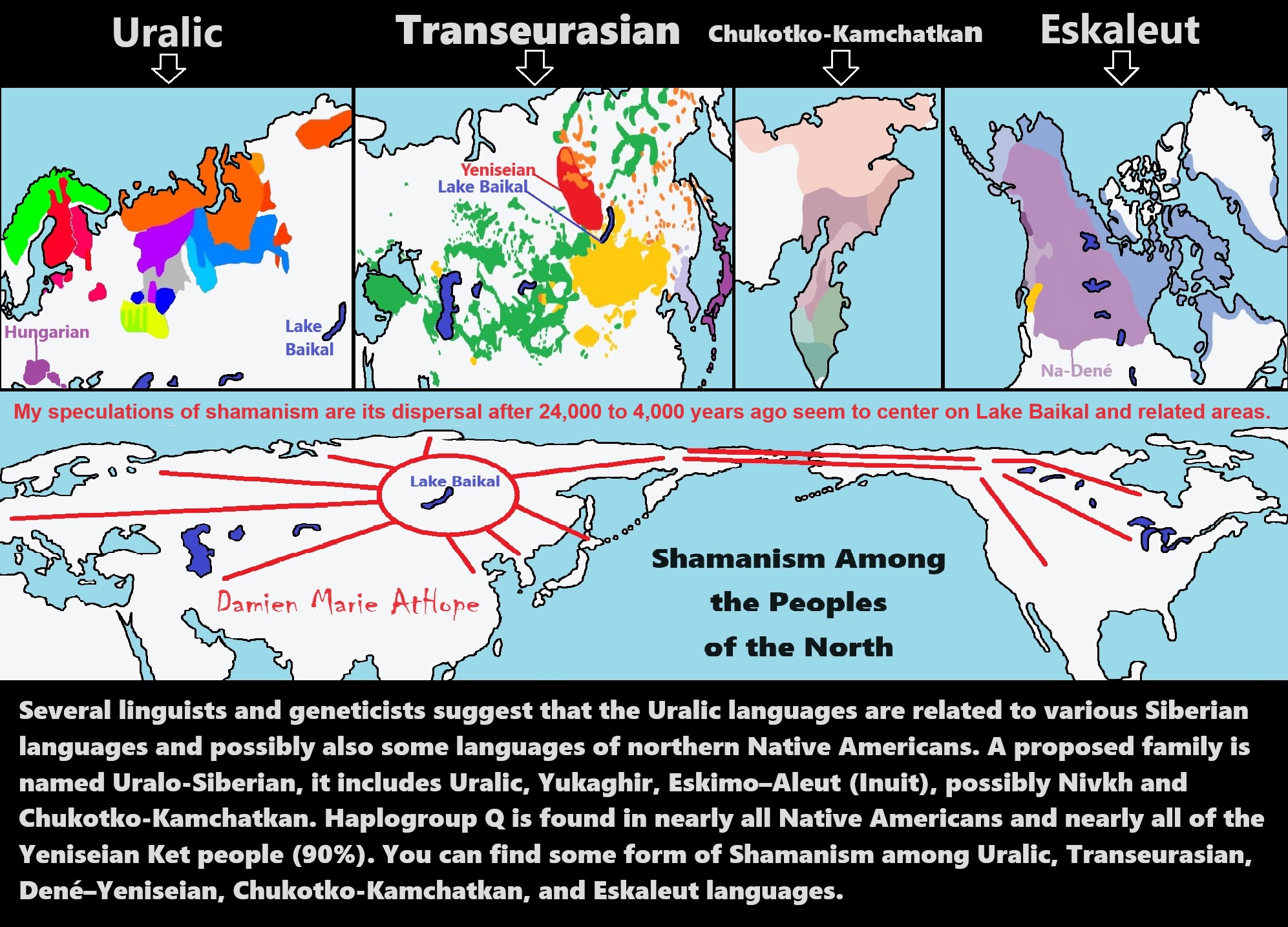
ref, ref, ref, ref, ref, ref, ref, ref, ref
“Several linguists and geneticists suggest that the Uralic languages are related to various Siberian languages and possibly also some languages of northern Native Americans. A proposed family is named Uralo-Siberian, it includes Uralic, Yukaghir, Eskimo–Aleut (Inuit), possibly Nivkh, and Chukotko-Kamchatkan. Haplogroup Q is found in nearly all Native Americans and nearly all of the Yeniseian Ket people (90%).” ref, ref
You can find some form of Shamanism, among Uralic, Transeurasian, Dené–Yeniseian, Chukotko-Kamchatkan, and Eskaleut languages.
My speculations of shamanism are its dispersals, after 24,000 to 4,000 years ago, seem to center on Lake Baikal and related areas. To me, the hotspot of Shamanism goes from west of Lake Baikal in the “Altai Mountains” also encompassing “Lake Baikal” and includes the “Amur Region/Watershed” east of Lake Baikal as the main location Shamanism seems to have radiated out from.

Groups partially derived from the Ancient North Eurasians
Trinity Evolution Started over 30,000 years ago, Maybe?
My Thoughts on Possible Migrations of “R” DNA and Proto-Indo-European?
Sifting through the relation of Bird spirits/deities of the sky (20,000 to 5,000 years ago)
Are the Natufians of Israel around 15,000 to 11,500 years ago who you thought they were?
Ideas, Technology and People from Turkey, Europe, to China and Back again 9,000 to 5,000 years ago?
Crecganford @crecganford offers history & stories of the people, places, gods, & culture
Mythology, a Lunar Deity is a Goddess or God of the Moon
Horse Worship/Sacrifice: mythical union of Ruling Elite/Kingship and the Horse
Myths and Folklore: “Trickster gods and goddesses”
Sacred Shit and Sacred Animals?
“Dené–Yeniseian language, Old Copper Complex, and Pre-Columbian Mound Builders?
Sacred Mounds, Mountains, Kurgans, and Pyramids may hold deep connections?
Sacred Land, Hills, and Mountains: Sami Mythology (Paganistic Shamanism)
Sami and the Northern Indigenous Peoples Landscape, Language, and its Connection to Religion
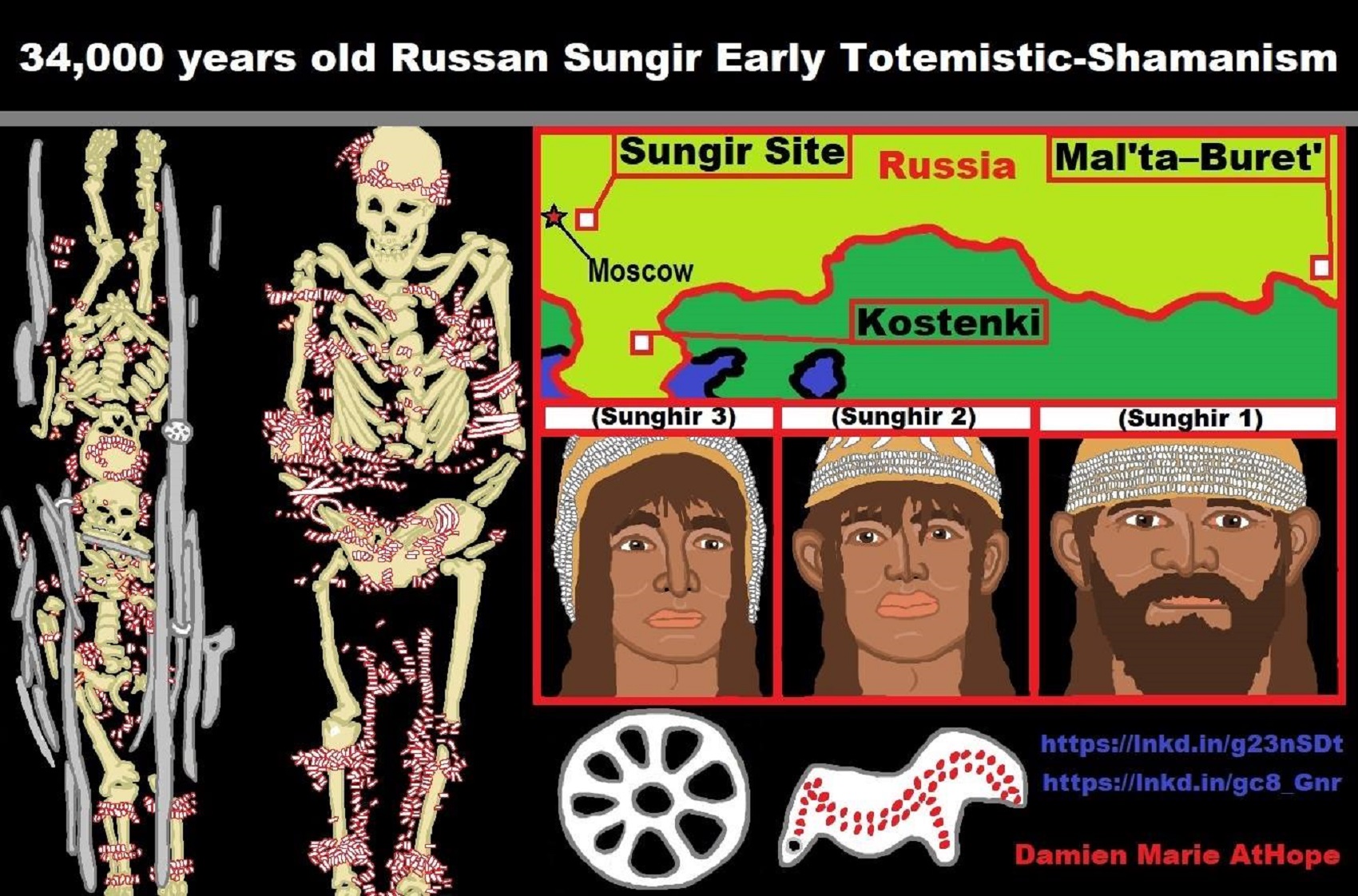
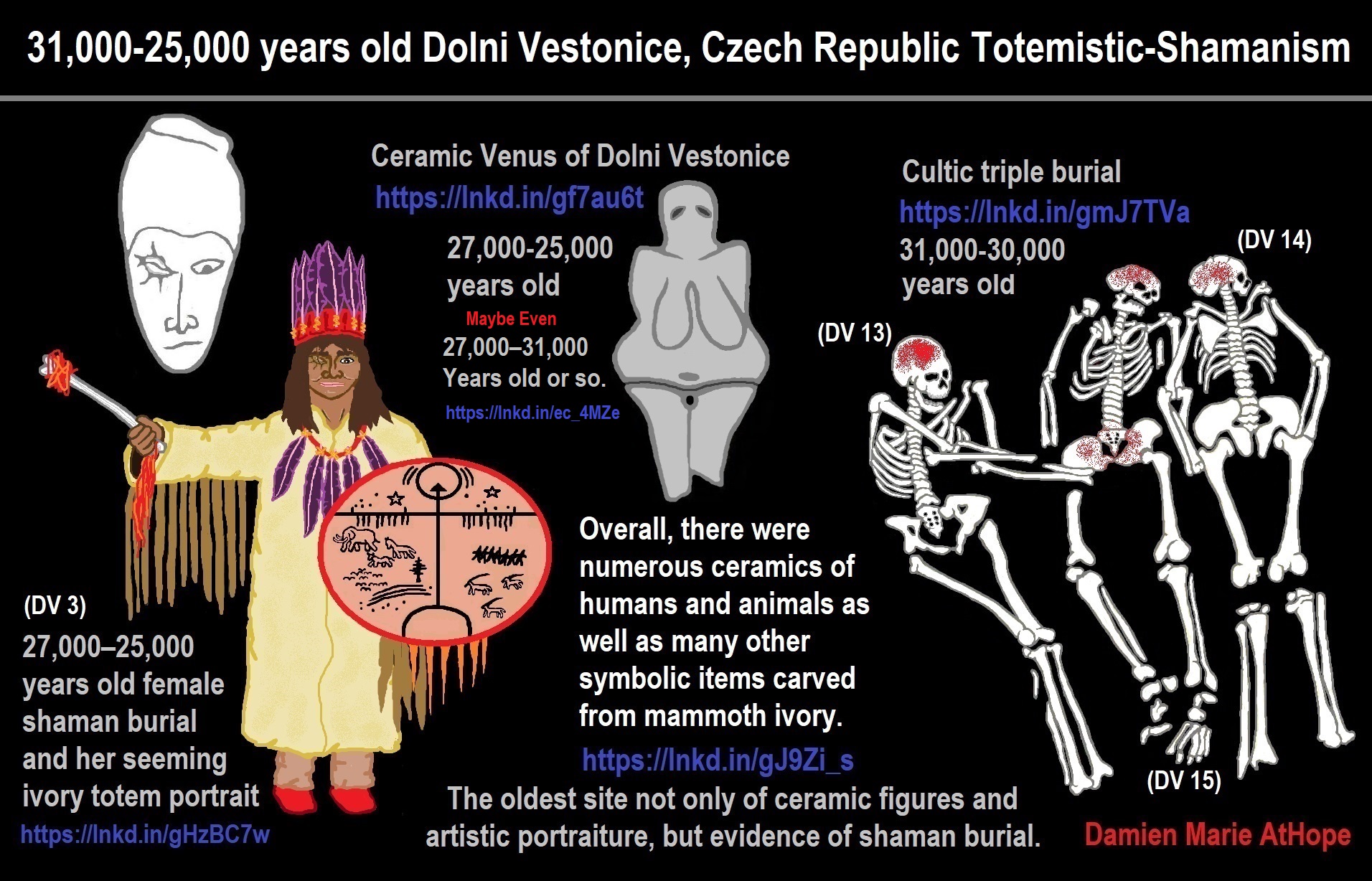
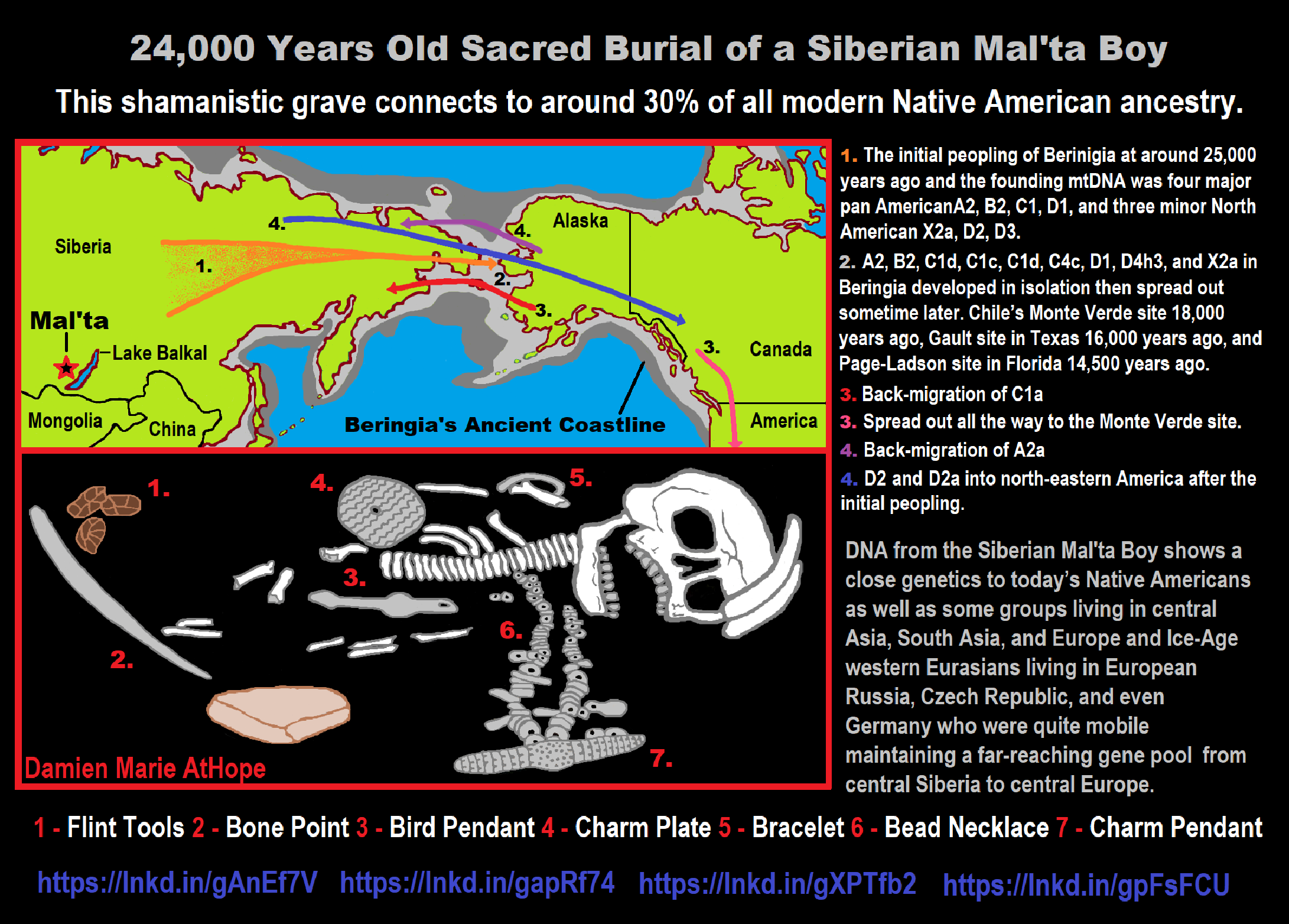
“The ANE lineage is defined by association with the MA-1, or “Mal’ta boy”, remains of 24,000 years ago in central Siberia Mal’ta-Buret’ culture 24,000-15,000 years ago. The Ancient North Eurasians (ANE) samples (Afontova Gora 3, Mal’ta 1, and Yana-RHS) show evidence for minor gene flow from an East Asian-related group (simplified by the Amis, Han, or Tianyuan) but no evidence for ANE-related geneflow into East Asians (Amis, Han, Tianyuan), except the Ainu, of North Japan.” ref
“The ANE lineage is defined by association with the MA-1, or “Mal’ta boy”, remains of 24,000 years ago in central Siberia Mal’ta-Buret’ culture 24,000-15,000 years ago “basal to modern-day Europeans”. Some Ancient North Eurasians also carried East Asian populations, such as Tianyuan Man.” ref
“Bronze-age-steppe Yamnaya and Afanasevo cultures were ANE at around 50% and Eastern Hunter-Gatherer (EHG) at around 75% ANE. Karelia culture: Y-DNA R1a-M417 8,400 years ago, Y-DNA J, 7,200 years ago, and Samara, of Y-haplogroup R1b-P297 7,600 years ago is closely related to ANE from Afontova Gora, 18,000 years ago around the time of blond hair first seen there.” ref
Ancient North Eurasian
“In archaeogenetics, the term Ancient North Eurasian (often abbreviated as ANE) is the name given to an ancestral West Eurasian component that represents descent from the people similar to the Mal’ta–Buret’ culture and populations closely related to them, such as from Afontova Gora and the Yana Rhinoceros Horn Site. Significant ANE ancestry are found in some modern populations, including Europeans and Native Americans.” ref
“The ANE lineage is defined by association with the MA-1, or “Mal’ta boy“, the remains of an individual who lived during the Last Glacial Maximum, 24,000 years ago in central Siberia, Ancient North Eurasians are described as a lineage “which is deeply related to Paleolithic/Mesolithic hunter-gatherers in Europe,” meaning that they diverged from Paleolithic Europeans a long time ago.” ref
“The ANE population has also been described as having been “basal to modern-day Europeans” but not especially related to East Asians, and is suggested to have perhaps originated in Europe or Western Asia or the Eurasian Steppe of Central Asia. However, some samples associated with Ancient North Eurasians also carried ancestry from an ancient East Asian population, such as Tianyuan Man. Sikora et al. (2019) found that the Yana RHS sample (31,600 BP) in Northern Siberia “can be modeled as early West Eurasian with an approximately 22% contribution from early East Asians.” ref
“Populations genetically similar to MA-1 were an important genetic contributor to Native Americans, Europeans, Central Asians, South Asians, and some East Asian groups, in order of significance. Lazaridis et al. (2016:10) note “a cline of ANE ancestry across the east-west extent of Eurasia.” The ancient Bronze-age-steppe Yamnaya and Afanasevo cultures were found to have a noteworthy ANE component at ~50%.” ref
“According to Moreno-Mayar et al. 2018 between 14% and 38% of Native American ancestry may originate from gene flow from the Mal’ta–Buret’ people (ANE). This difference is caused by the penetration of posterior Siberian migrations into the Americas, with the lowest percentages of ANE ancestry found in Eskimos and Alaskan Natives, as these groups are the result of migrations into the Americas roughly 5,000 years ago.” ref
“Estimates for ANE ancestry among first wave Native Americans show higher percentages, such as 42% for those belonging to the Andean region in South America. The other gene flow in Native Americans (the remainder of their ancestry) was of East Asian origin. Gene sequencing of another south-central Siberian people (Afontova Gora-2) dating to approximately 17,000 years ago, revealed similar autosomal genetic signatures to that of Mal’ta boy-1, suggesting that the region was continuously occupied by humans throughout the Last Glacial Maximum.” ref
“The earliest known individual with a genetic mutation associated with blonde hair in modern Europeans is an Ancient North Eurasian female dating to around 16000 BCE from the Afontova Gora 3 site in Siberia. It has been suggested that their mythology may have included a narrative, found in both Indo-European and some Native American fables, in which a dog guards the path to the afterlife.” ref
“Genomic studies also indicate that the ANE component was introduced to Western Europe by people related to the Yamnaya culture, long after the Paleolithic. It is reported in modern-day Europeans (7%–25%), but not of Europeans before the Bronze Age. Additional ANE ancestry is found in European populations through paleolithic interactions with Eastern Hunter-Gatherers, which resulted in populations such as Scandinavian Hunter-Gatherers.” ref
“The Ancient North Eurasians (ANE) split from the ancestors of European peoples somewhere in the Middle East or South-central Asia, and used a northern dispersal route through Central Asia into Northern Asia and Siberia. Genetic analyses show that all ANE samples (Afontova Gora 3, Mal’ta 1, and Yana-RHS) show evidence for minor gene flow from an East Asian-related group (simplified by the Amis, Han, or Tianyuan). In contrast, no evidence for ANE-related geneflow into East Asians (Amis, Han, Tianyuan), except the Ainu, was found.” ref
“Genetic data suggests that the ANE formed during the Terminal Upper-Paleolithic (36+-1,5ka) period from a deeply European-related population, which was once widespread in Northern Eurasia, and from an early East Asian-related group, which migrated northwards into Central Asia and Siberia, merging with this deeply European-related population. These population dynamics and constant northwards geneflow of East Asian-related ancestry would later gave rise to the “Ancestral Native Americans” and Paleosiberians, which replaced the ANE as dominant population of Siberia.” ref
Groups partially derived from the Ancient North Eurasians
“Eastern Hunter-Gatherer (EHG) is a lineage derived predominantly (75%) from ANE. It is represented by two individuals from Karelia, one of Y-haplogroup R1a-M417, dated c. 8.4 kya, the other of Y-haplogroup J, dated c. 7.2 kya; and one individual from Samara, of Y-haplogroup R1b-P297, dated c. 7.6 kya. This lineage is closely related to the ANE sample from Afontova Gora, dated c. 18 kya. After the end of the Last Glacial Maximum, the Western Hunter-Gatherers (WHG) and EHG lineages merged in Eastern Europe, accounting for early presence of ANE-derived ancestry in Mesolithic Europe. Evidence suggests that as Ancient North Eurasians migrated West from Eastern Siberia, they absorbed Western Hunter-Gatherers and other West Eurasian populations as well.” ref
“Caucasian Hunter-Gatherer (CHG) is represented by the Satsurblia individual dated ~13 kya (from the Satsurblia cave in Georgia), and carried 36% ANE-derived admixture. While the rest of their ancestry is derived from the Dzudzuana cave individual dated ~26 kya, which lacked ANE-admixture, Dzudzuana affinity in the Caucasus decreased with the arrival of ANE at ~13 kya Satsurblia.” ref
“Scandinavian Hunter-Gatherer (SHG) is represented by several individuals buried at Motala, Sweden ca. 6000 BC. They were descended from Western Hunter-Gatherers who initially settled Scandinavia from the south, and later populations of EHG who entered Scandinavia from the north through the coast of Norway.” ref
“Iran Neolithic (Iran_N) individuals dated ~8.5 kya carried 50% ANE-derived admixture and 50% Dzudzuana-related admixture, marking them as different from other Near-Eastern and Anatolian Neolithics who didn’t have ANE admixture. Iran Neolithics were later replaced by Iran Chalcolithics, who were a mixture of Iran Neolithic and Near Eastern Levant Neolithic.” ref
“Ancient Beringian/Ancestral Native American are specific archaeogenetic lineages, based on the genome of an infant found at the Upward Sun River site (dubbed USR1), dated to 11,500 years ago. The AB lineage diverged from the Ancestral Native American (ANA) lineage about 20,000 years ago.” ref
“West Siberian Hunter-Gatherer (WSHG) are a specific archaeogenetic lineage, first reported in a genetic study published in Science in September 2019. WSGs were found to be of about 30% EHG ancestry, 50% ANE ancestry, and 20% to 38% East Asian ancestry.” ref
“Western Steppe Herders (WSH) is the name given to a distinct ancestral component that represents descent closely related to the Yamnaya culture of the Pontic–Caspian steppe. This ancestry is often referred to as Yamnaya ancestry or Steppe ancestry.” ref
“Late Upper Paeolithic Lake Baikal – Ust’Kyakhta-3 (UKY) 14,050-13,770 BP were mixture of 30% ANE ancestry and 70% East Asian ancestry.” ref
“Lake Baikal Holocene – Baikal Eneolithic (Baikal_EN) and Baikal Early Bronze Age (Baikal_EBA) derived 6.4% to 20.1% ancestry from ANE, while rest of their ancestry was derived from East Asians. Fofonovo_EN near by Lake Baikal were mixture of 12-17% ANE ancestry and 83-87% East Asian ancestry.” ref
“Hokkaido Jōmon people specifically refers to the Jōmon period population of Hokkaido in northernmost Japan. Though the Jōmon people themselves descended mainly from East Asian lineages, one study found an affinity between Hokkaido Jōmon with the Northern Eurasian Yana sample (an ANE-related group, related to Mal’ta), and suggest as an explanation the possibility of minor Yana gene flow into the Hokkaido Jōmon population (as well as other possibilities). A more recent study by Cooke et al. 2021, confirmed ANE-related geneflow among the Jōmon people, partially ancestral to the Ainu people. ANE ancestry among Jōmon people is estimated at 21%, however, there is a North to South cline within the Japanese archipelago, with the highest amount of ANE ancestry in Hokkaido and Tohoku.” ref

Ancient North Eurasian (ANE)
Ancient Beringian/Ancestral Native American (AB/ANA)
Eastern Hunter-Gatherer (EHG)
Western Hunter-Gatherers (WHG)
Western Steppe Herders (WSH)
Scandinavian Hunter-Gatherer (SHG)
Early European Farmers (EEF)
Jōmon people (Ainu people OF Hokkaido Island)
Neolithic Iranian farmers (Iran_N) (Iran Neolithic)
Haplogroup R possible time of origin about 27,000 years in Central Asia, South Asia, or Siberia:
- Mal’ta–Buret’ culture (24,000-15,000 years ago)
- Afontova Gora culture (21,000-12,000 years ago)
- Trialetian culture (16,000–8000 years ago)
- Samara culture (7,000-6,500 years ago)
- Khvalynsk culture (7,000-6,500 years ago)
- Afanasievo culture (5,300-4,500 years ago)
- Yamna/Yamnaya Culture (5,300-4,500 years ago)
- Andronovo culture (4,000–2,900 years ago) ref

ref, ref, ref, ref, ref, ref, ref, ref, ref, ref, ref, ref, ref, ref, ref, ref, ref, ref, ref
Here are my thoughts/speculations on where I believe is the possible origin of shamanism, which may have begun sometime around 35,000 to 30,000 years ago seen in the emergence of the Gravettian culture, just to outline his thinking, on what thousands of years later led to evolved Asian shamanism, in general, and thus WU shamanism as well. In both Europe-related “shamanism-possible burials” and in Gravettian mitochondrial DNA is a seeming connection to Haplogroup U. And the first believed Shaman proposed burial belonged to Eastern Gravettians/Pavlovian culture at Dolní Věstonice in southern Moravia in the Czech Republic, which is the oldest permanent human settlement that has ever been found. It is at Dolní Věstonice where approximately 27,000-25,000 years ago a seeming female shaman was buried and also there was an ivory totem portrait figure, seemingly of her.
And my thoughts on how cultural/ritual aspects were influenced in the area of Göbekli Tepe. I think it relates to a few different cultures starting in the area before the Neolithic. Two different groups of Siberians first from northwest Siberia with U6 haplogroup 40,000 to 30,000 or so. Then R Haplogroup (mainly haplogroup R1b but also some possible R1a both related to the Ancient North Eurasians). This second group added its “R1b” DNA of around 50% to the two cultures Natufian and Trialetian. To me, it is likely both of these cultures helped create Göbekli Tepe. Then I think the female art or graffiti seen at Göbekli Tepe to me possibly relates to the Epigravettians that made it into Turkey and have similar art in North Italy. I speculate that possibly the Totem pole figurines seen first at Kostenki, next went to Mal’ta in Siberia as seen in their figurines that also seem “Totem-pole-like”, and then with the migrations of R1a it may have inspired the Shigir idol in Russia and the migrations of R1b may have inspired Göbekli Tepe.
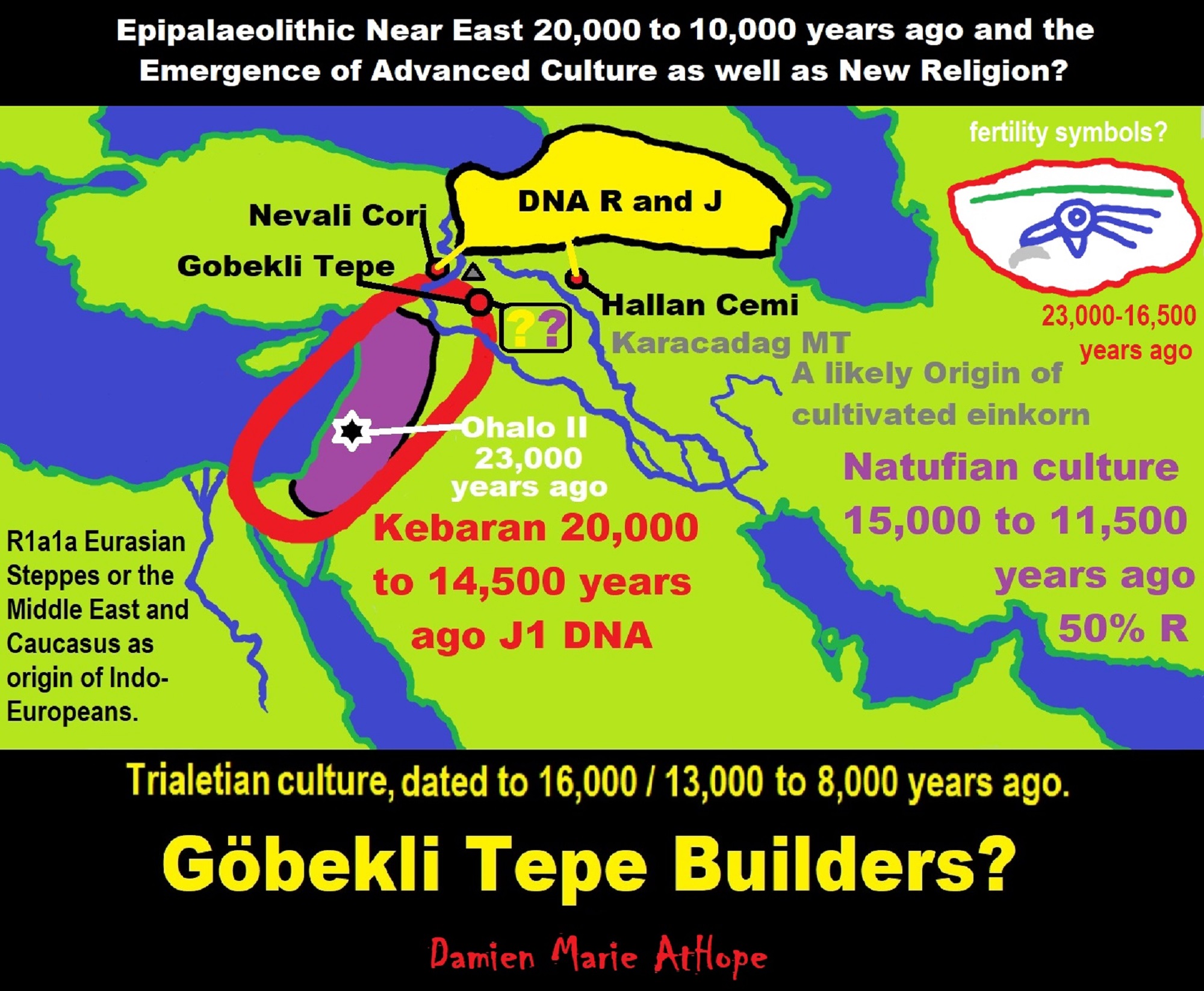
Trialetian culture (16,000–8000 years ago) the Caucasus, Iran, and Turkey, likely involved in Göbekli Tepe. Migration 1?
Haplogroup R possible time of origin about 27,000 years in Central Asia, South Asia, or Siberia:
- Mal’ta–Buret’ culture (24,000-15,000 years ago)
- Afontova Gora culture (21,000-12,000 years ago)
- Trialetian culture (16,000–8000 years ago)
- Samara culture (7,000-6,500 years ago)
- Khvalynsk culture (7,000-6,500 years ago)
- Afanasievo culture (5,300-4,500 years ago)
- Yamna/Yamnaya Culture (5,300-4,500 years ago)
- Andronovo culture (4,000–2,900 years ago) ref
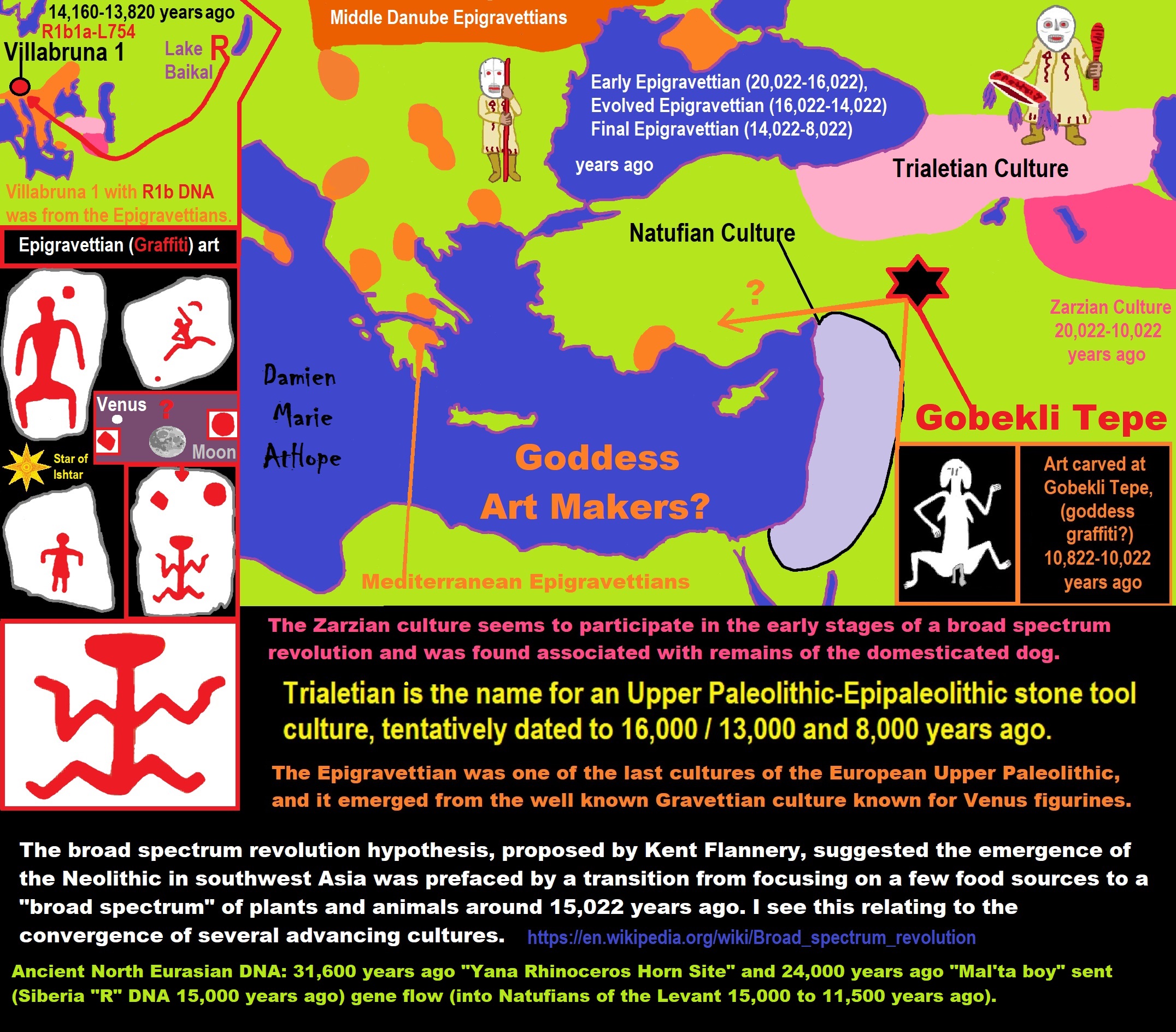
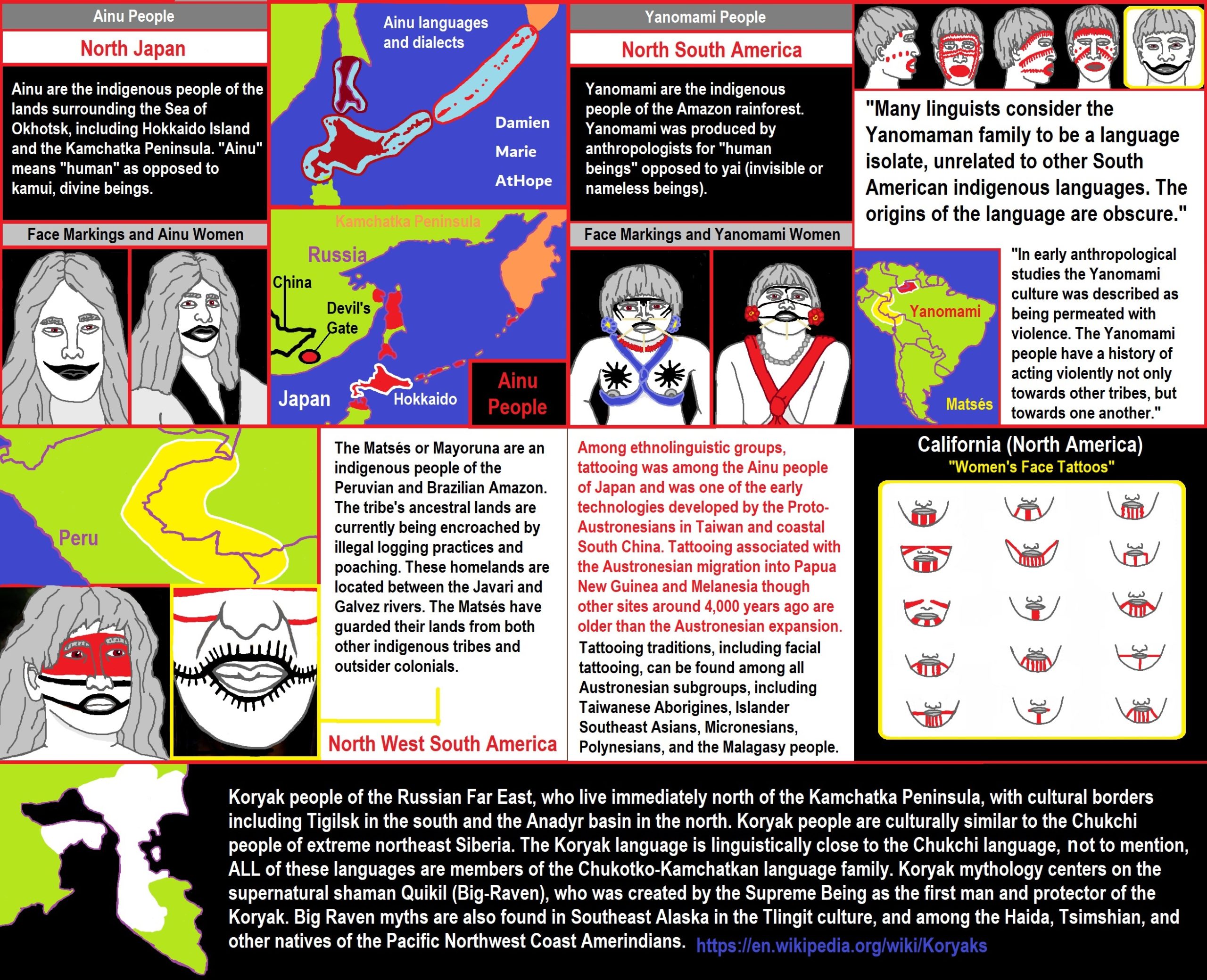
ref, ref, ref, ref, ref, ref, ref, ref, ref, ref
“Koryak people of the Russian Far East, who live immediately north of the Kamchatka Peninsula, with cultural borders including Tigilsk in the south and the Anadyr basin in the north. Koryak people are culturally similar to the Chukchi people of extreme northeast Siberia. The Koryak language is linguistically close to the Chukchi language, not to mention, ALL of these languages are members of the Chukotko-Kamchatkan language family. Koryak mythology centers on the supernatural shaman Quikil (Big-Raven), who was created by the Supreme Being as the first man and protector of the Koryak. Big Raven myths are also found in Southeast Alaska in the Tlingit culture, and among the Haida, Tsimshian, and other natives of the Pacific Northwest Coast Amerindians.” ref
Ainu people
“The Ainu are the indigenous people of the lands surrounding the Sea of Okhotsk, including Hokkaido Island, Northeast Honshu Island, Sakhalin Island, the Kuril Islands, the Kamchatka Peninsula, and Khabarovsk Krai, before the arrival of the Yamato Japanese and Russians. These regions are referred to as Ezo (蝦夷) in historical Japanese texts. In 1966 there were about 300 native Ainu speakers, while in 2008, there were about 100 native Ainu speakers.” ref
Official estimates place the total Ainu population of Japan at 25,000. Unofficial estimates place the total population at 200,000 or higher, as the near-total assimilation of the Ainu into Japanese society has resulted in many individuals of Ainu descent having no knowledge of their ancestry. As of 2000, the number of “pure” Ainu was estimated at about 300 people.” ref
“This people’s most widely known ethnonym, “Ainu” (Ainu: アィヌ; Japanese: アイヌ; Russian: Айны) means “human” in the Ainu language, particularly as opposed to kamui, divine beings. Ainu also identify themselves as “Utari” (“comrade” or “people”). Official documents use both names.” ref
“The Ainu are the native people of Hokkaido, Sakhalin and the Kurils. Early Ainu-speaking groups (mostly hunters and fishermen) migrated also into the Kamchatka Peninsula and into Honshu, where their descendants are today known as the Matagi hunters, who still use a large amount of Ainu vocabulary in their dialect. Other evidence for Ainu-speaking hunters and fishermen migrating down from Northern Hokkaido into Honshu is through the Ainu toponyms which are found in several places of northern Honshu, mostly among the western coast and the Tōhoku region. Evidence for Ainu speakers in the Amur region is found through Ainu loanwords in the Uilta and Ulch people.” ref
“Research suggests that Ainu culture originated from a merger of the Okhotsk and Satsumon cultures. According to Lee and Hasegawa, the Ainu-speakers descend from the Okhotsk people which rapidly expanded from northern Hokkaido into the Kurils and Honshu. These early inhabitants did not speak the Japanese language; some were conquered by the Japanese early in the 9th century. In 1264, the Ainu invaded the land of the Nivkh people. The Ainu also started an expedition into the Amur region, which was then controlled by the Yuan Dynasty, resulting in reprisals by the Mongols who invaded Sakhalin. Active contact between the Wa-jin (the ethnically Japanese, also known as Yamato-jin) and the Ainu of Ezogashima (now known as Hokkaidō) began in the 13th century. The Ainu formed a society of hunter-gatherers, surviving mainly by hunting and fishing. They followed a religion which was based on natural phenomena.” ref
“The Ainu have often been considered to descend from the diverse Jōmon people, who lived in northern Japan from the Jōmon period (c. 14,000 to 300 BCE). One of their Yukar Upopo, or legends, tells that “[t]he Ainu lived in this place a hundred thousand years before the Children of the Sun came”. Recent research suggests that the historical Ainu culture originated from a merger of the Okhotsk culture with the Satsumon culture, cultures thought to have derived from the diverse Jōmon-period cultures of the Japanese archipelago. The Ainu economy was based on farming, as well as on hunting, fishing, and gathering.” ref
“According to Lee and Hasegawa of the Waseda University, the direct ancestors of the later Ainu people formed during the late Jōmon period from the combination of the local but diverse population of Hokkaido, long before the arrival of contemporary Japanese people. Lee and Hasegawa suggest that the Ainu language expanded from northern Hokkaido and may have originated from a relative more recent Northeast Asian/Okhotsk population, which established themselves in northern Hokkaido and had significant impact on the formation of Hokkaido’s Jōmon culture.” ref
“The linguist and historian Joran Smale similarly found that the Ainu language likely originated from the ancient Okhotsk people, which had strong cultural influence on the “Epi-Jōmon” of southern Hokkaido and northern Honshu, but that the Ainu people themselves formed from the combination of both ancient groups. Additionally, he notes that the historical distribution of Ainu dialects and its specific vocabulary corresponds to the distribution of the maritime Okhotsk culture.” ref
“Recently in 2021, it was confirmed that the Hokkaido Jōmon people formed from “Jōmon tribes of Honshu” and from “Terminal Upper-Paleolithic people” (TUP people) indigenous to Hokkaido and Paleolithic Northern Eurasia. The Honshu Jōmon groups arrived about 15,000 BC and merged with the indigenous “TUP people” to form the Hokkaido Jōmon. The Ainu in turn formed from the Hokkaido Jōmon and from the Okhotsk people.” ref
“Another study in 2021 (Sato et al.) analyzed the indigenous populations of northern Japan and the Russian Far East. They concluded that Siberia and northern Japan was populated by two distinct waves: “the southern migration wave seems to have diversified into the local populations in East Asia (defined in this paper as a region including China, Japan, Korea, Mongol, and Taiwan) and Southeast Asia, and the northern wave, which probably runs through the Siberian and Eurasian steppe regions and mixed with the southern wave, probably in Siberia. Archaeologists have considered that bear worship, which is a religious practice widely observed among the northern Eurasian ethnic groups, including the Ainu, Finns, Nivkh, and Sami, was also shared by the Okhotsk people. On the other hand, no traces of such a religious practice have ever been discovered from archaeological sites of the Jomon and Epi-Jomon periods, which were anterior to the Ainu cultural period. This implies that the Okhotsk culture contributed to the forming of the Ainu culture.” ref
Genetics: Genetic history of East Asians and Jōmon people
Paternal lineages
“Genetic testing has shown that the Ainu belong mainly to Y-DNA haplogroup D-M55 (D1a2) and C-M217. Y DNA haplogroup D M55 is found throughout the Japanese Archipelago, but with very high frequencies among the Ainu of Hokkaidō in the far north, and to a lesser extent among the Ryukyuans in the Ryukyu Islands of the far south. Recently it was confirmed that the Japanese branch of haplogroup D M55 is distinct and isolated from other D branches for more than 53,000 years.” ref
“Several studies (Hammer et al. 2006, Shinoda 2008, Matsumoto 2009, Cabrera et al. 2018) suggest that haplogroup D originated somewhere in Central Asia. According to Hammer et al., the ancestral haplogroup D originated between Tibet and the Altai mountains. He suggests that there were multiple waves into Eastern Eurasia.” ref
“A study by Tajima et al. (2004) found two out of a sample of sixteen Ainu men (or 12.5%) belong to Haplogroup C M217, which is the most common Y chromosome haplogroup among the indigenous populations of Siberia and Mongolia. Hammer et al. (2006) found that one in a sample of four Ainu men belonged to haplogroup C M217.” ref
Maternal lineages
“Based on analysis of one sample of 51 modern Ainu, their mtDNA lineages consist mainly of haplogroup Y [11⁄51 = 21.6% according to Tanaka et al. 2004, or 10⁄51 = 19.6% according to Adachi et al. 2009, who have cited Tajima et al. 2004], haplogroup D [9⁄51 = 17.6%, particularly D4 (xD1)], haplogroup M7a (8⁄51 = 15.7%), and haplogroup G1 (8⁄51 = 15.7%). Other mtDNA haplogroups detected in this sample include A (2⁄51), M7b2 (2⁄51), N9b (1⁄51), B4f (1⁄51), F1b (1⁄51), and M9a (1⁄51). Most of the remaining individuals in this sample have been classified definitively only as belonging to macro-haplogroup M.” ref
“According to Sato et al. (2009), who have studied the mtDNA of the same sample of modern Ainus (N=51), the major haplogroups of the Ainu are N9 [14⁄51 = 27.5%, including 10⁄51 Y and 4⁄51 N9 (xY)], D [12⁄51 = 23.5%, including 8⁄51 D (xD5) and 4⁄51 D5], M7 (10⁄51 = 19.6%), and G (10⁄51 = 19.6%, including 8⁄51 G1 and 2⁄51 G2); the minor haplogroups are A (2⁄51), B (1⁄51), F (1⁄51), and M (xM7, M8, CZ, D, G) (1⁄51).” ref
“Studies published in 2004 and 2007 show the combined frequency of M7a and N9b were observed in Jōmons and which are believed by some to be Jōmon maternal contribution at 28% in Okinawans [7⁄50 M7a1, 6⁄50 M7a (xM7a1), 1⁄50 N9b], 17.6% in Ainus [8⁄51 M7a (xM7a1), 1⁄51 N9b], and from 10% [97⁄1312 M7a (xM7a1), 1⁄1312 M7a1, 28⁄1312 N9b] to 17% [15⁄100 M7a1, 2⁄100 M7a (xM7a1)] in mainstream Japanese. In addition, haplogroups D4, D5, M7b, M9a, M10, G, A, B, and F have been found in Jōmon people as well. These mtDNA haplogroups were found in various Jōmon samples and in some modern Japanese people.” ref
“A study by Kanazawa-Kiriyama in 2013 about mitochondrial haplogroups, found that the Ainu people (including samples from Hokkaido and Tōhoku) have a high frequency of N9b, which is also found among Udege people of eastern Siberia, and more common among Europeans than Eastern Asians, but absent from the geographically close Kantō Jōmon period samples, which have a higher frequency of M7a7, which is commonly found among East and Southeast Asians. According to the authors, these results add to the internal-diversity observed among the Jōmon period population and that a significant percentage of the Jōmon period people had ancestry from a Northeast Asian source population, suggested to be the source of the proto-Ainu language and culture, which is not detected in samples from Kantō.” ref
Autosomal DNA
“A 2004 reevaluation of cranial traits suggests that the Ainu resemble the Okhotsk more than they do the Jōmon but there are large variations. This agrees with the references to the Ainu as a merger of Okhotsk and Satsumon referenced above. Similarly, more recent studies link the Ainu to the local Hokkaido Jōmon period samples, such as the 3,800-year-old Rebun sample.” ref
“Genetic analyses of HLA I and HLA II genes as well as HLA-A, -B, and -DRB1 gene frequencies links the Ainu to Indigenous peoples of the Americas. Genetic of variety Asian groups shows Ainu and of Native Americans are place relatively close can be traced back to Paleolithic groups in Siberia.” ref
“Hideo Matsumoto (2009) suggested, based on immunoglobulin analyses, that the Ainu (and Jōmon) have a Siberian origin. Compared with other East Asian populations, the Ainu have the highest amount of Siberian (immunoglobulin) components, higher than mainland Japanese people. A 2012 genetic study has revealed that the closest genetic relatives of the Ainu are the Ryukyuan people, followed by the Yamato people and Nivkh.” ref
“A genetic analysis in 2016 showed that although the Ainu have some genetic relations to the Japanese people and Eastern Siberians (especially Itelmens and Chukchis), they are not directly related to any modern ethnic group. Further, the study detected genetic contribution from the Ainu to populations around the Sea of Okhotsk but no genetic influence on the Ainu themselves. According to the study, the Ainu-like genetic contribution in the Ulch people is about 17.8% or 13.5% and about 27.2% in the Nivkhs. The study also disproved the idea about a relation to Andamanese or Tibetans; instead, it presented evidence of gene flow between the Ainu and “lowland East Asian farmer populations” (represented in the study by the Ami and Atayal in Taiwan, and the Dai and Lahu in Mainland East Asia).” ref
“A genetic study in 2016 about historical Ainu samples from southern Sakhalin (8) and northern Hokkaido (4), found that these samples were closely related to ancient Okhotsk people and various other Northeast Asians, such as indigenous populations in Kamchatka (Itelmens). The authors conclude that this points to heterogeneity among the historical Ainu, as other studies reported a rather isolated position of analyzed Ainu samples from southern Hokkaido.” ref
“Recent autosomal evidence suggests that the Ainu derive a majority of their ancestry from the local Jōmon period people of Hokkaido. A 2019 study by Gakuhari et al., analyzing ancient Jōmon remains, finds about 79.3% Hokkaido Jōmon ancestry in the Ainu. Another 2019 study (by Kanazawa-Kiriyama et al.) finds about 66% Hokkaido Jōmon ancestry. A genetic study in 2021 (Sato et al.) found that the Ainu probably derived about ~49% of their ancestry from the local Hokkaido Jōmon, ~22% from the Okhotsk (samplified by Chukotko-Kamchatkan peoples), and ~29% from the Yamato Japanese.” ref
“Population genomic data from various Jōmon period samples show that their main ancestry component split from other East Asian people at about 15,000 BCE. Following their migration into the Japanese archipelago, they became largely isolated from outside geneflow. However, geneflow from Ancient North Eurasians towards the Jōmon period population was detected along a North to South cline, with a peak among Hokkaido Jōmon.” ref
“A study by Adachi et al. 2018 concluded that: “Our results suggest that the Ainu were formed from the Hokkaido Jomon people, but subsequently underwent considerable admixture with adjacent populations. The present study strongly recommends revision of the widely accepted dual-structure model for the population history of the Japanese, in which the Ainu are assumed to be the direct descendants of the Jomon people.” ref
“The Ainu often resemble Native Americans, but exhibit a variation of phenotypes, ranging from “Caucasian” to East Asian, with many having an intermediate appearance. Physical differences could be observed between different Ainu subgroups and clans. The numerous large Kabata and Hidaka Ainu clans largely resembled Northeast Asians and Northeastern Siberians, rather than Europeans. The physical differences between Ainu and neighboring Japanese and Koreans, was found to be not as large as early historians suggested. Many Ainu men have abundant wavy hair and often have long beards. There was also a number of mixed Russian-Ainu individuals.” ref
“The book of Ainu Life and Legends by author Kyōsuke Kindaichi (published by the Japanese Tourist Board in 1942) contains a physical description of Ainu: “Many have wavy hair, but some straight black hair. Very few of them have wavy brownish hair. Their skins are generally reported to be light brown. But this is due to the fact that they labor on the sea and in briny winds all day. Old people who have long desisted from their outdoor work are often found to be as white as western men. The Ainu have broad faces, beetling eyebrows, and sometimes large sunken eyes, which are generally horizontal and of the so-called European type. Eyes of the Mongolian type are rare but occasionally found among them.” ref
“A comparative study by Brace et al. (2001) showed a closer morphological relation of the Ainu and their Hokkaido Jōmon ancestors with prehistoric and living European groups. The study concludes that part of their ancestors are descended from of a population (dubbed “Eurasians” by Brace et al.) that moved into northern Eurasia eastwards in the Late Pleistocene, which significantly predates the expansion of the modern core population of East Asia from Mainland Southeast Asia. According to the authors, these morphological similarities suggest distant genetic ties at one time, and provides some basis for the long-time claim that the Ainu have an Indo-European component among their ancestry.” ref
“A study by Kura et al. 2014 based on cranial and genetic characteristics suggests a mostly Northeastern Asian (“Arctic“) origin for Ainu people. Thus, despite Ainu sharing some morphological similarities to Caucasoid populations, the Ainu are essentially of North Asiatic origin. Genetic evidence supports a closer relation with Paleosiberian Arctic populations, such as the Chukchi people. A study by Omoto has shown that the Ainu are closer related to other East Asian groups (previously mentioned as ‘Mongoloid’) than to Western Eurasian groups (formerly termed as “Caucasian”), on the basis of fingerprints and dental morphology.” ref
“A study published in the scientific journal “Nature” by Jinam et al. 2015, using genome-wide SNP data comparison, found that a noteworthy amount of Ainu carry gene alleles associated with facial features which are commonly found among Europeans but absent from Japanese people and other East Asians, but these alleles are not found in all tested Ainu samples. These alleles are the reason for their pseudo-Caucasian appearance and likely arrived from Paleolithic Siberia.” ref
“In 2021, it was confirmed that the Hokkaido Jōmon population formed from “Terminal Upper-Paleolithic people” (TUP) indigenous to Hokkaido and Northern Eurasia and from migrants of Jōmon period Honshu. The Ainu themselves formed from these heterogeneous Hokkaido Jōmon and from a more recent Northeast Asian/Okhotsk population. Traditional Ainu culture was quite different from Japanese culture. According to Tanaka Sakurako from the University of British Columbia, the Ainu culture can be included into a wider “northern circumpacific region”, referring to various indigenous cultures of Northeast Asia and “beyond the Bering Strait” in North America.” ref
“Never shaving after a certain age, the men had full beards and moustaches. Men and women alike cut their hair level with the shoulders at the sides of the head, trimmed semicircularly behind. The women tattooed (anchi-piri) their mouths, and sometimes the forearms. The mouth tattoos were started at a young age with a small spot on the upper lip, gradually increasing with size.” ref
“The soot deposited on a pot hung over a fire of birch bark was used for colour. Their traditional dress was a robe spun from the inner bark of the elm tree, called attusi or attush. Various styles were made, and consisted generally of a simple short robe with straight sleeves, which was folded around the body, and tied with a band about the waist. The sleeves ended at the wrist or forearm and the length generally was to the calves. Women also wore an undergarment of Japanese cloth.” ref
“The Ainu hunted from late autumn to early summer. The reasons for this were, among others, that in late autumn, plant gathering, salmon fishing, and other activities of securing food came to an end, and hunters readily found game in fields and mountains in which plants had withered. A village possessed a hunting ground of its own or several villages used a joint hunting territory (iwor). Heavy penalties were imposed on any outsiders trespassing on such hunting grounds or joint hunting territory.” ref
“The Ainu hunted Ussuri brown bears, Asian black bears, Ezo deer (a subspecies of sika deer), hares, red foxes, Japanese raccoon dogs, and other animals. Ezo deer were a particularly important food resource for the Ainu, as were salmon. They also hunted sea eagles such as white-tailed sea eagles, raven, and other birds. The Ainu hunted eagles to obtain their tail feathers, which they used in trade with the Japanese.” ref
“The Ainu hunted with arrows and spears with poison-coated points. They obtained the poison, called surku, from the roots and stalks of aconites. The recipe for this poison was a household secret that differed from family to family. They enhanced the poison with mixtures of roots and stalks of dog’s bane, boiled juice of Mekuragumo (a type of harvestman), Matsumomushi (Notonecta triguttata, a species of backswimmer), tobacco, and other ingredients. They also used stingray stingers or skin covering stingers.” ref
“They hunted in groups with dogs. Before the Ainu went hunting, particularly for bear and similar animals, they prayed to the god of fire, the house guardian god, to convey their wishes for a large catch, and to the god of mountains for safe hunting.” ref
“The Ainu usually hunted bear during the spring thaw. At that time, bears were weak because they had not fed at all during their long hibernation. Ainu hunters caught hibernating bears or bears that had just left hibernation dens. When they hunted bear in summer, they used a spring trap loaded with an arrow, called an amappo. The Ainu usually used arrows to hunt deer. Also, they drove deer into a river or sea and shot them with arrows. For a large catch, a whole village would drive a herd of deer off a cliff and club them to death.” ref
“Fishing was important for the Ainu. They largely caught trout, primarily in summer, and salmon in autumn, as well as “ito” (Japanese huchen), dace, and other fish. Spears called “marek” were often used. Other methods were “tesh” fishing, “uray” fishing and “rawomap” fishing. Many villages were built near rivers or along the coast. Each village or individual had a definite river fishing territory. Outsiders could not freely fish there and needed to ask the owner.” ref
“Men wore a crown called sapanpe for important ceremonies. Sapanpe was made from wood fibre with bundles of partially shaved wood. This crown had wooden figures of animal gods and other ornaments on its center. Men carried an emush (ceremonial sword) secured by an emush at strap to their shoulders.” ref
“Women wore matanpushi, embroidered headbands, and ninkari, earrings. Ninkari was a metal ring with a ball. Matanpushi and ninkari were originally worn by men. Furthermore, aprons called maidari now are a part of women’s formal clothes. However, some old documents say that men wore maidari. Women sometimes wore a bracelet called tekunkani.” ref
“Women wore a necklace called rektunpe, a long, narrow strip of cloth with metal plaques. They wore a necklace that reached the breast called a tamasay or shitoki, usually made from glass balls. Some glass balls came from trade with the Asian continent. The Ainu also obtained glass balls secretly made by the Matsumae clan.” ref
“The Ainu people had various types of marriage. A child was promised in marriage by arrangement between his or her parents and the parents of his or her betrothed or by a go-between. When the betrothed reached a marriageable age, they were told who their spouse was to be. There were also marriages based on mutual consent of both sexes. In some areas, when a daughter reached a marriageable age, her parents let her live in a small room called tunpu annexed to the southern wall of her house. The parents chose her spouse from men who visited her. The age of marriage was 17 to 18 years of age for men and 15 to 16 years of age for women, who were tattooed. At these ages, both sexes were regarded as adults.” ref
“When a man proposed to a woman, he visited her house, ate half a full bowl of rice handed to him by her, and returned the rest to her. If the woman ate the rest, she accepted his proposal. If she did not and put it beside her, she rejected his proposal. When a man became engaged to a woman or they learned that their engagement had been arranged, they exchanged gifts. He sent her a small engraved knife, a workbox, a spool, and other gifts. She sent him embroidered clothes, coverings for the back of the hand, leggings, and other handmade clothes.” ref
“The worn-out fabric of old clothing was used for baby clothes because soft cloth was good for the skin of babies and worn-out material protected babies from gods of illness and demons due to these gods’ abhorrence of dirty things. Before a baby was breast-fed, they were given a decoction of the endodermis of alder and the roots of butterburs to discharge impurities. Children were raised almost naked until about the ages of four to five. Even when they wore clothes, they did not wear belts and left the front of their clothes open. Subsequently, they wore bark clothes without patterns, such as attush, until coming of age.” ref
“Newborn babies were named ayay (a baby’s crying), shipo, poyshi (small excrement), and shion (old excrement). Children were called by these “temporary” names until the ages of two to three. They were not given permanent names when they were born. Their tentative names had a portion meaning “excrement” or “old things” to ward off the demon of ill-health. Some children were named based on their behavior or habits. Other children were named after impressive events or after parents’ wishes for the future of the children. When children were named, they were never given the same names as others.” ref
“Men wore loincloths and had their hair dressed properly for the first time at age 15–16. Women were also considered adults at the age of 15–16. They wore underclothes called mour and had their hair dressed properly and wound waistcloths called raunkut and ponkut around their bodies. When women reached age 12–13, the lips, hands, and arms were tattooed. When they reached age 15–16, their tattoos were completed. Thus were they qualified for marriage.” ref
Religion: Ainu creation myth, Ko-Shintō, and Shamanism in Siberia
See also: Category:Ainu mythology
“The Ainu are traditionally animists, believing that everything in nature has a kamuy (spirit or god) on the inside. The most important include Kamuy-huci, goddess of the hearth, Kim-un-kamuy, god of bears and mountains, and Repun Kamuy, god of the sea, fishing, and marine animals. Kotan-kar-kamuy is regarded as the creator of the world in the Ainu religion.” ref
“The Ainu have no priests by profession; instead the village chief performs whatever religious ceremonies are necessary. Ceremonies are confined to making libations of sake, saying prayers, and offering willow sticks with wooden shavings attached to them. These sticks are called inaw (singular) and nusa (plural). They are placed on an altar used to “send back” the spirits of killed animals. Ainu ceremonies for sending back bears are called Iyomante. The Ainu people give thanks to the gods before eating and pray to the deity of fire in time of sickness. They believe that their spirits are immortal, and that their spirits will be rewarded hereafter by ascending to kamuy mosir (Land of the Gods).” ref
“The Ainu are part of a larger collective of indigenous people who practice “arctolatry” or bear worship. The Ainu believe that the bear holds particular importance as Kim-un Kamuy’s chosen method of delivering the gift of the bear’s hide and meat to humans. John Batchelor reported that the Ainu view the world as being a spherical ocean on which float many islands, a view based on the fact that the sun rises in the east and sets in the west. He wrote that they believe the world rests on the back of a large fish, which when it moves causes earthquakes.” ref
“Ainu assimilated into mainstream Japanese society have adopted Buddhism and Shintō, while some northern Ainu were converted as members of the Russian Orthodox Church. Regarding Ainu communities in Shikotanto (色丹) and other areas that fall within the Russian sphere of cultural influence, there have been cases of church construction as well as reports that some Ainu have decided to profess their Christian faith.” ref
“There have also been reports that the Russian Orthodox Church has performed some missionary projects in the Sakhalin Ainu community. However, not many people have converted and there are only reports of several persons who have converted. Converts have been scorned as “Nutsa Ainu” (Russian Ainu) by other members of the Ainu community. Even so, the reports indicate that many Ainu have kept their faith in the deities of ancient times.” ref
Evolution of blond hair?
“Single nucleotide polymorphisms of the KITLG gene are associated with blonde hair color in various human populations. One of these polymorphisms is associated with blond hair. The earliest known individual with this allele is a female south-central Siberian ANE individual from Afontova Gora 3 site, which is dated to 16130-15749 BCE. It is thus argued that at least some ANE individuals were blonde-haired.” ref
Geneticist David Reich said that the KITLG gene for blond hair probably entered continental Europe in a population migration wave from the Eurasian steppe, by a population carrying substantial Ancient North Eurasian ancestry. Hanel and Carlberg (2020) likewise report that populations bearing Ancient North Eurasian ancestry were responsible for contributing gene alleles lightening European hair color.” ref
‘Ancient North Eurasians’ and Comparative mythology
“Since the term ‘Ancient North Eurasian’ refers to a genetic bridge of connected mating networks, scholars of comparative mythology have argued that they probably shared myths and beliefs that could be reconstructed via the comparison of stories attested within cultures that were not in contact for millennia and stretched from the Pontic–Caspian steppe to the American continent.” ref
“For instance, the mytheme of the dog guarding the Otherworld possibly stems from an older Ancient North Eurasian belief, as suggested by similar motifs found in Indo-European, Native American, and Siberian mythology. In Siouan, Algonquian, Iroquoian, and in Central and South American beliefs, a fierce guard dog was located in the Milky Way, perceived as the path of souls in the afterlife, and getting past it was a test. The Siberian Chukchi and Tungus believed in a guardian-of-the-afterlife dog and a spirit dog that would absorb the dead man’s soul and act as a guide in the afterlife. In Indo-European myths, the figure of the dog is embodied by Cerberus, Sarvarā, and Garmr. Anthony and Brown note that it might be one of the oldest mythemes recoverable through comparative mythology.” ref
“A second canid-related series of beliefs, myths, and rituals connected dogs with healing rather than death. For instance, Ancient Near Eastern and Turkic–Kipchaq myths are prone to associate dogs with healing and generally categorized dogs as impure. A similar myth-pattern is assumed for the Eneolithic site of Botai in Kazakhstan, dated to 3500 BCE or 5,522 years ago, which might represent the dog as an absorber of illness and guardian of the household against disease and evil. In Mesopotamia, the goddess Nintinugga, associated with healing, was accompanied or symbolized by dogs. Similar absorbent-puppy healing and sacrifice rituals were practiced in Greece and Italy, among the Hittites, again possibly influenced by Near Eastern traditions.” ref
Proto-Indo-European mythology
“Proto-Indo-European mythology is the body of myths and deities associated with the Proto-Indo-Europeans, the hypothetical speakers of the reconstructed Proto-Indo-European language. Although the mythological motifs are not directly attested – since Proto-Indo-European speakers lived in preliterate societies – scholars of comparative mythology have reconstructed details from inherited similarities found among Indo-European languages, based on the assumption that parts of the Proto-Indo-Europeans’ original belief systems survived in the daughter traditions.” ref
“The Proto-Indo-European pantheon includes a number of securely reconstructed deities, since they are both cognates – linguistic siblings from a common origin –, and associated with similar attributes and body of myths: such as *Dyḗws Ph₂tḗr, the daylight-sky god; his consort *Dʰéǵʰōm, the earth mother; his daughter *H₂éwsōs, the dawn goddess; his sons the Divine Twins; and *Seh₂ul, a solar goddess. Some deities, like the weather god *Perkʷunos or the herding-god *Péh₂usōn, are only attested in a limited number of traditions – Western (European) and Graeco-Aryan, respectively – and could therefore represent late additions that did not spread throughout the various Indo-European dialects.” ref
“Some myths are also securely dated to Proto-Indo-European times, since they feature both linguistic and thematic evidence of an inherited motif: a story portraying a mythical figure associated with thunder and slaying a multi-headed serpent to release torrents of water that had previously been pent up; a creation myth involving two brothers, one of whom sacrifices the other in order to create the world; and probably the belief that the Otherworld was guarded by a watchdog and could only be reached by crossing a river.” ref
“Various schools of thought exist regarding possible interpretations of the reconstructed Proto-Indo-European mythology. The main mythologies used in comparative reconstruction are Indo-Iranian, Baltic, Roman, and Norse, often supported with evidence from the Celtic, Greek, Slavic, Hittite, Armenian, Illyrian, and Albanian traditions as well.” ref
“The mythology of the Proto-Indo-Europeans is not directly attested and it is difficult to match their language to archaeological findings related to any specific culture from the Chalcolithic. Nonetheless, scholars of comparative mythology have attempted to reconstruct aspects of Proto-Indo-European mythology based on the existence of linguistic and thematic similarities among the deities, religious practices, and myths of various Indo-European peoples. This method is known as the comparative method. Different schools of thought have approached the subject of Proto-Indo-European mythology from different angles.” ref
“The Meteorological or Naturist School holds that Proto-Indo-European myths initially emerged as explanations for natural phenomena, such as the Sky, the Sun, the Moon, and the Dawn. Rituals were therefore centered around the worship of those elemental deities. This interpretation was popular among early scholars, such as Friedrich Max Müller, who saw all myths as fundamentally solar allegories. Although recently revived by some scholars like Jean Haudry and Martin L. West, this school lost most of its scholarly support in the late nineteenth and early twentieth centuries.” ref
“The Ritual School, which first became prominent in the late nineteenth century, holds that Proto-Indo-European myths are best understood as stories invented to explain various rituals and religious practices. Scholars of the Ritual School argue that those rituals should be interpreted as attempts to manipulate the universe in order to obtain its favors. This interpretation reached the height of its popularity during the early twentieth century, and many of its most prominent early proponents, such as James George Frazer and Jane Ellen Harrison, were classical scholars. Bruce Lincoln, a contemporary member of the Ritual School, argues for instance that the Proto-Indo-Europeans believed that every sacrifice was a reenactment of the original sacrifice performed by the founder of the human race on his twin brother.” ref
“The Functionalist School, by contrast, holds that myths served as stories reinforcing social behaviours through the meta-narrative justification of a traditional order. Scholars of the Functionalist School were greatly influenced by the trifunctional system proposed by Georges Dumézil, which postulates a tripartite ideology reflected in a threefold division between a clerical class (encompassing both the religious and social functions of the priests and rulers), a warrior class (connected with the concepts of violence and braveness), and a class of farmers or husbandmen (associated with fertility and craftsmanship), on the basis that many historically known groups speaking Indo-European languages show such a division. Dumézil’s theory had a major influence on Indo-European studies from the mid-20th century onwards, and some scholars continue to operate under its framework, although it has also been criticized as aprioristic and too inclusive, and thus impossible to be proved or disproved.” ref
“The Structuralist School argues that Proto-Indo-European mythology was largely centered around the concept of dualistic opposition. They generally hold that the mental structure of all human beings is designed to set up opposing patterns in order to resolve conflicting elements. This approach tends to focus on cultural universals within the realm of mythology rather than the genetic origins of those myths, such as the fundamental and binary opposition rooted in the nature of marriage proposed by Tamaz V. Gamkrelidze and Vyacheslav Ivanov. It also offers refinements of the trifunctional system by highlighting the oppositional elements present within each function, such as the creative and destructive elements both found within the role of the warrior.” ref
Source mythologies
“One of the earliest attested and thus one of the most important of all Indo-European mythologies is Vedic mythology, especially the mythology of the Rigveda, the oldest of the Vedas. Early scholars of comparative mythology such as Friedrich Max Müller stressed the importance of Vedic mythology to such an extent that they practically equated it with Proto-Indo-European myths. Modern researchers have been much more cautious, recognizing that, although Vedic mythology is still central, other mythologies must also be taken into account.” ref
“Another of the most important source mythologies for comparative research is Roman mythology. Contrary to the frequent erroneous statement made by some authors that “Rome has no myth”, the Romans possessed a very complex mythological system, parts of which have been preserved through the characteristic Roman tendency to rationalize their myths into historical accounts. Despite its relatively late attestation, Norse mythology is still considered one of the three most important of the Indo-European mythologies for comparative research, due to the vast bulk of surviving Icelandic material.” ref
“Baltic mythology has also received a great deal of scholarly attention, as it is linguistically the most conservative and archaic of all surviving branches, but has so far remained frustrating to researchers because the sources are so comparatively late. Nonetheless, Latvian folk songs are seen as a major source of information in the process of reconstructing Proto-Indo-European myth. Despite the popularity of Greek mythology in western culture, Greek mythology is generally seen as having little importance in comparative mythology due to the heavy influence of Pre-Greek and Near Eastern cultures, which overwhelms what little Indo-European material can be extracted from it. Consequently, Greek mythology received minimal scholarly attention until the first decade of the 21st century.” ref
“Although Scythians are considered relatively conservative in regards to Proto-Indo-European cultures, retaining a similar lifestyle and culture, their mythology has very rarely been examined in an Indo-European context and infrequently discussed in regards to the nature of the ancestral Indo-European mythology. At least three deities, Tabiti, Papaios, and Api, are generally interpreted as having Indo-European origins, while the remaining have seen more disparate interpretations. Influence from Siberian, Turkic, and even Near Eastern beliefs, on the other hand, are more widely discussed in literature.” ref
Cosmology: Indo-European cosmogony
“There was a fundamental opposition between the never-aging gods dwelling above in the skies, and the mortal humans living beneath on earth. The earth *dʰéǵʰōm was perceived as a vast, flat, and circular continent surrounded by waters (“the Ocean”). Although they may sometimes be identified with mythical figures or stories, the stars (*h₂stḗr) were not bound to any particular cosmic significance and were perceived as ornamental more than anything else. According to Martin L. West, the idea of the world-tree (axis mundi) is probably a later import from north Asiatic cosmologies: “The Greek myth might be derived from the Near East, and the Indic and Germanic ideas of a pillar from the shamanistic cosmologies of the Finnic and other peoples of central and northern Asia.” ref
Reconstruction
“There is no scholarly consensus as to which of the variants is the most accurate reconstruction of the Proto-Indo-European cosmogonic myth.[38] Bruce Lincoln‘s reconstruction of the Proto-Indo-European motif known as “Twin and Man” is supported by a number of scholars such as Jaan Puhvel, J. P. Mallory, Douglas Q. Adams, David W. Anthony, and, in part, Martin L. West.[39] Although some thematic parallels can be made with traditions of the Ancient Near East (the twins Abel and Cain and their brother Seth), and even Polynesian or South American legends, Lincoln argues that the linguistic correspondences found in descendant cognates of *Manu and *Yemo make it very likely that the myth has a Proto-Indo-European origin.” ref
“According to Edgar C. Polomé, “some elements of the [Scandinavian myth of Ymir] are distinctively Indo-European”, but the reconstruction proposed by Lincoln “makes too [many] unprovable assumptions to account for the fundamental changes implied by the Scandinavian version”. David A. Leeming also notes that the concept of the Cosmic Egg, symbolizing the primordial state from which the universe arises, is found in many Indo-European creation myths.” ref
Creation myth
“Lincoln reconstructs a creation myth involving twin brothers, *Manu- (“Man”) and *Yemo- (“Twin”), as the progenitors of the world and humankind, and a hero named *Trito (“Third”) who ensured the continuity of the original sacrifice. Regarding the primordial state that may have preceded the creation process, West notes that the Vedic, Norse, and, at least partially, the Greek traditions give evidence of an era when the cosmological elements were absent, with similar formula insisting on their non-existence: “neither non-being was nor being was at that time; there was not the air, nor the heaven beyond it…” (Rigveda), “…there was not sand nor sea nor the cool waves; earth was nowhere nor heaven above; Ginnunga Gap there was, but grass nowhere…” (Völuspá), “…there was Chasm and Night and dark Erebos at first, and broad Tartarus, but earth nor air nor heaven there was…” (The Birds).” ref
“In the creation myth, the first man Manu and his giant twin Yemo are crossing the cosmos, accompanied by the primordial cow. To create the world, Manu sacrifices his brother and, with the help of heavenly deities (the Sky-Father, the Storm-God, and the Divine Twins), forges both the natural elements and human beings from his remains. Manu thus becomes the first priest after initiating sacrifice as the primordial condition for the world order, and his deceased brother Yemo the first king as social classes emerge from his anatomy (priesthood from his head, the warrior class from his breast and arms, and the commoners from his sexual organs and legs). Although the European and Indo-Iranian versions differ on this matter, Lincoln argues that the primeval cow was most likely sacrificed in the original myth, giving birth to the other animals and vegetables, since the pastoral way of life of Proto-Indo-Iranian speakers was closer to that of Proto-Indo-European speakers.” ref
My speculations on a likely “Steppe-Anatolian-Kurgan hypothesis”
To me, what I call “Paganism” starts around 12,000 years ago in Turkey/Anatolia in West Aisa. The odd thing is most of the world’s religious myths/fables start or commonly relate to “Siberia” like “Lake Baikal/Golden Mountains of Altai” region and “North China” like “Chertovy Vorota Cave (Devil’s Gate Cave)” area at 8,000/7,000 years ago and they were transferred to the Middle East as well as East Europe/Balkans/Ukraine/Russia.
Steppe-Anatolian-Kurgan hypothesis (by Damien Marie AtHope)
To me, Proto-Indo-European starts in the steppe after leaving North Asia, then one-part heads to #1 Turkey/Anatolia with “Anatolian” and the other part to #2 Ukraine/Russia and the rest of Proto-Indo-European. Mythology starts 7,000-8,000 years ago in North Aisa.
To me, along with this migration of peoples also carried with them a Paganistic-Shamanism with heavy totemism.
To me, paganism starts around 12,00 years ago in Turkey/Anatolia in Western Asia. The odd thing is most of the world’s religious myths/fables start or commonly relate to “Siberia” like “Lake Baikal/Golden Mountains of Altai” region and “North China like Chertovy Vorota Cave (Devil’s Gate Cave) area at about 8,000/7,000 years ago and they were transferred to the middle east and East Europe/Balkans/Ukraine/Russia.”
Mal’ta–Buret’ culture of Siberia and Basal Haplogroup R* or R-M207
“The Mal’ta–Buret‘ culture is an archaeological culture of the Upper Paleolithic (around 24,000 to 15,000 years ago) on the upper Angara River in the area west of Lake Baikal in the Irkutsk Oblast, Siberia, Russian Federation. The type sites are named for the villages of Mal’ta, Usolsky District and Buret’, Bokhansky District (both in Irkutsk Oblast).” ref
“The “Mal’ta Cluster” is composed of three individuals from the Glacial Maximum 24,000-17,000 years ago from the Lake Baikal region of Siberia.” ref
“From about 55,000 years ago to about 15,000 years ago, the mammoth hunters are distinguished by their yurts built of mammoth bones. During that time their physical appearance changed from the rugged Neanderthal type to the more modern type like ourselves. The architecture of the yurts improved until 15,000 years ago, they were neatly constructed with the bones fitted together in patterns. Society seems to have developed too, with larger villages and the yurts arranged along streets. And with a ceremonial lodge as a main feature.” ref
“Blades and Microblades, Percussion and Pressure: Towards the Evolution of Lithic Technologies of the Stone Age Period, Russian Far East around 22,530 to 5,830 years ago. Russian Far East. Cultures and sites locations. 1 Selemja Culture; 2 Gromatukhinskaya and Novopetrovskaya Cultures ; 3 Osipovskaya Culture; 4 Mariinskaya Culture; 5 Ustinovka Culture; 6 Vetka Culture; 7 Ogonki Sites; 8 Ushki Lake sites.” ref
“When the mammoth hunters first arrived in Europe from Siberia, about 30,000 to 35,000 years ago, they brought with them a far more advanced technology and culture to the native Neanderthal population. Although the Neanderthals at the time were not far behind, this new culture was far more advance in so many ways that the European Neanderthals were from that time history. This is referred to as the Aurignacian culture and sites have been across Europe as well as in Siberia. These perhaps represent the first wave of “modern” European settlers as can be traced in the Y chromosomes of European men as originating from South Siberia.” ref
“The next wave of migrants into Europe from Siberia from 28,000 to 22,000 years ago is called the “Gravettian culture”. This is also traceable in the Y chromosome indicating orgins of European men as from South Siberia. Not just more advanced in technology, but also in trading relations and cultural and some kind of political relationship with other peoples. This is shown by the little portable “mother” figurines found at such mammoth hunter sites from across Europe, France, Czech Republic etc. and in South Siberia itself.” ref
The development of this culture can be found in sites in south Siberia such as those of Mal’ta and Buret. Finds from the mammoth-hunter yurts excavated near the Angara River (especally Mal’ta and Buret) sites start at a date of about 24,000 years ago. At Malta, with large and small round houses, partly dug out of the ground (as homes were in the north until into the Iron Age) and built with a low wall of stone and then roofed over with mammoth bones, reindeer antlers etc. – which would have been covered with mammoth hides. At Buret, the people lived together in large dwellings, several families together. There were three hearths in each – one in the center, and one either end.” ref
“Paleolithic art of Europe and Asia falls into two broad categories: mural art and portable art. Mural art is concentrated in southwest France, Spain, and northern Italy. The tradition of portable art, predominantly carvings in ivory and antler, spans the distance across western Europe into North and Central Asia. It is suggested that the broad territory in which the tradition of carving and imagery is shared is evidence of cultural contact and common religious beliefs.” ref
“Female/Mother images have been found right across the mammoth-hunter area. Artistically they vary. Some are very abstract and sophisticated. The mother figurines near the Angara River are mostly naturallistic. They show real women, with braided hair styles, possibly tattoos or body paint, saggy breasts, and in some cases it could represent clothing – a fur onesie or jumpsuit – much as was still worn until recently by the Chukchi and Koryak women in the North Pacific regions. These could be interpreted as protective “mothers” for childbirth, hunting, the home, the tribal territory, the earth and land itself, etc. Clearly many iconic beliefs still held today were already well established some 25,000 years ago.” ref
“Totally there are 39 or 40 known figurines found both on Mal’ta and Buret and although the ancient Siberian Venus figurines ‘are NOT Venuses (not depicting goddesses or gods). At least some if not many are show of ordinary people of seemingly all ages in clothing dating from some 20,000 years ago. Far from being only idealized female forms. many are seemingly male, and others could represent children. It’s true that in the past some of the woolly mammoth tusk carvings were known to be clothed as well as the different types of hats, hairstyles, shoes and accessories. Notably, these were called alluringly Venus in Furs figurines. They were dressed for protection from the Siberian winter, and are possibly the oldest known images anywhere in the world of sewn fur clothing. Through scientific study traces on the surface of the figurines were seen not visible to the naked eye, due to the ravages of time. These traces showed more details of clothes than we had seen previously: bracelets, hats, shoes, bags and even back packs. ” ref
“At one of the three hearths of the long house, were found “mother” dolls together with bracelets, headbands, pins and spatulas (which could be used for applying makeup). This is easily interpreted as the women’s quarters, especially as at the hearth at the other end, was found weapons, tools, jewellry and small ivory images of phallic looking swans – made to wear as pendants. Such swan pendants were also found in the tombs of men.” ref
“MA-1 is the abbreviation of male child remains found near Mal’ta dated to 24,000 years ago, who belonged to a population related to the genetic ancestors of Siberians, American Indians, and Bronze Age Yamnaya people of the Eurasian steppe. In particular, modern-day Native Americans, Kets, Mansi, Nganasans and Yukaghirs were found to be harbour a lot of ancestry related to MA-1.” ref
“24,000-year-old individual (MA-1), from Mal’ta in south-central Siberia. The MA-1 mitochondrial genome belongs to haplogroup U, which has also been found at high frequency among Upper Palaeolithic and Mesolithic European hunter-gatherers and the Y chromosome of MA-1 is basal to modern-day western Eurasians and near the root of most Native American lineages. Similarly, we find autosomal evidence that MA-1 is basal to modern-day western Eurasians and genetically closely related to modern-day Native Americans, with no close affinity to east Asians.” ref
“This suggests that populations related to contemporary western Eurasians had a more north-easterly distribution 24,000 years ago than commonly thought. Furthermore, we estimate that 14 to 38% of Native American ancestry may originate through gene flow from this ancient population. This is likely to have occurred after the divergence of Native American ancestors from east Asian ancestors, but before the diversification of Native American populations in the New World.” ref
“Gene flow from the MA-1 lineage into Native American ancestors could explain why several crania from the First Americans have been reported as bearing morphological characteristics that do not resemble those of east Asians. Sequencing of another south-central Siberian, Afontova Gora-2 dating to approximately 17,000 years ago, revealed similar autosomal genetic signatures as MA-1, suggesting that the region was continuously occupied by humans throughout the Last Glacial Maximum. And findings reveal that western Eurasian genetic signatures in modern-day Native Americans derive not only from post-Columbian admixture, as commonly thought, but also from a mixed ancestry of the First Americans.” ref
“Haplogroup P1 (P-M45), the immediate ancestor of Haplogroup R, likely emerged in Southeast Asia. The SNP M207, which defines Haplogroup R, is believed to have arisen about 27,000 years ago. Only one confirmed example of basal R* has been found, in 24,000 year old remains, known as MA1, found at Mal’ta–Buret’ culture near Lake Baikal in Siberia. R-M207 was found in one out of 132 males from the Kyrgyz people of East Kyrgyzstan who are a Turkic ethnic group native to Central Asia, primarily Kyrgyzstan bordered by Kazakhstan to the north, Uzbekistan to the west and southwest, Tajikistan to the southwest, and China to the east. It is possible that neither of the primary branches of R-M207, namely R1 (R-M173) and R2 (R-M479) still exist in their basal, undivergent forms, i.e. R1* and R2*. Despite the rarity of R* and R1*, the relatively rapid expansion – geographically and numerically – of subclades from R1 in particular, has often been noted: both R1a and R1b comprise young, star-like expansions.” ref
‘The earliest publications on R1b described their ancestor R1, entering Europe from central Asia during a warm period about 30,000 – 40,000 years ago. The last ice age forced R1 to split and take refuge south in Iberia and the Balkans. Time and separation gave us the mutations R1b in Iberia and R1a in the Balkans. That split is roughly what we see today in those regions. That’s clean and simple. The real world is much more complex. R1b and R1a were not alone in Europe. Their interactions with the other major European haplogroups- E, G, I, J and N has to be taken into consideration.” ref
“We know that modern humans survived and flourished in the Iberian refuge during the end of the last ice age, based on mitochondrial DNA studies. [Could someone please run some y-DNA tests on those samples?] The tribes in western Europe, whoever they were, had a 1,000 to 2,500 year head start over the tribes in central and eastern Europe on repopulating the continent. The ice sheets melted and retreated earlier on the west coast than in the rest of Europe. This gave the inhabitants of the Iberian refuge an advantage – a “first-mover” advantage gained by being the first to move north. These first-movers gained a land-monopoly. A tribe with a first-mover advantage and over a 1,000 year head start should have been hard to displace from western Europe. In other anthropological situations, those original inhabitants are forced into niche locations by invading populations, but very rarely are displaced completely. What we see on the west coast of Europe, is a very strong R1b presence and no niche haplogroups of a significant age.” ref
“Haplogroup R1 is very common throughout all of Eurasia except East Asia and Southeast Asia. Its distribution is believed to be associated with the re-settlement of Eurasia following the last glacial maximum. Its main subgroups are R1a and R1b.” ref
“The split of R1a (M420) is computed to ca 25,000 years ago or roughly the last glacial maximum. A large study using 16,244 individuals from over 126 populations from across Eurasia, concluded that there was compelling evidence that “the initial episodes of haplogroup R1a diversification likely occurred in the vicinity of present-day Iran.” ref
“A subclade of haplogroup R1a (especially haplogroup R1a1) is the most common haplogroup in large parts of South Asia, Eastern Europe, Central Asia, Western China, and South Siberia. One subclade of haplogroup R1b (especially R1b1a2), is the most common haplogroup in Western Europe and Bashkortostan which is a federal subject of Russia. It is located between the Volga River and the Ural Mountains.” ref
Haplogroup R possible time of origin about 27,000 years in Central Asia, South Asia, or Siberia:
- Mal’ta–Buret’ culture (24,000-15,000 years ago)
- Afontova Gora culture (21,000-12,000 years ago)
- Trialetian culture (16,000–8000 years ago)
- Samara culture (7,000-6,500 years ago)
- Khvalynsk culture (7,000-6,500 years ago)
- Afanasievo culture (5,300-4,500 years ago)
- Yamna/Yamnaya Culture (5,300-4,500 years ago)
- Andronovo culture (4,000–2,900 years ago) ref

I tried to put all the DNA migrations, that together help explain Sami DNA, and thus some of their cultural influences.

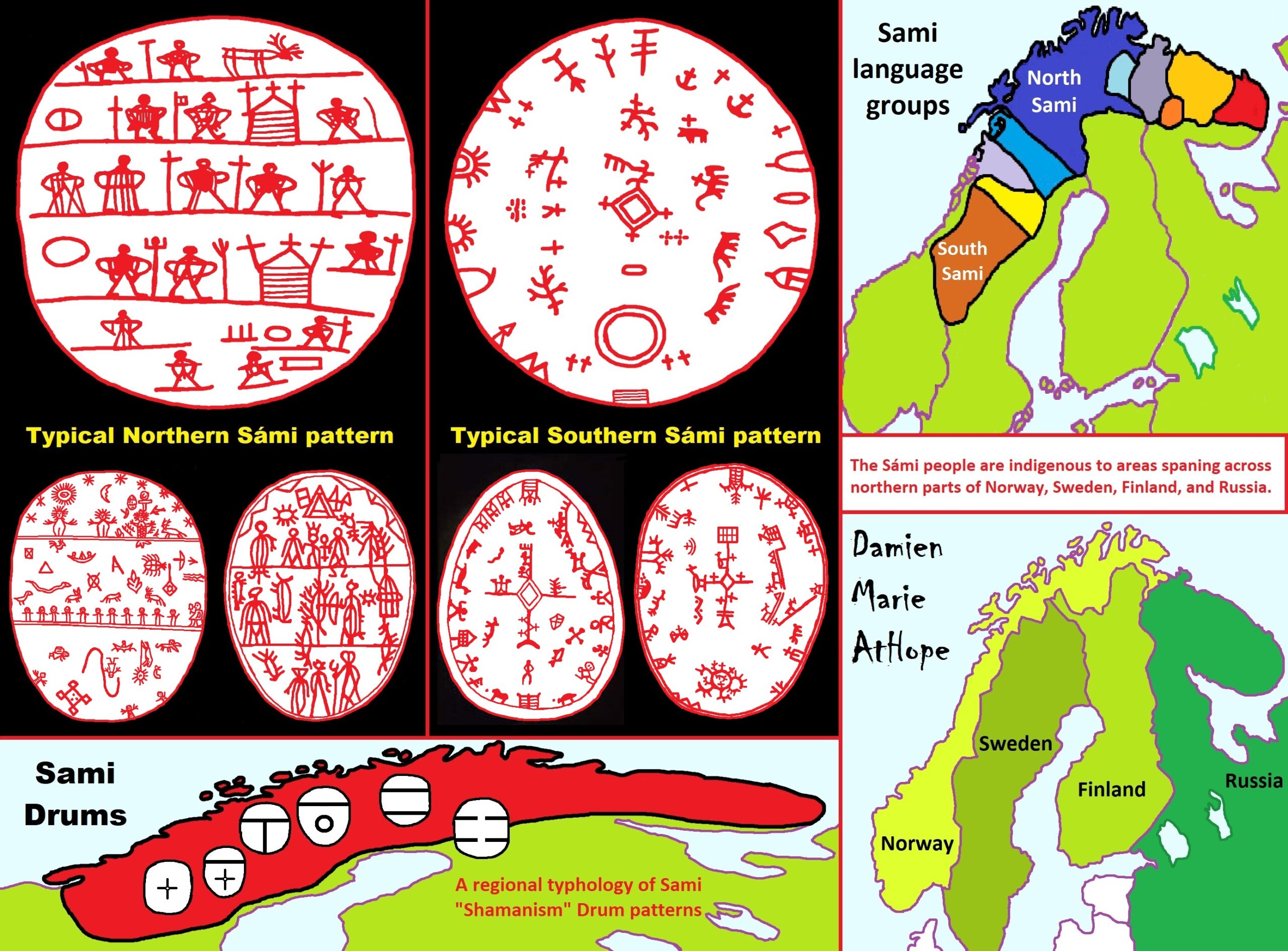
“The drum of Anders Paulsen (top left) and the Bindal drum (top right) represent variations in Sami drums, their shape, decoration and history. Paulsen’s drum was confiscated in Vadsø in 1691, while the Bindal drum was bought by a museum official in 1925; Vadsø and Bindal being in opposite corners of the Sami world. Paulsens’s drum has a typical Northern Sámi pattern, with several separate levels representing the different layers of spiritual worlds. The Bindal drum has a typical Southern Sami decoration: a rhombus-shaped sun symbol in the center, with other symbols around the sun, representing people, animals, landscape and deities.” ref
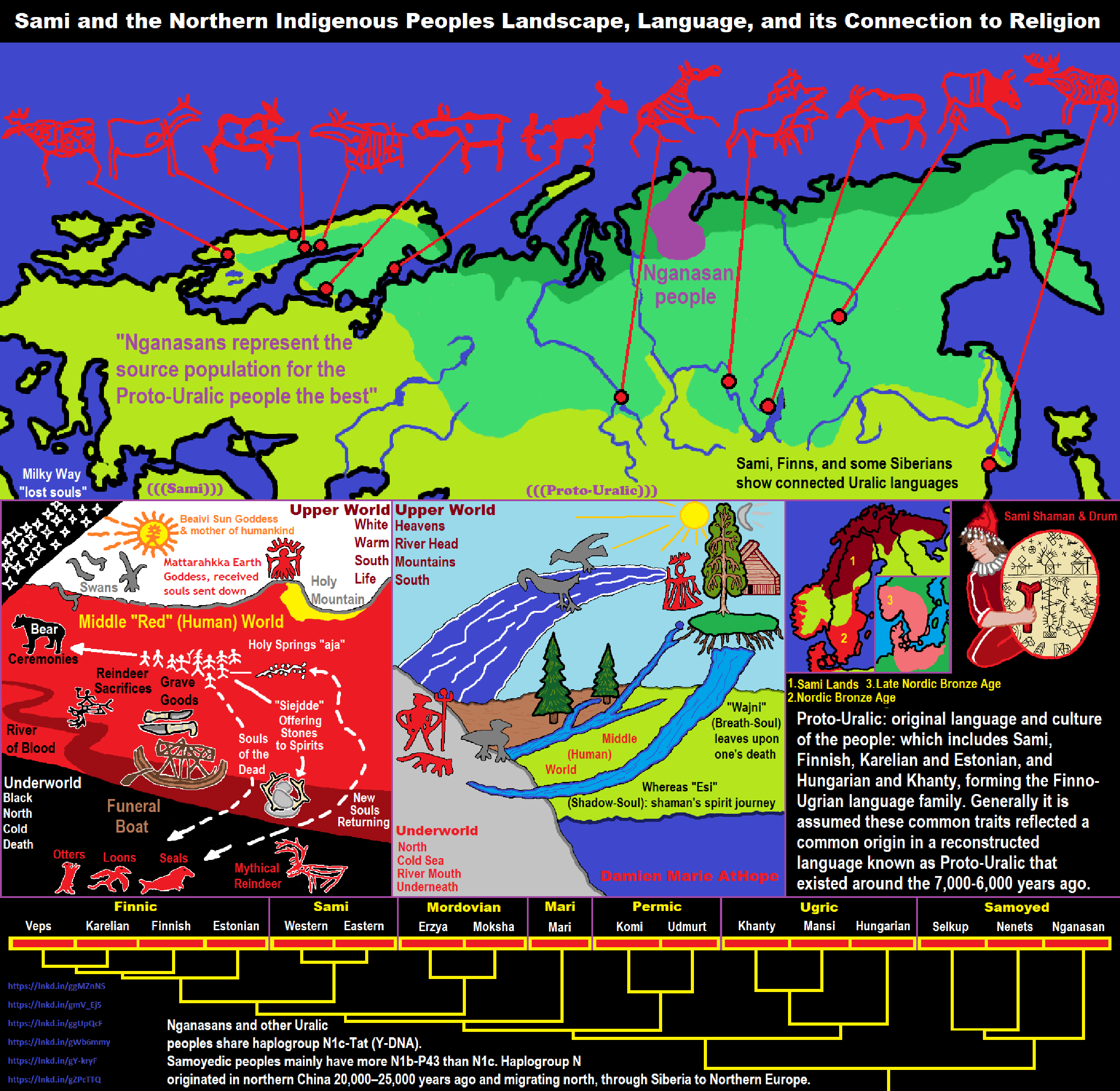
ref, ref, ref, ref, ref, ref, ref, ref, ref, ref, ref, ref, ref, ref, ref, ref, ref, ref, ref
Sámi people
“The Sámi people (also spelled Sami or Saami) are a Finno-Ugric-speaking people inhabiting the region of Sápmi (formerly known as Lapland), which today encompasses large northern parts of Norway, Sweden, Finland, and of the Murmansk Oblast, Russia, most of the Kola Peninsula in particular. The Sámi have historically been known in English as Lapps or Laplanders, but these terms are regarded as offensive by some Sámi people, who prefer the area’s name in their own languages, e.g. Northern Sami Sápmi. Their traditional languages are the Sámi languages, which are classified as a branch of the Uralic language family.” ref
“Traditionally, the Sámi have pursued a variety of livelihoods, including coastal fishing, fur trapping, and sheep herding. Their best-known means of livelihood is semi-nomadic reindeer herding. Currently about 10% of the Sámi are connected to reindeer herding, which provides them with meat, fur, and transportation. 2,800 Sámi people are actively involved in reindeer herding on a full-time basis in Norway. For traditional, environmental, cultural, and political reasons, reindeer herding is legally reserved for only Sámi people in some regions of the Nordic countries.” ref
“Speakers of Northern Sámi refer to themselves as Sámit (the Sámis) or Sápmelaš (of Sámi kin), the word Sápmi being inflected into various grammatical forms. Other Sámi languages use cognate words. As of around 2014, the current consensus among specialists was that the word Sámi was borrowed from the Proto-Baltic word *žēmē, meaning ‘land’ (cognate with Slavic zemlja (земля), of the same meaning).” ref
“The word Sámi has at least one cognate word in Finnish: Proto-Baltic *žēmē was also borrowed into Proto-Finnic, as *šämä. This word became modern Finnish Häme (Finnish for the region of Tavastia; the second ä of *šämä is still found in the adjective Hämäläinen). The Finnish word for Finland, Suomi, is also thought probably to derive ultimately from Proto-Baltic *žēmē, though the precise route is debated and proposals usually involve complex processes of borrowing and reborrowing. Suomi and its adjectival form suomalainen must come from *sōme-/sōma-.” ref
“In one proposal, this Finnish word comes from a Proto-Germanic word *sōma-, itself from Proto-Baltic *sāma-, in turn borrowed from Proto-Finnic *šämä, which was borrowed from *žēmē. The Sámi institutions—notably the parliaments, radio and TV stations, theatres, etc.—all use the term Sámi, including when addressing outsiders in Norwegian, Swedish, Finnish, or English. In Norwegian and Swedish, the Sámi are today referred to by the localized form Same.” ref
“The first probable historical mention of the Sámi, naming them Fenni, was by Tacitus, about AD 98. Variants of Finn or Fenni were in wide use in ancient times, judging from the names Fenni and Φίννοι (Phinnoi) in classical Roman and Greek works. Finn (or variants, such as skridfinn, ‘striding Finn’) was the name originally used by Norse speakers (and their proto-Norse speaking ancestors) to refer to the Sámi, as attested in the Icelandic Eddas and Norse sagas (11th to 14th centuries).” ref
“The etymology is somewhat uncertain, but the consensus seems to be that it is related to Old Norse finna, from proto-Germanic *finþanan (‘to find’), the logic being that the Sámi, as hunter-gatherers “found” their food, rather than grew it. This etymology has superseded older speculations that the word might be related to fen.” ref
“As Old Norse gradually developed into the separate Scandinavian languages, Swedes apparently took to using Finn to refer to inhabitants of what is now Finland, while the Sámi came to be called Lapps. In Norway, however, Sámi were still called Finns at least until the modern era (reflected in toponyms like Finnmark, Finnsnes, Finnfjord and Finnøy), and some northern Norwegians will still occasionally use Finn to refer to Sámi people, although the Sámi themselves now consider this to be an inappropriate term. Finnish immigrants to Northern Norway in the 18th and 19th centuries were referred to as Kvens to distinguish them from the Sámi “Finns”. Ethnic Finns (suomalaiset) are a distinct group from Sámi.” ref
“The languages of the Sámi, like other Uralic languages, are believed to originate from the region along the Volga, which is the longest river in Europe.[29] The Sámi have their roots in the middle and upper Volga region in the Corded Ware culture. These groups presumably started to move to the northwest from the early home region of the Uralic peoples in the second and third quarters of the second millennium BCE.” ref
“On their journey, they used the ancient river routes of northern Russia that had been in use for millennia. Some of these peoples, who may have originally spoken the same western Uralic language, stopped and stayed in the regions between Karelia, Ladoga, and Lake Ilmen, and even further to the east and to the southeast. The groups of these peoples that ended up in the Finnish Lakeland from 1600 to 1500 BCE later “became” the Sámi. The Sámi people arrived in their current homeland some time after the beginning of the Common Era.” ref
“The Sámi language first developed on the southern side of Lake Onega and Lake Ladoga and spread from there. When the speakers of this language extended to the area of modern-day Finland, they encountered groups of peoples who spoke a number of smaller ancient languages, which later became extinct. However, these languages left traces in the Sámi language. As the language spread further, it became segmented into dialects. The geographical distribution of the Sámi has evolved over the course of history. From the Bronze Age, the Sámi occupied the area along the coast of Finnmark and the Kola Peninsula.” ref
“This coincides with the arrival of the Siberian genome to Estonia and Finland, which may correspond with the introduction of the Finno-Ugric languages in the region. Petroglyphs and archeological findings such as settlements, dating from about 10,000 BCE can be found in Lapland and Finnmark, although these have not been demonstrated to be related to the Sámi people. These hunter-gatherers of the late Paleolithic and early Mesolithic were named Komsa by the researchers.” ref
Relationship between the Sámi and the Scandinavians
“The Sámi have a complex relationship with the Scandinavians (known as Norse people in the medieval era), the dominant peoples of Scandinavia, who speak Scandinavian languages and who founded and thus dominated the kingdoms of Norway and Sweden in which most Sámi people live. While the Sámi have lived in Fennoscandia for around 3,500 years, Sámi settlement of Scandinavia does not predate Norse/Scandinavian settlement of Scandinavia, as sometimes popularly assumed.” ref
“The migration of Germanic-speaking peoples to Southern Scandinavia happened independently and separate from the later Sami migrations into the northern regions. For centuries, the Sámi and the Scandinavians had relatively little contact; the Sámi primarily lived in the inland of northern Fennoscandia, while Scandinavians lived in southern Scandinavia and gradually colonized the Norwegian coast; from the 18th and especially the 19th century, the governments of Norway and Sweden started to assert sovereignty more aggressively in the north, and targeted the Sámi with Scandinavization policies aimed at forced assimilation from the 19th century.” ref
“Before the era of forced Scandinavization policies, the Norwegian and Swedish authorities had largely ignored the Sámi and did not interfere much in their way of life. While Norwegians moved north to gradually colonize the coast of modern-day Troms og Finnmark to engage in an export-driven fisheries industry prior to the 19th century, they showed little interest in the harsh and non-arable inland populated by reindeer-herding Sámi.” ref
“Unlike the Norwegians on the coast who were strongly dependent on their trade with the south, the Sámi in the inland lived off the land. From the 19th century, Norwegian and Swedish authorities started to regard the Sámi as a “backward” and “primitive” people in need of being “civilized”, imposing the Scandinavian languages as the only valid languages of the kingdoms and effectively banning Sámi language and culture in many contexts, particularly schools.” ref
“How far south the Sámi extended in the past has been debated among historians and archeologists for many years. The Norwegian historian Yngvar Nielsen, commissioned by the Norwegian government in 1889 to determine this question in order to settle contemporary questions of Sámi land rights, concluded that the Sámi had lived no farther south than Lierne in Nord-Trøndelag county until around 1500, when they started moving south, reaching the area around Lake Femund in the 18th century.” ref
“This hypothesis is still accepted among many historians, but has been the subject of scholarly debate in the 21st century. In recent years, several archaeological finds indicate a Sámi presence in southern Norway in the Middle Ages, and in southern Sweden, including finds in Lesja, in Vang, in Valdres, and in Hol and Ål in Hallingdal. Proponents of the Sámi interpretations of these finds assume a mixed population of Norse and Sámi people in the mountainous areas of southern Norway in the Middle Ages.” ref
“Until the arrival of bubonic plague in northern Norway in 1349, the Sámi and the Norwegians occupied very separate economic niches. The Sámi hunted reindeer and fished for their livelihood. The Norwegians, who were concentrated on the outer islands and near the mouths of the fjords, had access to the major European trade routes so that, in addition to marginal farming in the Nordland, Troms, and Finnmark counties, they were able to establish commerce, trading fish for products from the south. According to old Nordic texts, the Sea Sámi and the Mountain Sámi are two classes of the same people and not two different ethnic groups, as had been erroneously believed.” ref
“This socioeconomic balance greatly changed when bubonic plague came to northern Norway in December 1349. The Norwegians were closely connected to the greater European trade routes, along which the plague traveled; consequently, they were infected and died at a far higher rate than Sámi in the interior. Of all the states in the region, Norway suffered the most from this plague. Depending on the parish, 60 to 76 percent of northern Norwegian farms were abandoned following the plague, while land-rents, another measure of population, dropped to nine to 28% of pre-plague levels.” ref
“Although the population of northern Norway is sparse compared to southern Europe, the disease spread just as fast. The spread of the plague-carrying flea (Xenopsylla cheopsis) from the south was facilitated by the transport of wooden barrels holding wheat, rye, or wool, where the fleas were able to live, and even reproduce, for several months at a time. The Sámi lived on fish and reindeer meat, and did not eat wheat or rye. They lived in communities detached from the Norwegians; being only loosely connected to the European trade routes, they fared far better than the Norwegians.” ref
Mountain Sámi
“As the Sea Sámi settled along Norway’s fjords and inland waterways, pursuing a combination of farming, cattle raising, trapping, and fishing, the minority Mountain Sámi continued to hunt wild reindeer. Around 1500, they started to tame these animals into herding groups, becoming the well-known reindeer nomads, often portrayed by outsiders as following the traditional Sámi lifestyle.” ref
“The Mountain Sámi had to pay taxes to three states, Norway, Sweden, and Russia, as they crossed each border while following the annual reindeer migrations; this caused much resentment over the years. Between 1635 and 1659, the Swedish crown forced Swedish conscripts and Sámi cart drivers to work in the Nasa silver mine, causing many Sámis to emigrate from the area to avoid forced labor. As a result, the population of Pite– and Lule-speaking Sámi decreased greatly.” ref
“Sápmi is located in Northern Europe, includes the northern parts of Fennoscandia, and spans four countries: Norway, Sweden, Finland, and Russia. Non-Sámi and many regional maps have often called this same region Lapland as there is considerable regional overlap between Sápmi and the provinces of Lappland in Sweden and Lapland in Finland. Much of Sápmi falls outside of those provinces. Despite the terms use in tourism, Lapland can be either misleading or offensive, or both, to Sámi, depending on the context and where this word is used. Among the Sámi people, Sápmi is strictly used and acceptable.” ref
“The Sámi flag was inaugurated during the Sámi Conference in Åre, Sweden, on 15 August 1986. It was the result of a competition for which many suggestions were entered. The winning design was submitted by the artist Astrid Båhl from Skibotn, Norway. The motif (shown right) was derived from the shaman’s drum and the poem “Päiven Pārne'” (“Sons of the Sun”) by the South Sámi Anders Fjellner describing the Sámi as sons and daughters of the sun. The flag has the Sámi colors, red, green, yellow, and blue, and the circle represents the sun (red) and the moon (blue).” ref
“Many Sámi people continued to practice their religion up until the 18th century. Indigenous Sámi religion was a type of polytheism. (See Sámi deities.) There was some diversity due to the wide area that is Sápmi, allowing for the evolution of variations in beliefs and practices between tribes. The old beliefs are closely connected to the land, animism, and the supernatural. Sámi spirituality is often characterized by pantheism, a strong emphasis on the importance of personal spirituality and its interconnectivity with one’s own daily life, and a deep connection between the natural and spiritual “worlds.” ref
Among other roles, the Sámi shaman, or noaidi, enabled ritual communication with the supernatural through the use of tools such as drums, chants, sacred objects, and fly agaric. Some practices within the Old Sámi religion included natural sacred sites such as mountains, springs, land formations, as well as man-made ones such as petroglyphs and labyrinths.” ref
“The Sámi cosmology divides the universe into three worlds. The upper world is related to the South, warmth, life, and the color white. It is also the dwelling of the gods. The middle world is like the Norse Midgard, it is the dwelling of humans and it is associated with the color red. The third world is the underworld and it is associated with the color black, it represents the north, the cold and it is inhabited by otters, loons, seals, and mythical animals.” ref
Sámi religion shared some elements with Norse mythology, possibly from early contacts with trading Vikings (or vice versa). They were the last worshippers of Thor, as late as the 18th century according to contemporary ethnographers. Through a mainly French initiative from Joseph Paul Gaimard as part of his La Recherche Expedition, Lars Levi Læstadius began research on Sámi mythology. His work resulted in Fragments of Lappish Mythology, since by his own admission, they contained only a small percentage of what had existed.” ref
“The fragments were termed Theory of Gods, Theory of Sacrifice, Theory of Prophecy, or short reports about rumorous Sami magic and Sami sagas. Generally, he claims to have filtered out the Norse influence and derived common elements between the South, North, and Eastern Sámi groups. The mythology has common elements with other indigenous religions as well—such as those of indigenous peoples in Siberia and North America.” ref
“The term Sámi religion usually refers to the traditional religion, practiced by most Sámi until approximately the 18th century. Christianity was introduced by Roman Catholic missionaries as early as the 13th century. Increased pressure came after the Protestant Reformation, and rune drums were burned or sent to museums abroad.” ref
“In this period, many Sámi practiced their traditional religion at home, while going to church on Sunday. Since the Sámi were considered to possess “witchcraft” powers, they were often accused of sorcery during the 17th century and were the subjects of witchcraft trials and burnings.” ref
“In Norway, a major effort to convert the Sámi was made around 1720, when Thomas von Westen, the “Apostle of the Sámi”, burned drums, burned sacred objects, and converted people. Out of the estimated thousands of drums before this period, only about 70 are known to remain today, scattered in museums around Europe.” ref
“Sacred sites were destroyed, such as sieidi (stones in natural or human-built formations), álda and sáivu (sacred hills), springs, caves, and other natural formations where offerings were made. In the far east of the Sámi area, the Russian monk Trifon converted the Sámi in the 16th century. Today, St. George’s chapel in Neiden, Norway (1565), testifies to this effort.” ref
“Anthropologists have been studying the Sámi people for hundreds of years for their assumed physical and cultural differences from the rest of the Europeans. Recent genetic studies have indicated that the two most frequent maternal lineages of the Sámi people are the haplogroups V (neolithic in Europe and not found in Finland 1500 years ago) and U5b (ancient in Europe). “The Y-chromosomal variety in the Saami is also consistent with their European ancestry. It suggests that the large genetic separation of the Saami from other Europeans is best explained by assuming that the Saami are descendants of a narrow, distinctive subset of Europeans.” ref
“Y-chromosome haplogroup N-VL29 makes up 20%, came from Siberia 3500 years ago or more likely much later. Y-chromosome N-Z1936 makes up 20%, likely came from Siberia with Sámi language later. This tallies with archeological evidence suggesting that several different cultural groups made their way to the core area of Sámi from 8000 to 6000 BCE, presumably including some of the ancestors of present-day Sámi.” ref
“The “Nganassan” autosomic component now makes up more than 25% in the Sámi, but was 50% in the 3500-year old Kola population. The Mesolithic “Western European Hunter-Gatherer” (WHG) component is close to 15%, while that of the Neolithic “European early farmer” (LBK) is 10%. 50% is the Bronze Age “Yamna” component, the earliest trace of which is observed in the Pit–Comb Ware culture in Estonia, but in a 2.5-fold lower percentage. The Sámi have been found to be genetically unrelated to people of the Pitted Ware culture. The Pitted Ware culture are in turn genetically continuous with the original Scandinavian Hunter-Gatherers.” ref
Sámi shamanism
“Traditional Sámi spiritual practices and beliefs are based on a type of animism, polytheism, and what anthropologists may consider shamanism. The religious traditions can vary considerably from region to region within Sápmi.” ref
“Traditional Sámi religion is generally considered to be Animism. The Sámi belief that all significant natural objects (such as animals, plants, rocks, etc.) possess a soul, and from a polytheistic perspective, traditional Sámi beliefs include a multitude of spirits. Sámi traditional beliefs and practices commonly emphasize veneration of the dead and of animal spirits. The relationship with the local animals that sustain the people, such as the reindeer, are very important to the kin-group.” ref
Deities and animal spirits
“Aside from bear worship, there are other animal spirits such as the Haldi who watch over nature. Some Sámi people have a thunder god called Horagalles. Rana Niejta is “the daughter of the green, fertile earth”. The symbol of the world tree or pillar, which reaches up to the North Star and is similar to that found in Finnish mythology, may also be present.” ref
Laib Olmai, the forest spirit of some of the Sámi people, is traditionally associated with forest animals, which are regarded as his herds, and he is said to grant either good or bad luck in hunting. His favor was so important that, according to one author, believers said prayers and made offerings to him every morning and every evening.” ref
“In the landscape throughout Northern Scandinavia, one can find sieidis, places that have unusual land forms different from the surrounding countryside, and that can be considered to have spiritual significance. Each family or clan has its local spirits, to whom they make offerings for protection and good fortune. The Storjunkare are described sometimes as stones, having some likeness to a man or an animal, that were set up on a mountain top, or in a cave, or near rivers and lakes.” ref
“Honor was done to them by spreading fresh twigs under them in winter, and in summer leaves or grass. The Storjunkare had power over all animals, fish, and birds, and gave luck to those that hunted or fished for them. Reindeer were offered up to them, and every clan and family had its own hill of sacrifice.” ref
“A noaidi was a male mediator between the human world and saivo, the underworld, on the behalf of the community, usually using a Sámi drum and a domestic flute called a fadno in ceremonies.” ref
“A noaidi (Northern Sami: noaidi, Lule Sami: noajdde, Southern Sami: nåejttie, Skolt Sami: nōjjd, Ter Sami: niojte, Kildin Sami: noojd/nuojd, Pite Sami: nåjjde) is a shaman of the Sami people in the Nordic countries, playing a role in Sámi religious practices. Most noaidi practices died out during the 17th century, most likely because they resisted Christianization of the Sámi people and the king’s authority. Their actions were referred to in courts as “magic” or “sorcery” (cf. witchcraft). Several Sámi shamanistic beliefs and practices were similar to those of some Siberian cultures.” ref
“Noaidis, often referred to as the “Sámi shamans”, were the traditional healers and protectors of the Sami people. Noaidis were considered to have the role of mediator between humans and the spirits. To undertake this mediation, the noaidi were believed to be able to communicate with the spirit world, and to ask what sacrifice needed to be made by a person so that he might return to good health and be successful in the hunt for food. Sacrifices were designed by the noaidi were understood to reestablish a kind of balance between the mortal and immortal worlds.” ref
“Using a traditional drum, which is the most important symbol and tool of the Sámi noaidi, they invoked assistance from benevolent spirits and conducted out-of-body travel via the “free soul” with the help of other siida members. The Sámi distinguish between the “free soul” versus the more mundane “body soul”; the “body soul” is unable to traverse the divide separating the spiritual netherworld from the more mundane, corporeal, real world.” ref
Neo-shamanism, Sami, and traditional healing
“Today there are a number of Sámi who seek to return to the traditional Pagan values of their ancestors. There are also some Sámi who claim to be noaidi and offer their services through newspaper advertisements, in New Age arrangements, or for tourist groups. While they practice a religion based on that of their ancestors, widespread anti-pagan prejudice has caused these shamans to be generally not viewed as part of an unbroken Sámi religious tradition.” ref
“Traditional Sámi beliefs are composed of three intertwining elements: animism, shamanism, and polytheism. Sámi animism is manifested in the Sámi’s belief that all significant natural objects (such as animals, plants, rocks, etc.) possess a soul; and from a polytheistic perspective, traditional Sámi beliefs include a multitude of spirits.” ref
“Many contemporary practitioners are compared to practitioners of neo-paganism, as a number of neopagan religions likewise combine elements of ancient pagan religions with more recent revisions or innovations, but others feel they are attempting to revive or reconstruct indigenous Sámi religions as found in historic, folkloric sources and oral traditions.” ref
Ancestors and the Sami
“One of the most irreconcilable elements of the Sámi’s worldview from the missionaries’ perspective was the notion “that the living and the departed were regarded as two halves of the same family.” The Sámi regarded the concept as fundamental, while the Christians absolutely discounted any possibility of the dead having anything to do with the living. Since this belief was not just a religion, but a living dialogue with their ancestors, their society was concomitantly impoverished.” ref
List of Sami deities
“The Sami religion differed somewhat between regions and tribes. Although the deities were similar, their names varied between regions. The deities also overlapped: in one region, one deity could appear as several separate deities, and in another region, several deities could be united in to just a few. Because of these variations, the deities have been somewhat confused with each other.” ref
The main deities of the Sami were as follows:
- Akka – a group of fertility goddesses, including Maderakka, Juksakka, and Uksakka
- Beaivi – goddess of the sun, mother of human beings
- Bieggagallis – husband of the sun goddess, father of human beings
- Bieggolmai ‘Man of the Winds’ – god of the winds
- Biejjenniejte – goddess of healing and medicine, daughter of the Sun, Beaivi
- Horagalles – god of thunder. His name may mean “Thor-man”. He is also called “Grandfather”, Bajanolmmai, Dierpmis, and Tordöm.
- Jahbme akka – the goddess of the dead, and mistress of the underworld and the realm of the dead
- Ipmil ‘God’ – adopted as a native name for the Christian God (see the related Finnish word Jumala), also used for Radien-attje
- Lieaibolmmai – god of the hunt and of adult men
- Madder-Attje – husband of Maderakka and father of the tribe. While his wife gives newborns their bodies, he gives them their souls.
- Mano, Manna, or Aske – god of the moon
- Mubpienålmaj – the god of evil, influenced by the Christian Satan
- Radien-attje – Creator and high god, the creator of the world and the head divinity. In Sámi religion, he is passive or sleeping and is not often included in religious practice. He created the souls of human beings with his spouse. He was also called Waralden Olmai.
- Raedieahkka – wife of the high god Radien-attje. She created the souls of human beings with her spouse.
- Rana Niejta – spring goddess, the daughter of Radien-attje and Raedieahkka. Rana, meaning “green” or by extension “fertile”, was a popular name for Sámi girls.
- Radien-pardne – the son of Radien-attje and Raedieahkka. He acts as the proxy of his passive father, performing his tasks and carrying out his will.
- Ruohtta – god of sickness and death. He was depicted riding a horse.
- Stallo – feared cannibal giants of the wilderness
- Tjaetsieålmaj – “the man of water”, god of water, lakes, and fishing.” ref
Yanomami People
“The Yanomami, also spelled Yąnomamö or Yanomama, are a group of approximately 35,000 indigenous people who live in some 200–250 villages in the Amazon rainforest on the border between Venezuela and Brazil. The ethnonym Yanomami was produced by anthropologists on the basis of the word yanõmami, which, in the expression yanõmami thëpë, signifies “human beings.” This expression is opposed to the categories yaro (game animals) and yai (invisible or nameless beings), but also napë (enemy, stranger, non-Indian).” ref
“The first report of the Yanomami to the Northern world is from 1654, when an El Salvadorian expedition under Apolinar Diez de la Fuente visited some Ye’kuana people living on the Padamo River. Diez wrote:
By interlocution of an Uramanavi Indian, I asked Chief Yoni if he had navigated by the Orinoco to its headwaters; he replied yes, and that he had gone to make war against the Guaharibo [Yanomami] Indians, who were not very brave…and who will not be friends with any kind of Indian.” ref
“From approximately 1630 to 1720, the other river-based indigenous societies who lived in the same region were wiped out or reduced as a result of slave-hunting expeditions by the conquistadors and bandeirantes. How this affected the Yanomami is unknown. Sustained contact with the outside world began in the 1950s with the arrival of members of the New Tribes Mission as well as Catholic missionaries from the Society of Jesus and Salesians of Don Bosco.” ref
“The Yanomami do not recognize themselves as a united group, but rather as individuals associated with their politically autonomous villages. Yanomami communities are grouped together because they have similar ages and kinship, and militaristic coalitions interweave communities together. The Yanomami have common historical ties to Carib speakers who resided near the Orinoco river and moved to the highlands of Brazil and Venezuela, the location the Yanomami currently occupy.” ref
“Mature men hold most political and religious authority. A tuxawa (headman) acts as the leader of each village, but no single leader presides over the whole of those classified as Yanomami. Headmen gain political power by demonstrating skill in settling disputes both within the village and with neighboring communities. A consensus of mature males is usually required for action that involves the community, but individuals are not required to take part. Local descent groups also play important roles in regulating marriages and settling disputes within villages.” ref
“Groups of Yanomami live in villages usually consisting of their children and extended families. Villages vary in size, but usually contain between 50 and 400 people. In this largely communal system, the entire village lives under a common roof called the shabono. Shabonos have a characteristic oval shape, with open grounds in the center measuring an average of 100 yards (91 m). The shabono shelter constitutes the perimeter of the village, if it has not been fortified with palisades.” ref
“Under the roof, divisions exist marked only by support posts, partitioning individual houses and spaces. Shabonos are built from raw materials from the surrounding rainforest, such as leaves, vines, and tree trunks. They are susceptible to heavy damage from rains, winds, and insect infestation. As a result, new shabonos are constructed every 4 to 6 years.” ref
“The Yanomami can be classified as foraging horticulturalists, depending heavily on rainforest resources; they use slash-and-burn horticulture, grow bananas, gather fruit, and hunt animals and fish. Crops compose up to 75% of the calories in the Yanomami diet. Protein is supplied by wild resources obtained through gathering, hunting, and fishing. When the soil becomes exhausted, Yanomami frequently move to avoid areas that have become overused, a practice known as shifting cultivation.” ref
“Children stay close to their mothers when young; most of the childrearing is done by women. Yanomami groups are a famous example of the approximately fifty documented societies that openly accept polyandry, though polygyny among Amazonian tribes has also been observed. Many unions are monogamous. Polygamous families consist of a large patrifocal family unit based on one man, and smaller matrifocal subfamilies: each woman’s family unit, composed of the woman and her children. Life in the village is centered around the small, matrilocal family unit, whereas the larger patrilocal unit has more political importance beyond the village.” ref
“Males of the Yanomami are said to commit significant intervals of bride service living with their in-laws, and levirate or Sororate marriage might be practiced in the event of the death of a spouse. Kin groups tend to be localized in villages and their genealogical depth is rather shallow. Kinship is critical in the arrangement of marriage and very strong bonds develop between kin groups who exchange women. Their kinship system can be described in terms of Iroquois classificatory pattern. To quote anthropologist Napoleon Chagnon, “In a word, everyone in Yanomamo society is called by some kinship term that can be translated into what we would call blood relatives.” ref
“The Yanomami are known as hunters, fishers, and horticulturists. The women cultivate cooking plantains and cassava in gardens as their main crops. Men do the heavy work of clearing areas of forest for the gardens. Another food source for the Yanomami is grubs. Often the Yanomami will cut down palms in order to facilitate the growth of grubs. The traditional Yanomami diet is very low in edible salt. Their blood pressure is characteristically among the lowest of any demographic group. For this reason, the Yanomami have been the subject of studies seeking to link hypertension to sodium consumption.” ref
“Rituals are a very important part of Yanomami culture. The Yanomami celebrate a good harvest with a big feast to which nearby villages are invited. The Yanomami village members gather large amounts of food, which helps to maintain good relations with their neighbors. They also decorate their bodies with feathers and flowers. During the feast, the Yanomami eat a lot, and the women dance and sing late into the night.” ref
“Hallucinogens or entheogens, known as yakoana or ebene, are used by Yanomami shamans as part of healing rituals for members of the community who are ill. Yakoana also refers to the tree from which it is derived, Virola elongata. Yopo, derived from a different plant with hallucinogenic effects (Anadenanthera peregrina), is usually cultivated in the garden by the shaman. The Xamatari also mix the powdered bark of Virola elongata with the powdered seeds of yopo to create the drug ebene. The drugs facilitate communication with the hekura, spirits that are believed to govern many aspects of the physical world. Women do not engage in this practice, known as shapuri.” ref
“The Yanomami people practice ritual endocannibalism, in which they consume the bones of deceased kinsmen. The body is wrapped in leaves and placed in the forest some distance from the shabono; then after insects have consumed the soft tissue (usually about 30 to 45 days), the bones are collected and cremated. The ashes are then mixed with a kind of soup made from bananas, which is consumed by the entire community.” ref
“The ashes may be preserved in a gourd and the ritual repeated annually until the ashes are gone. In daily conversation, no reference may be made to a dead person except on the annual “day of remembrance”, when the ashes of the dead are consumed and people recall the lives of their deceased relatives. This tradition is meant to strengthen the Yanomami people and keep the spirit of that individual alive.” ref
“The women are responsible for many domestic duties and chores, excluding hunting and killing game for food. Although the women do not hunt, they do work in the gardens and gather fruits, tubers, nuts, and other wild foodstuffs. The garden plots are sectioned off by family, and grow bananas, plantains, sugarcane, mangoes, sweet potatoes, papayas, cassava, maize, and other crops. Yanomami women cultivate until the gardens are no longer fertile, and then move their plots. Women are expected to carry 70 to 80 pounds (32 to 36 kg) of crops on their backs during harvesting, using bark straps and woven baskets.” ref
“In the mornings, while the men are off hunting, the women and young children go off in search of termite nests and other grubs, which will later be roasted at the family hearths. The women also pursue frogs, terrestrial crabs, or caterpillars, or even look for vines that can be woven into baskets. While some women gather these small sources of food, other women go off and fish for several hours during the day. The women also prepare cassava, shredding the roots and expressing the toxic juice, then roasting the flour to make flat cakes (known in Spanish as casabe), which they cook over a small pile of coals.” ref
“Yanomami women are expected to take responsibility for the children, who are expected to help their mothers with domestic chores from a very young age, and mothers rely very much on help from their daughters. Boys typically become the responsibility of the male members of the community after about age 8.” ref
“Using small strings of bark and roots, Yanomami women weave and decorate baskets. They use these baskets to carry plants, crops, and food to bring back to the shabono. They use a red berry known as onoto or urucu to dye the baskets, as well as to paint their bodies and dye their loin cloths. After the baskets are painted, they are further decorated with masticated charcoal pigment.” ref
“The start of menstruation symbolizes the beginning of womanhood. Girls typically start menstruation around the ages of 12 to 13. Girls are often betrothed before menarche and the marriage may only be consummated once the girl starts menstruating, though the taboo is often violated and many girls become sexually active before then.” ref
“The Yanomami word for menstruation (roo) translates literally as “squatting” in English, as they use no pads or cloths to absorb the blood. Due to the belief that menstrual blood is poisonous and dangerous, girls are kept hidden away in a small tent-like structure constructed of a screen of leaves. A deep hole is built in the structure over which girls squat, to “rid themselves” of their blood. These structures are regarded as isolation screens.” ref
“The mother is notified immediately, and she, along with the elder female friends of the girl, are responsible for disposing of her old cotton garments and must replace them with new ones symbolizing her womanhood and availability for marriage. During the week of that first menstrual period, the girl is fed with a stick, for she is forbidden from touching the food in any way. While on confinement she has to whisper when speaking and she may speak only to close kin, such as sisters or her mother, but never a male.” ref
“Up until the time of menstruation, girls are treated as children, and are only responsible for assisting their mothers in household work. When they approach the age of menstruation, they are sought out by males as potential wives. Puberty is not seen as time period with male Yanomami children, but it is considered very important for females.” ref
“After menstruating for the first time, the girls are expected to leave childhood and enter adulthood, and take on the responsibilities of a grown Yanomami woman. After a young girl gets her period, she is forbidden from showing her genitalia and must keep herself covered with a loincloth. The menstrual cycle of Yanomami women does not occur frequently due to constant nursing or child birthing, and is treated as a very significant occurrence only at this time.” ref
“Yanomaman languages comprise four main varieties: Ninam, Sanumá, Waiká, and Yanomamö. Many local variations and dialects also exist, such that people from different villages cannot always understand each other. Many linguists consider the Yanomaman family to be a language isolate, unrelated to other South American indigenous languages. The origins of the language are obscure. In early anthropological studies, the Yanomami culture was described as being permeated with violence. The Yanomami people have a history of acting violently not only towards other tribes, but towards one another.” ref
“An influential ethnography by anthropologist Napoleon Chagnon described the Yanomami as living in “a state of chronic warfare”. Chagnon’s account and similar descriptions of the Yanomami portrayed them as aggressive and warlike, sparking controversy amongst anthropologists and creating an enormous interest in the Yanomami. The debate centered around the degree of violence in Yanomami society, and the question of whether violence and warfare were best explained as an inherent part of Yanomami culture, or rather as a response to specific historical situations.” ref
“Writing in 1985, anthropologist Jacques Lizot [fr], who had lived among the Yanomami for more than twenty years, stated:
I would like my book to help revise the exaggerated representation that has been given of Yanomami violence. The Yanomami are warriors; they can be brutal and cruel, but they can also be delicate, sensitive, and loving. Violence is only sporadic; it never dominates social life for any length of time, and long peaceful moments can separate two explosions. When one is acquainted with the societies of the North American plains or the societies of the Chaco in South America, one cannot say that Yanomami culture is organized around warfare as Chagnon does.” ref
“Anthropologists working in the ecologist tradition, such as Marvin Harris, argued that a culture of violence had evolved among the Yanomami through competition resulting from a lack of nutritional resources in their territory.” ref
“However, the 1995 study “Yanomami Warfare”, by R. Brian Ferguson, examined all documented cases of warfare among the Yanomami and concluded:
Although some Yanomami really have been engaged in intensive warfare and other kinds of bloody conflict, this violence is not an expression of Yanomami culture itself. It is, rather, a product of specific historical situations: The Yanomami make war not because Western culture is absent, but because it is present, and present in certain specific forms. All Yanomami warfare that we know about occurs within what Neil Whitehead and I call a “tribal zone”, an extensive area beyond state administrative control, inhabited by nonstate people who must react to the far-flung effects of the state presence.” ref
“Ferguson stresses the idea that contrary to Chagnon’s description of the Yanomami as unaffected by Western culture, the Yanomami experienced the effects of colonization long before their territory became accessible to Westerners in the 1950s, and that they had acquired many influences and materials from Western culture through trade networks much earlier.” ref
“Lawrence Keeley questioned Ferguson’s analysis, writing that the character and speed of changes caused by contact with civilization are not well understood, and that diseases, trade items, weapons, and population movements likely all existed as possible contributors to warfare before civilization.” ref
“Violence is one of the leading causes of Yanomami death. Up to half of all Yanomami males die violent deaths in the constant conflict between neighboring communities over local resources. Often these confrontations lead to Yanomami leaving their villages in search of new ones. Women are often victims of physical abuse and anger. Inter-village warfare is common, but does not too commonly affect women.” ref
“When Yanomami tribes fight and raid nearby tribes, women are often raped, beaten, and brought back to the shabono to be adopted into the captor’s community. Wives may be beaten frequently, so as to keep them docile and faithful to their husbands. Sexual jealousy causes much of the violence. Women are beaten with clubs, sticks, machetes, and other blunt or sharp objects. Burning with a branding stick occurs often, and symbolizes a male’s strength or dominance over his wife.” ref
“Yanomami men have been known to kill children while raiding enemy villages. Helena Valero, a Brazilian woman kidnapped by Yanomami warriors in the 1930s, witnessed a Karawetari raid on her tribe:
They killed so many. I was weeping for fear and for pity but there was nothing I could do. They snatched the children from their mothers to kill them, while the others held the mothers tightly by the arms and wrists as they stood up in a line. All the women wept… The men began to kill the children; little ones, bigger ones, they killed many of them.” ref
“Following the increase in threats and attacks against the uncontacted Yanomami, member of parliament Joenia Wapichana, Dario Kopenawa Yanomami, and some other Brazilian indigenous leaders met with Michelle Bachelet, United Nations High Commissioner for Human Rights, to assess the inability of the government to protect their constitutional rights. On September 13th, 2021, in her report to the United Nations Human Rights Council, Michelle Bachelet declared that she was “alarmed by recent attacks against members of the Yanomami and Munduruku,” in Brazil, “by illegal miners in the Amazon.” ref
Matsés People
“The Matsés or Mayoruna are an indigenous people of the Peruvian and Brazilian Amazon. The tribe’s ancestral lands are currently being encroached by illegal logging practices and poaching. These homelands are located between the Javari and Galvez rivers. The Matsés have guarded their lands from both other indigenous tribes and outsider colonials.” ref
“The approximately 3,200 Matsés people speak the Matsés language which belongs to the Panoan language family. In the last thirty years, they have become a largely settled people living mostly in permanent forest settlements. However, they still rely on hunting and gathering for most of their subsistence. Their main source of income comes from selling peccary hides and meat.” ref
“The word Matsés comes from the word for “people” in the Matsés language. They are also known as the Mayoruna. The name Mayoruna comes from the Quechua (Runa Simi) language and means “river people.” In Brazil the Matsés people are generally referred to as Mayorunas, while in Peru they are usually called Matsés.” ref
The Matsés have an elaborate knowledge of the plant and animal life of the surrounding rainforest. Little is imported into the Matsés communities and most of what they need for survival comes from the rainforest. Traditionally, they hunted with bows and arrows.” ref
In the animist Matsés worldview, there is no distinction between the physical and spiritual worlds, and spirits are present throughout the world. The Matsés believe that animal spirits determine health and success in hunting. They are careful not to offend animal spirits, and have many taboos for hunting different animal species.” ref
Plants, especially trees, hold a complex and important interest for the Matsés. Each plant is associated with an animal spirit. When a plant product is used as a medicine, it is typically applied externally, and the shaman talks to the animal spirit associated with that plant.” ref
Bows and arrows are the main weapons of the Matsés culture, although they are currently rarely used in personal conflict. Generally they are only used for hunting animals. The Matsés were never known to use war clubs as do the neighboring Korubo. Historically, they used blowguns, similar to the Matis tribe of Brazil; however, they recently abandoned blowguns in favor of bows and arrows.” ref
Matsés families often practice polygamy. Cross-cousin marriages are most common. Marriages are primarily between cousins, with a man marrying the daughter of his father’s sister (his aunt). The Matsés are very divided and politically unorganized. Each village has its own chief and there is little centralized authority for the tribe. Lack of political organization has made it difficult for the Matsés people to obtain medical assistance from the outside world.” ref
Koryaks People
“Koryaks (or Koriak, Russian: Коряки) are an indigenous people of the Russian Far East, who live immediately north of the Kamchatka Peninsula in Kamchatka Krai and inhabit the coastlands of the Bering Sea. The cultural borders of the Koryaks include Tigilsk in the south and the Anadyr basin in the north. Neighbors of the Koryaks include the Evens to the west, the Alutor to the south (on the isthmus of Kamchatka Peninsula), the Kerek to the east, and the Chukchi to the northeast.” ref
“The Koryaks are culturally similar to the Chukchis of extreme northeast Siberia. The Koryak language and Alutor (which is often regarded as a dialect of Koryak), are linguistically close to the Chukchi language. All of these languages are members of the Chukotko-Kamchatkan language family. They are more distantly related to the Itelmens on the Kamchatka Peninsula. All of these peoples and other, unrelated minorities in and around Kamchatka are known collectively as Kamchadals.” ref
“The Koryak are typically split into two groups. The coastal people are called Nemelan (or Nymylan) meaning ‘village dwellers’, due to their living in villages. Their lifestyle is based on local fishing and marine mammal hunting. The inland Koryak, reindeer herders, are called Chaucu (or Chauchuven), meaning ‘rich in reindeer’. They are more nomadic, following the herds as they graze with the seasons.” ref
“The name Koryak was from the exonym word ‘Korak’, meaning ‘with the reindeer (kor)’ in a nearby group Chukotko-Kamchatkan language.[4] The earliest references to the name ‘Koryak’ were recorded in the writings of the Russian cossack Vladimir Atlasov, who conquered Kamchatka for the Tsar in 1695. The variant name was adopted by Russia in official state documents, hence popularizing it ever since.” ref
“The origin of the Koryak is unknown. Anthropologists have speculated that a land bridge connected the Eurasian and North American continent during Late Pleistocene. It is possible that migratory peoples crossed the modern-day Koryak land en route to North America. Scientists have suggested that people traveled back and forth between this area and Haida Gwaii before the ice age receded. They theorize that the ancestors of the Koryak had returned to Siberian Asia from North America during this time. Cultural and some linguistic similarities exist between the Nivkh and the Koryak.” ref
“The Koryak once occupied a much larger area of the Russian Far East. Their overlapping borders extended to the Nivkh areas in Khabarovsk Krai until the Evens arrived, and pushed them into their present region. A smallpox epidemic in 1769-1770 and warfare with Russian Cossacks reduced the Koryak population from 10-11,000 in 1700 to 4,800 in 1800.” ref
“Families usually gathered into groups of six or seven, forming bands. The nominal chief had no predominating authority, and the groups relied on consensus to make decisions, resembling common small group egalitarianism. Today the Koryaks also buy processed food, such as bread, cereal, and canned fish. They sell some reindeer each year for money, but can build up their herds due to the large population of reindeer.” ref
“The lives of the people in the interior revolved around reindeer, their main source of food. They also used all the parts of its body to make sewing materials and clothing, tools, and weapons. The meat was mostly eaten roasted and the blood, marrow, and milk were drunk or eaten raw. The liver, heart, kidneys, and tongue were considered delicacies. Salmon and other freshwater fish, as well as berries and roots, played a major part in the diet, as reindeer flesh did not contain some necessary vitamins and minerals, nor dietary fibre, needed to survive in the harsh tundra.” ref
“Clothing was made out of reindeer hides, but nowadays men and women often have replaced that with cloth. The men wore baggy pants and a hide shirt, which often had a hood attached to it, boots, and traditional caps made of reindeer skin. They still use the boots and caps. The women wore the same as the men, but with a longer shirt reaching to the calves. Today women often wear a head cloth and skirt, but wear the reindeer skin robe in cold weather.” ref
“The Koryak lived in domed shaped tents, called jajanga, or yaranga (from the more famous Chukchi term) similar to a tipi of the American Plains Indians, but less vertical, while some lived in yurts. The framework was covered in many reindeer skins. Few families still use the yaranga as dwellings, but some use them for trips to the tundra. The centre of the yaranga had a hearth, which has been replaced by an iron stove. Reindeer hide beds are placed to the east in the chum. They used small cupboards to store the families’ food, clothing, and personal items.” ref
The inland Koryak rode reindeer to get around, cutting off their antlers to prevent injuries. They also fitted a team of reindeer with harnesses and attached them to sleds to transport goods and people when moving camp. Today the Koryak use snowmobiles more often than reindeer. Most inter-village transport is by air or boat, although tracked vehicles are used for travel to neighboring villages.” ref
“They developed snowshoes, which they used in winter (and still do) when the snow is deep. Snowshoes are made by lashing reindeer sinew and hide strips to a tennis racket-shaped birch bark or willow hoop. The sinew straps are used to attach the shoe to the foot. Children learned to ride a reindeer, sleigh, and use snowshoes at a very young age. The other Koryak were skilled seafarers hunting whales and other marine mammals.” ref
“Koryaks believe in a Supreme Being whom they call by various names: ŋajŋənen (Universe/World), ineɣitelʔən (Supervisor), ɣət͡ɕɣoletənvəlʔən (Master-of-the-Upper-World), ɣət͡ɕɣolʔən (One-on-High), etc. He is considered to reside in Heaven with his family and when he wishes to punish mankind for immoral acts, he falls asleep and thus leaves man vulnerable to unsuccessful hunting and other ills.” ref
“Koryak mythology centers on the supernatural shaman Quikil (Big-Raven), who was created by the Supreme Being as the first man and protector of the Koryak. Big Raven myths are also found in Southeast Alaska in the Tlingit culture, and among the Haida, Tsimshian, and other natives of the Pacific Northwest Coast Amerindians.” ref
“Koryak lands are mountains and volcanic, covered in mostly Arctic tundra. Coniferous trees lie near the southern regions along the coast of the Shelekhova Bay of the Sea of Okhotsk. The northern regions inland are much colder, where only various shrubs grow, but these are enough to sustain reindeer migration.” ref
“The mean temperature in winter is −13 °C (9 °F) while the short summers are +12 °C (54 °F). The area they covered before Russian colonization was 301,500 km² (116,410 mi²), roughly corresponding to the Koryak Okrug, of which the administrative centre is Palana. Today the Koryak are the largest minority group with 8,743 people. The krai’s population is now majority ethnic Russian, descendants of the Cossack colonizers.” ref
Kyrgyz people
“Haplogroup R* Y-DNA (xR1, R2) was found in 24,000-year-old remains from Mal’ta in Siberia near Lake Baikal. In 2013, R-M207 was found in one out of 132 males from the Kyrgyz people of East Kyrgyzstan. The Kyrgyz people (also spelled Kyrghyz, Kirgiz, and Kirghiz) are a Turkic ethnic group native to Central Asia, primarily Kyrgyzstan.” ref, ref
“There are several theories on the origin of ethnonym Kyrgyz. It is often said to be derived from the Turkic word kyrk (“forty”), with –iz being an old plural suffix, so Kyrgyz literally means “a collection of forty tribes”. It also means “imperishable”, “inextinguishable”, “immortal”, “unconquerable” or “unbeatable”, as well as its association with the epic hero Manas, who – according to a founding myth – unified the 40 tribes against the Khitans. A rival myth, recorded in 1370 in the History of Yuan, concerns 40 women born on a steppe motherland.” ref
Nomads in Kyrgyzstan
“The earliest records of the ethnonym appear to have been the Chinese transcriptions Gekun (鬲昆, LH *kek-kuən < Old Chinese: *krêk-kûn) and Jiankun (堅昆, LH *ken-kuən < OC: *kên-kûn). Those suggest that the original ethnonym was *kirkur ~ kirgur and/or *kirkün, and another transcription Jiegu (結骨, EMC: *kέt-kwət) suggests *kirkut / kirgut. Yury Zuev proposed that the ethnonym possibly means ‘field people, field Huns‘ (cf. Tiele tribal name 渾 Hún < MC *ɣuən).” ref
“Peter Golden reconstructs *Qïrğïz < *Qïrqïz< *Qïrqïŕ and suggests a derivation from Old Turkic qır ‘gray’ (horse color) plus suffix -q(X)r/ğ(X)r ~ k(X)z/g(X)z. Besides, Chinese scholars later used a number of different transcriptions for the Kyrgyz people: these include Gegu (紇骨), Jiegu (結骨), Hegu (紇骨), Hegusi (紇扢斯), Hejiasi (紇戛斯), Hugu (護骨), Qigu (契骨), or Juwu (居勿), and then, during the reign of Tang Emperor Wuzong, Xiajiasi (黠戛斯), said to mean “red face.” ref
“Edwin G. Pulleyblank surmises that “red face” was possibly a folk etymology provided by an interpreter who explained the ethnonym based on Turkic qïzïl ~ qizqil, meaning ‘red’. By the time of the Mongol Empire, the ethnonym’s original meaning had apparently been forgotten – as was shown by variations in readings of it across different reductions of the History of Yuan. This may have led to the adoption of Kyrgyz and its mythical explanation.” ref
“During the 18th and 19th centuries, European writers used the early Romanized form Kirghiz – from the contemporary Russian киргизы – to refer not only to the modern Kyrgyz, but also to their more numerous northern relatives, the Kazakhs. When distinction had to be made, more specific terms were used: the Kyrgyz proper were known as the Kara-Kirghiz (“Black Kirghiz”, from the color of their tents), and the Kazakhs were named the Kaisaks. or “Kirghiz-Kazaks.” ref
“The Kyrgyz are a Turkic ethnic group. Recent linguistic, genetic, and archaeological evidence suggests that the earliest Turkic peoples descended from agricultural communities in Northeast China who moved westwards into Mongolia in the late 3rd millennium BCE, where they adopted a pastoral lifestyle. By the early 1st millennium BC, these peoples had become equestrian nomads. In subsequent centuries, the steppe populations of Central Asia appear to have been progressively Turkified by a East Asian dominant minority moving out of Mongolia.” ref
“The early Kyrgyz people, known as Yenisei Kyrgyz, have their origins in the western parts of modern-day Mongolia and first appear in written records in the Chinese annals of the Sima Qian‘s Records of the Grand Historian (compiled 109 BC to 91 BC), as Gekun (鬲昆, 隔昆) or Jiankun (堅昆). The Middle Age Chinese composition Tanghuiyao of the 8–10th century transcribed the name “Kyrgyz” as Jiegu (Kirgut), and their tamga was depicted as identical to the tamga of present-day Kyrgyz tribes Azyk, Bugu, Cherik, Sary Bagysh, and few others.” ref
“According to recent historical findings, Kyrgyz history dates back to 201 BCE. The Yenisei Kyrgyz lived in the upper Yenisey River valley, central Siberia. In Late Antiquity the Yenisei Kyrgyz were a part of the Tiele people. Later, in the Early Middle Ages, the Yenisei Kyrgyz were a part of the confederations of the Göktürk and Uyghur Khaganates.” ref
“In 840 a revolt led by the Yenisei Kyrgyz brought down the Uyghur Khaganate, and brought the Yenisei Kyrgyz to a dominating position in the former Second Turkic Khaganate. With the rise to power, the center of the Kyrgyz Khaganate moved to Jeti-su, and brought about a spread south of the Kyrgyz people, to reach Tian Shan mountains and Xinjiang, bringing them into contact with the existing peoples of western China, especially Tibet.” ref
“By the 16th century the carriers of the ethnonym Kirgiz lived in South Siberia, Xinjiang, Tian Shan, Pamir-Alay, Middle Asia, Urals (among Bashkirs), in Kazakhstan. In the Tian Shan and Xinjiang area, the term Kyrgyz retained its unifying political designation, and became a general ethnonym for the Yenisei Kirgizes and aboriginal Turkic tribes that presently constitute the Kyrgyz population. Though it is obviously impossible to directly identify the Yenisei and Tien Shan Kyrgyz, a trace of their ethnogenetical connections is apparent in archaeology, history, language, and ethnography. A majority of modern researchers came to the conclusion that the ancestors of Kyrgyz tribes had their origin in the most ancient tribal unions of Sakas/Scythians, Wusun/Issedones, Dingling, Mongols, and Huns.” ref
“Also, there follow from the oldest notes about the Kyrgyz that the definite mention of Kyrgyz ethnonym originates from the 6th century. There is certain probability that there was relation between Kyrgyz and Gegunese already in the 2nd century BC, next, between Kyrgyz and Khakases since the 6th century AD, but there is quite missing a unique mention. The Kyrgyz as ethnic group are mentioned quite unambiguously in the time of Genghis Khan rule (1162–1227), when their name replaces the former name Khakas.” ref
“The genetic makeup of the Kyrgyz is consistent with their origin as a mix of tribes. For instance, 63% of modern Kyrgyz men of Jumgal District are Haplogroup R1a1 (Y-DNA). Low diversity of Kyrgyz R1a1 indicates a founder effect within the historical period. Other groups of Kyrgyz especially Southwest Kyrgyz show considerably lower haplogroup R frequencies and almost lack haplogroup N (except for the Kyrgyz from Pamir).” ref
“One study from Di Cristofaro et al. (2013) reported the results of analysis of the Y-DNA of 132 Kyrgyz individuals from Kyrgyzstan (40 from Central Kyrgyzstan, 37 from Northwest Kyrgyzstan, 35 from East Kyrgyzstan, and 20 from Southwest Kyrgyzstan), finding that they belonged to haplogroup R (78/132 = 59.1%, including 72/132 = 54.5% R1a-M198/M17, 3/132 = 2.3% R1b-L23(xU106, S116, U152), 2/132 = 1.5% R1b-M478/M73, and 1/132 = 0.76% R-M207(xR1a-SRY1532.2, R1b-M343, R2-M479)), haplogroup C2-M217 (26/132 = 19.7%, including 11/132 = 8.3% C-M401, 7/132 = 5.3% C-M532(xM86, M504, M546, M401), 7/132 = 5.3% C-M86, and 1/132 = 0.76% C-M386/PK2(xM407, M532)), haplogroup O (8/132 = 6.1%, including 5/132 = 3.8% O-M134(xM117), 2/132 = 1.5% O-M122(xKL2, P201), and 1/132 = 0.76% O-M95), haplogroup J (7/132 = 5.3%, including 2/132 = 1.5% J2a-P55(xM530, M322, M67), 1/132 = 0.76% J2a-M410(xP55), 1/132 = 0.76% J2a-M67(xM92), 1/132 = 0.76% J2b-M241, 1/132 = 0.76% J1-Page8, and 1/132 = 0.76% J1-M267(xPage8, short DYS388)), haplogroup N (6/132 = 4.5%, including 5/132 = 3.8% N-M231(xP43, Tat) and 1/132 = 0.76% N-P43), haplogroup G (2/132 = 1.5%, including 1/132 = 0.76% G2a-P16 and 1/132 = 0.76% G2a-P303), haplogroup L (2/132 = 1.5%, including 1/132 = 0.76% L-M76 and 1/132 = 0.76% L-M357), haplogroup E-M81 (1/132 = 0.76%), haplogroup H-M82 (1/132 = 0.76%), and haplogroup Q-M346 (1/132 = 0.76%).” ref
“Depending on the geographical location of samples, West Eurasian mtDNA haplogroup lineages make up 27% to 42.6% in the Kyrgyz, with haplogroup mtDNA H being the most predominant West Eurasian mtDNA haplogroup at about 14.2% (range 8.3% Talas to 21.3% Sary-Tash) among the Kyrgyz. However, the majority of Kyrgyz belong to East Eurasian mtDNA haplogroups, with mtDNA haplogroup D (approx. 20.2%, range 14.6% Talas to 25.5% Sary-Tash) and D4 in particular (approx. 18.5%) being the most frequent Eastern Eurasian lineage among them.” ref
“According to a genetic study based on geographic location of the 26 Central Asian populations shows the admixture proportions of East Eurasian ancestry is predominant in most Kyrgyz living in Kyrgyzstan. East Eurasian ancestry makes up roughly two-thirds with exceptions of Kyrgyz living in Tajikistan and the western areas of Kyrgyzstan where it forms only half.” ref
“The Kyrgyz state reached its greatest extent after defeating the Uyghur Khaganate in 840 AD, in alliance with the Chinese Tang dynasty. Various Turkic peoples ruled them until 1685, when they came under the control of the Oirats (Dzungars).” ref
“The Kirghiz khagans of the Yenisei Kirghiz Khaganate claimed descent from the Han Chinese general Li Ling, which was mentioned in the diplomatic correspondence between the Kirghiz khagan and the Tang Dynasty emperor, since the Tang imperial Li family claimed descent from Li Ling’s grandfather, Li Guang. The Kirghiz qaghan assisted the Tang dynasty in destroying the Uyghur Khaganate and rescuing the Princess Taihe from the Uyghurs. They also killed a Uyghur khagan in the process.” ref
“Then Kyrgyz quickly moved as far as the Tian Shan range and maintained their dominance over this territory for about 200 years. In the 12th century, however, Kyrgyz domination had shrunk to the Altai and Sayan Mountains as a result of Mongol expansion. With the rise of the Mongol Empire in the 13th century, the Kyrgyz migrated south. In 1207, after the establishment of Yekhe Mongol Ulus (Mongol empire), Genghis Khan’s oldest son Jochi occupied Kyrgyzstan without resistance. The state remained a Mongol vassal until the late 14th century.” ref
“Kyrgyz are predominantly Muslims of the Hanafi Sunni school.[50] Islam was first introduced by Arab traders who travelled along the Silk Road in the seventh and eighth centuries. In the 8th century, orthodox Islam reached the Fergana valley with the Uzbeks. However, in the tenth-century Persian text Hudud al-‘alam, the Kyrgyz was still described as a people who “venerate the Fire and burn the dead.” ref
“The Kyrgyz began to convert to Islam in the mid-seventeenth century. Sufi missionaries played an important role in the conversion. By the 19th century, the Kyrgyz were considered devout Muslims and some performed the Hajj. The Kyrgyz form one of the 56 ethnic groups officially recognized by the People’s Republic of China. There are more than 145,000 Kyrgyz in China. They are known in Mandarin Chinese as Kē’ěrkèzī zú (simplified Chinese: 柯尔克孜族; traditional Chinese: 柯爾克孜族).” ref
“Atheism has some following in the northern regions under Russian communist influence. As of today, few cultural rituals of Shamanism are still practiced alongside Islam, particularly in Central Kyrgyzstan. During a July 2007 interview, Bermet Akayeva, the daughter of Askar Akayev, the former President of Kyrgyzstan, stated that Islam is increasingly taking root, even in the northern portion which came under communist influence. She emphasized that many mosques have been built and that the Kyrgyz are “increasingly devoting themselves to Islam.” ref
“Many ancient indigenous beliefs and practices, including shamanism and totemism, coexisted syncretically with Islam. Shamans, most of whom are women, still play a prominent role at funerals, memorials, and other ceremonies and rituals. This split between the northern and southern Kyrgyz in their religious adherence to Muslim practices can still be seen today. Likewise, the Sufi order of Islam has been one of the most active Muslim groups in Kyrgyzstan for over a century.” ref
Tattoo
“A tattoo is a form of body modification made by inserting ink, dyes, and/or pigments, either indelible or temporary, into the dermis layer of the skin to form a design. The art of making tattoos is known as tattooing. Many tattoos serve as rites of passage, marks of status and rank, symbols of religious and spiritual devotion, decorations for bravery, sexual lures and marks of fertility, pledges of love, amulets and talismans, protection, and as punishment, like the marks of outcasts, slaves, and convicts. The symbolism and impact of tattoos vary in different places and cultures. Tattoos may show how a person feels about a relative (commonly mother/father or daughter/son) or about an unrelated person.” ref
“Today, people choose to be tattooed for artistic, cosmetic, sentimental/memorial, religious, and spiritual reasons, and to symbolize their belonging to or identification with particular groups, including criminal gangs (see criminal tattoos) or a particular ethnic group or law-abiding subculture. Popular texts include the Biblical verses John 3:16, Philippians 4:13, and Psalm 23. Next to English, Latin is the most commonly used tattoo language in the Anglophone world. Extensive decorative tattooing is common among members of traditional freak shows and by performance artists who follow in their tradition.” ref
“The word tattoo, or tattow in the 18th century, is a loanword from the Samoan word tatau, meaning “to strike”. The Oxford English Dictionary gives the etymology of tattoo as “In 18th c. tattaow, tattow. From Polynesian (Samoan, Tahitian, Tongan, etc.) tatau. In Marquesan, tatu.” Before the importation of the Polynesian word, the practice of tattooing had been described in the West as painting, scarring, or staining.” ref
“The etymology of the body modification term is not to be confused with the origins of the word for the military drumbeat or performance — see military tattoo. In this case, the English word tattoo is derived from the Dutch word taptoe. People throughout history have also been forcibly tattooed for means of identification.” ref
“Tattoos have also been used for identification in other ways. As early as the Zhou, Chinese authorities would employ facial tattoos as a punishment for certain crimes or to mark prisoners or slaves. During the Roman Empire, gladiators and slaves were tattooed: exported slaves were tattooed with the words “tax paid”, and it was a common practice to tattoo “fugitive” (denoted by the letters “FUG”) on the foreheads of runaway slaves. Owing to the Biblical strictures against the practice, Emperor Constantine I banned tattooing the face around AD 330, and the Second Council of Nicaea banned all body markings as a pagan practice in CE 787.” ref
“In the period of early contact between the Māori and Europeans, the Māori people hunted and decapitated each other for their moko tattoos, which they traded for European items including axes and firearms. Moko tattoos were facial designs worn to indicate lineage, social position, and status within the tribe. The tattoo art was a sacred marker of identity among the Māori and also referred to as a vehicle for storing one’s tapu, or spiritual being, in the afterlife.” ref
“Preserved tattoos on ancient mummified human remains reveal that tattooing has been practiced throughout the world for thousands of years. In 2015, a scientific re-assessment of the age of the two oldest known tattooed mummies identified Ötzi as the oldest example then known. This body, with 61 tattoos, was found embedded in glacial ice in the Alps, and was dated to 3250 BCE. In 2018, the oldest figurative tattoos in the world were discovered on two mummies from Egypt which are dated between 3351 and 3017 BCE.” ref
“Ancient tattooing was most widely practiced among the Austronesian people. It was one of the early technologies developed by the Proto-Austronesians in Taiwan and coastal South China prior to at least 1500 BCE, before the Austronesian expansion into the islands of the Indo-Pacific.” ref
“It may have originally been associated with headhunting. Tattooing traditions, including facial tattooing, can be found among all Austronesian subgroups, including Taiwanese Aborigines, Islander Southeast Asians, Micronesians, Polynesians, and the Malagasy people. Austronesians used the characteristic hafted skin-puncturing technique, using a small mallet and a piercing implement made from Citrus thorns, fish bone, bone, and oyster shells.” ref
“Ancient tattooing traditions have also been documented among Papuans and Melanesians, with their use of distinctive obsidian skin piercers. Some archeological sites with these implements are associated with the Austronesian migration into Papua New Guinea and Melanesia. But other sites are older than the Austronesian expansion, being dated to around 1650 to 2000 BCE, suggesting that there was a preexisting tattooing tradition in the region.” ref
“Among other ethnolinguistic groups, tattooing was also practiced among the Ainu people of Japan; some Austroasians of Indochina; Berber women of Tamazgha (North Africa); the Yoruba, Fulani, and Hausa people of Nigeria; Native Americans of the Pre-Columbian Americas; and Picts of Iron Age Britain.” ref
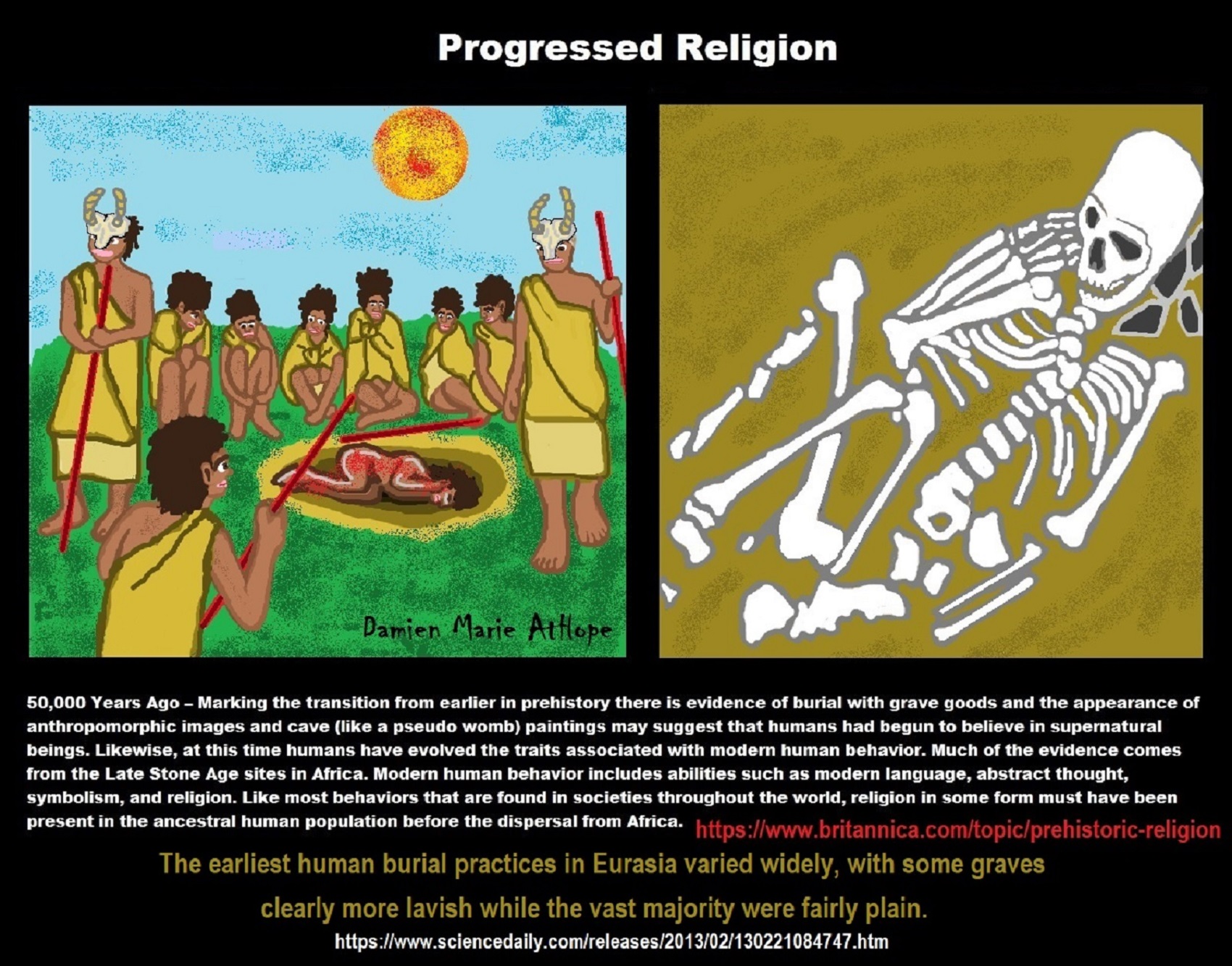
ref, ref, ref, ref, ref, ref, ref, ref, ref, ref, ref, ref, ref, ref, ref
1. Kebaran culture 23,022-16,522 Years Ago, 2. Kortik Tepe 12,422-11,722 Years Ago, 3. Jerf el-Ahmar 11,222 -10,722 Years Ago, 4. Gobekli Tepe 11,152-9,392 Years Ago, 5. Tell Al-‘abr Syria, 6. Nevali Cori 10,422 -10,122 Years Ago, 7. Catal Hoyuk 9,522-7,722 Years Ago
“The shaman is, above all, a connecting figure, bridging several worlds for his people, traveling between this world, the underworld, and the heavens. He transforms himself into an animal and talks with ghosts, the dead, the deities, and the ancestors. He dies and revives. He brings back knowledge from the shadow realm, thus linking his people to the spirits and places which were once mythically accessible to all.–anthropologist Barbara Meyerhoff” ref
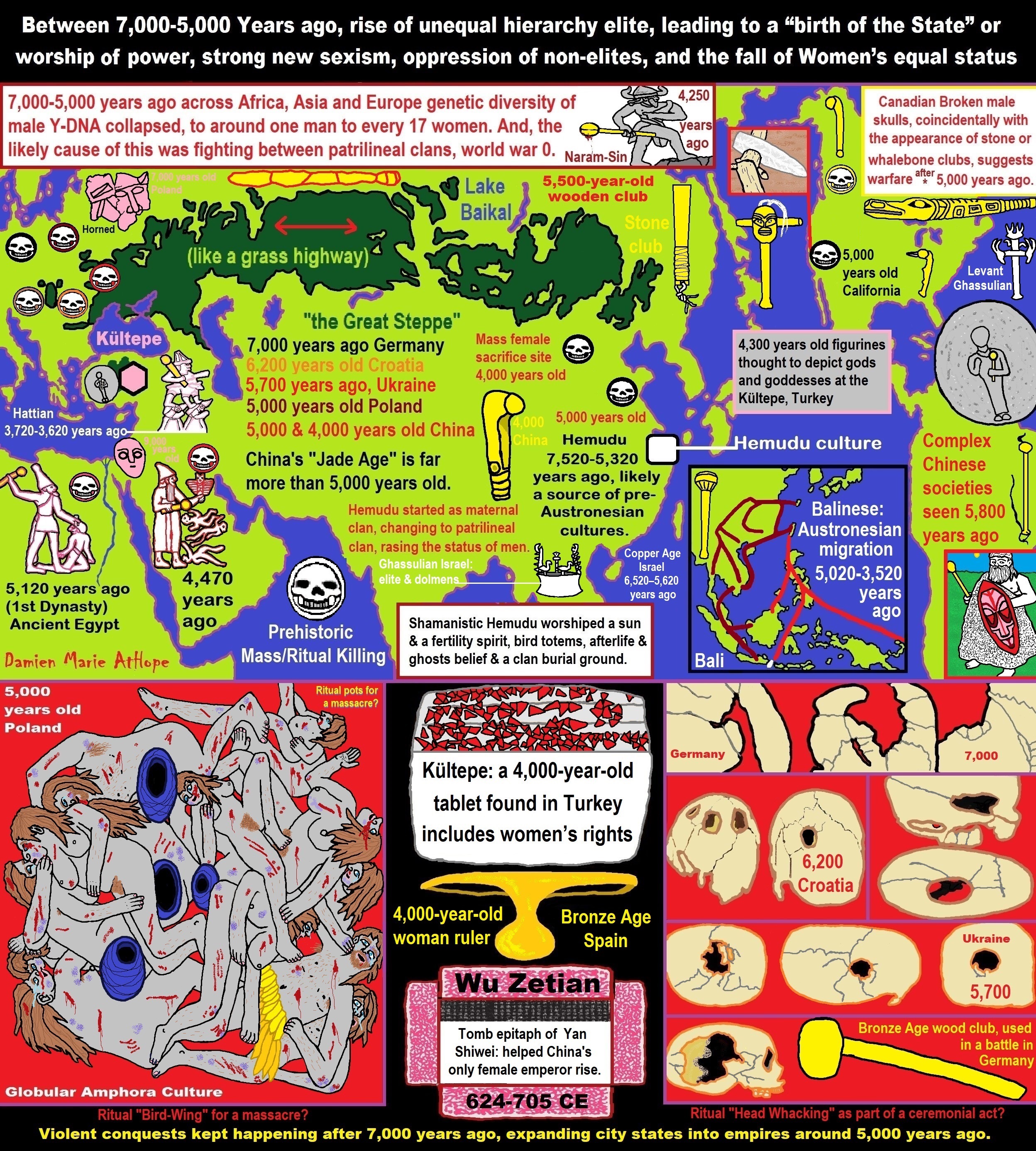
ref, ref, ref, ref, ref, ref, ref, ref, ref, ref, ref, ref, ref, ref, ref, ref, ref, ref, ref, ref, ref, ref, ref, ref, ref, ref, ref, ref, ref, ref, ref, ref, ref, ref, ref, ref, ref, ref, ref, ref, ref, ref, ref, ref, ref, ref, ref, ref, ref, ref, ref, ref, ref, ref, ref, ref, ref, ref, ref, ref, ref, ref, ref, ref, ref, ref, ref, ref, ref, ref, ref, ref, ref, ref, ref, ref, ref, ref, ref, ref, ref, ref, ref, ref, ref, ref, ref, ref, ref, ref
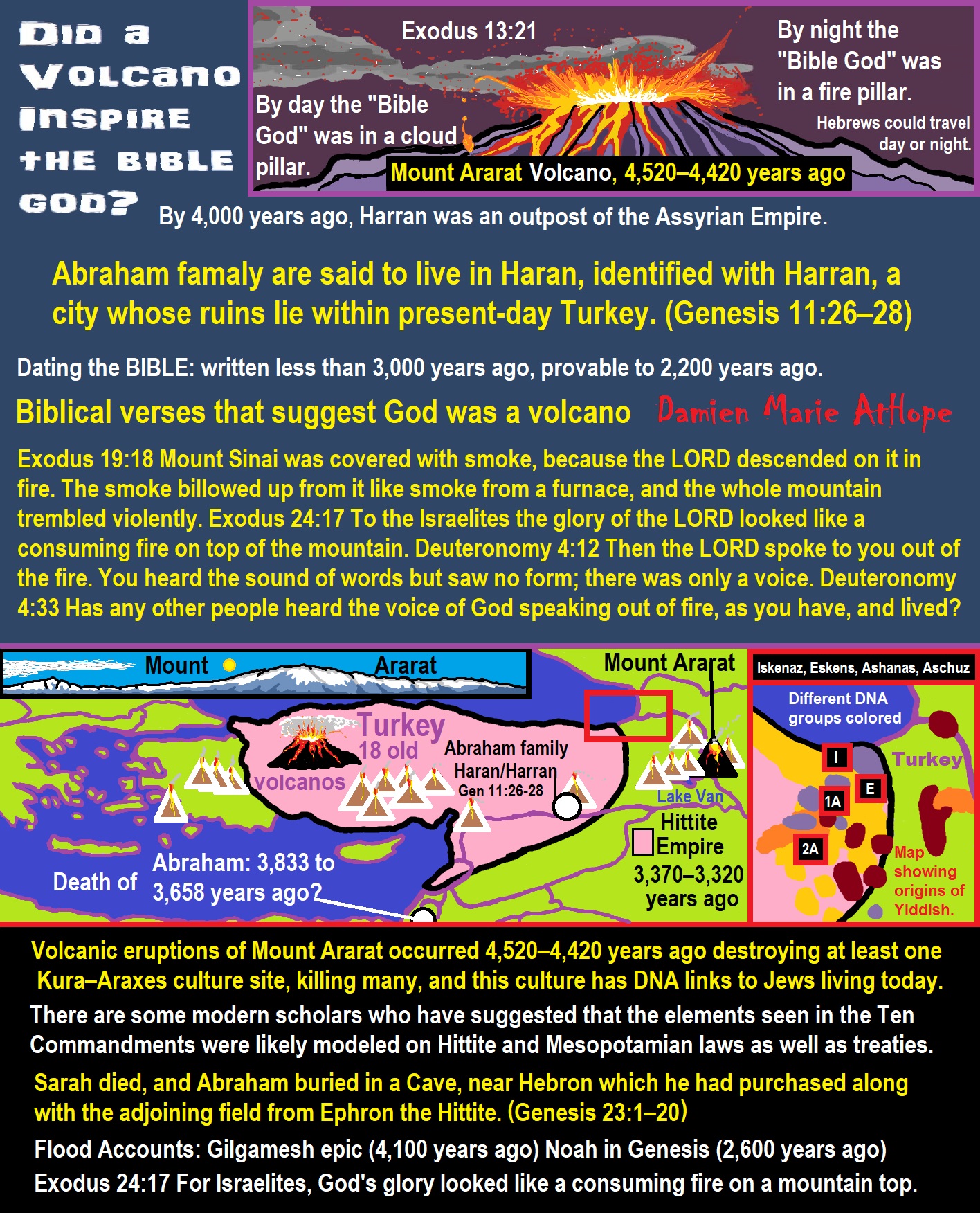
ref, ref, ref, ref, ref, ref, ref, ref, ref, ref, ref, ref, ref
By day the LORD went ahead of them in a pillar of cloud to guide them on their way and by night in a pillar of fire to give them light, so that they could travel by day or night.
- By day the “Bible God” was in a cloud pillar.
- By night the “Bible God” was in a fire pillar.

Animism: Respecting the Living World by Graham Harvey
“How have human cultures engaged with and thought about animals, plants, rocks, clouds, and other elements in their natural surroundings? Do animals and other natural objects have a spirit or soul? What is their relationship to humans? In this new study, Graham Harvey explores current and past animistic beliefs and practices of Native Americans, Maori, Aboriginal Australians, and eco-pagans. He considers the varieties of animism found in these cultures as well as their shared desire to live respectfully within larger natural communities. Drawing on his extensive casework, Harvey also considers the linguistic, performative, ecological, and activist implications of these different animisms.” ref

My thoughts on Religion Evolution with external links for more info:
- (Pre-Animism Africa mainly, but also Europe, and Asia at least 300,000 years ago), (Pre-Animism – Oxford Dictionaries)
- (Animism Africa around 100,000 years ago), (Animism – Britannica.com)
- (Totemism Europe around 50,000 years ago), (Totemism – Anthropology)
- (Shamanism Siberia around 30,000 years ago), (Shamanism – Britannica.com)
- (Paganism Turkey around 12,000 years ago), (Paganism – BBC Religion)
- (Progressed Organized Religion “Institutional Religion” Egypt around 5,000 years ago), (Ancient Egyptian Religion – Britannica.com)
- (CURRENT “World” RELIGIONS after 4,000 years ago) (Origin of Major Religions – Sacred Texts)
- (Early Atheistic Doubting at least by 2,600 years ago) (History of Atheism – Wikipedia)
“Religion is an Evolved Product” and Yes, Religion is Like Fear Given Wings…
Atheists talk about gods and religions for the same reason doctors talk about cancer, they are looking for a cure, or a firefighter talks about fires because they burn people and they care to stop them. We atheists too often feel a need to help the victims of mental slavery, held in the bondage that is the false beliefs of gods and the conspiracy theories of reality found in religions.
Understanding Religion Evolution:
- Pre-Animism (at least 300,000 years ago)
- Animism (Africa: 100,000 years ago)
- Totemism (Europe: 50,000 years ago)
- Shamanism (Siberia: 30,000 years ago)
- Paganism (Turkey: 12,000 years ago)
- Progressed organized religion (Egypt: 5,000 years ago), (Egypt, the First Dynasty 5,150 years ago)
- CURRENT “World” RELIGIONS (after 4,000 years ago)
- Early Atheistic Doubting (at least by 2,600 years ago)
“An Archaeological/Anthropological Understanding of Religion Evolution”
It seems ancient peoples had to survived amazing threats in a “dangerous universe (by superstition perceived as good and evil),” and human “immorality or imperfection of the soul” which was thought to affect the still living, leading to ancestor worship. This ancestor worship presumably led to the belief in supernatural beings, and then some of these were turned into the belief in gods. This feeble myth called gods were just a human conceived “made from nothing into something over and over, changing, again and again, taking on more as they evolve, all the while they are thought to be special,” but it is just supernatural animistic spirit-belief perceived as sacred.
Quick Evolution of Religion?
Pre-Animism (at least 300,000 years ago) pre-religion is a beginning that evolves into later Animism. So, Religion as we think of it, to me, all starts in a general way with Animism (Africa: 100,000 years ago) (theoretical belief in supernatural powers/spirits), then this is physically expressed in or with Totemism (Europe: 50,000 years ago) (theoretical belief in mythical relationship with powers/spirits through a totem item), which then enlists a full-time specific person to do this worship and believed interacting Shamanism (Siberia/Russia: 30,000 years ago) (theoretical belief in access and influence with spirits through ritual), and then there is the further employment of myths and gods added to all the above giving you Paganism (Turkey: 12,000 years ago) (often a lot more nature-based than most current top world religions, thus hinting to their close link to more ancient religious thinking it stems from). My hypothesis is expressed with an explanation of the building of a theatrical house (modern religions development). Progressed organized religion (Egypt: 5,000 years ago) with CURRENT “World” RELIGIONS (after 4,000 years ago).
Historically, in large city-state societies (such as Egypt or Iraq) starting around 5,000 years ago culminated to make religion something kind of new, a sociocultural-governmental-religious monarchy, where all or at least many of the people of such large city-state societies seem familiar with and committed to the existence of “religion” as the integrated life identity package of control dynamics with a fixed closed magical doctrine, but this juggernaut integrated religion identity package of Dogmatic-Propaganda certainly did not exist or if developed to an extent it was highly limited in most smaller prehistoric societies as they seem to lack most of the strong control dynamics with a fixed closed magical doctrine (magical beliefs could be at times be added or removed). Many people just want to see developed religious dynamics everywhere even if it is not. Instead, all that is found is largely fragments until the domestication of religion.
Religions, as we think of them today, are a new fad, even if they go back to around 6,000 years in the timeline of human existence, this amounts to almost nothing when seen in the long slow evolution of religion at least around 70,000 years ago with one of the oldest ritual worship. Stone Snake of South Africa: “first human worship” 70,000 years ago. This message of how religion and gods among them are clearly a man-made thing that was developed slowly as it was invented and then implemented peace by peace discrediting them all. Which seems to be a simple point some are just not grasping how devastating to any claims of truth when we can see the lie clearly in the archeological sites.
I wish people fought as hard for the actual values as they fight for the group/clan names political or otherwise they think support values. Every amount spent on war is theft to children in need of food or the homeless kept from shelter.
Here are several of my blog posts on history:
- To Find Truth You Must First Look
- (Magdalenian/Iberomaurusian) Connections to the First Paganists of the early Neolithic Near East Dating from around 17,000 to 12,000 Years Ago
- Natufians: an Ancient People at the Origins of Agriculture and Sedentary Life
- Possible Clan Leader/Special “MALE” Ancestor Totem Poles At Least 13,500 years ago?
- Jewish People with DNA at least 13,200 years old, Judaism, and the Origins of Some of its Ideas
- Baltic Reindeer Hunters: Swiderian, Lyngby, Ahrensburgian, and Krasnosillya cultures 12,020 to 11,020 years ago are evidence of powerful migratory waves during the last 13,000 years and a genetic link to Saami and the Finno-Ugric peoples.
- The Rise of Inequality: patriarchy and state hierarchy inequality
- Fertile Crescent 12,500 – 9,500 Years Ago: fertility and death cult belief system?
- 12,400 – 11,700 Years Ago – Kortik Tepe (Turkey) Pre/early-Agriculture Cultic Ritualism
- Ritualistic Bird Symbolism at Gobekli Tepe and its “Ancestor Cult”
- Male-Homosexual (female-like) / Trans-woman (female) Seated Figurine from Gobekli Tepe
- Could a 12,000-year-old Bull Geoglyph at Göbekli Tepe relate to older Bull and Female Art 25,000 years ago and Later Goddess and the Bull cults like Catal Huyuk?
- Sedentism and the Creation of goddesses around 12,000 years ago as well as male gods after 7,000 years ago.
- Alcohol, where Agriculture and Religion Become one? Such as Gobekli Tepe’s Ritualistic use of Grain as Food and Ritual Drink
- Neolithic Ritual Sites with T-Pillars and other Cultic Pillars
- Paganism: Goddesses around 12,000 years ago then Male Gods after 7,000 years ago
- First Patriarchy: Split of Women’s Status around 12,000 years ago & First Hierarchy: fall of Women’s Status around 5,000 years ago.
- Natufians: an Ancient People at the Origins of Agriculture and Sedentary Life
- J DNA and the Spread of Agricultural Religion (paganism)
- Paganism: an approximately 12,000-year-old belief system
- Paganism 12,000 years old: related to “Anarchism and Socialism” (Pre-Capitalism)
- Shaman burial in Israel 12,000 years ago and the Shamanism Phenomena
- Need to Mythicized: gods and goddesses
- 12,000 – 7,000 Years Ago – Paleo-Indian Culture (The Americas)
- 12,000 – 2,000 Years Ago – Indigenous-Scandinavians (Nordic)
- Norse did not wear helmets with horns?
- Pre-Pottery Neolithic Skull Cult around 11,500 to 8,400 Years Ago?
- 10,400 – 10,100 Years Ago, in Turkey the Nevail Cori Religious Settlement
- 9,000-6,500 Years Old Submerged Pre-Pottery/Pottery Neolithic Ritual Settlements off Israel’s Coast
- Catal Huyuk “first religious designed city” around 9,500 to 7,700 years ago (Turkey)
- Cultic Hunting at Catal Huyuk “first religious designed city”
- Special Items and Art as well as Special Elite Burials at Catal Huyuk
- New Rituals and Violence with the appearance of Pottery and People?
- Haplogroup N and its related Uralic Languages and Cultures
- Ainu people, Sámi people, Native Americans, the Ancient North Eurasians, and Paganistic-Shamanism with Totemism
- Ideas, Technology and People from Turkey, Europe, to China and Back again 9,000 to 5,000 years ago?
- First Pottery of Europe and the Related Cultures
- 9,000 years old Neolithic Artifacts Judean Desert and Hills Israel
- 9,000-7,000 years-old Sex and Death Rituals: Cult Sites in Israel, Jordan, and the Sinai
- 9,000-8500 year old Horned Female shaman Bad Dürrenberg Germany
- Neolithic Jewelry and the Spread of Farming in Europe Emerging out of West Turkey
- 8,600-year-old Tortoise Shells in Neolithic graves in central China have Early Writing and Shamanism
- Swing of the Mace: the rise of Elite, Forced Authority, and Inequality begin to Emerge 8,500 years ago?
- Migrations and Changing Europeans Beginning around 8,000 Years Ago
- My “Steppe-Anatolian-Kurgan hypothesis” 8,000/7,000 years ago
- Around 8,000-year-old Shared Idea of the Mistress of Animals, “Ritual” Motif
- Pre-Columbian Red-Paint (red ochre) Maritime Archaic Culture 8,000-3,000 years ago
- 7,522-6,522 years ago Linear Pottery culture which I think relates to Arcane Capitalism’s origins
- Arcane Capitalism: Primitive socialism, Primitive capital, Private ownership, Means of production, Market capitalism, Class discrimination, and Petite bourgeoisie (smaller capitalists)
- 7,500-4,750 years old Ritualistic Cucuteni-Trypillian culture of Moldova, Romania, and Ukraine
- Roots of a changing early society 7,200-6,700 years ago Jordan and Israel
- Agriculture religion (Paganism) with farming reached Britain between about 7,000 to 6,500 or so years ago and seemingly expressed in things like Western Europe’s Long Barrows
- My Thoughts on Possible Migrations of “R” DNA and Proto-Indo-European?
- “Millet” Spreading from China 7,022 years ago to Europe and related Language may have Spread with it leading to Proto-Indo-European
- Proto-Indo-European (PIE), ancestor of Indo-European languages: DNA, Society, Language, and Mythology
- The Dnieper–Donets culture and Asian varieties of Millet from China to the Black Sea region of Europe by 7,022 years ago
- Kurgan 6,000 years ago/dolmens 7,000 years ago: funeral, ritual, and other?
- 7,020 to 6,020-year-old Proto-Indo-European Homeland of Urheimat or proposed home of their Language and Religion
- Ancient Megaliths: Kurgan, Ziggurat, Pyramid, Menhir, Trilithon, Dolman, Kromlech, and Kromlech of Trilithons
- The Mytheme of Ancient North Eurasian Sacred-Dog belief and similar motifs are found in Indo-European, Native American, and Siberian comparative mythology
- Elite Power Accumulation: Ancient Trade, Tokens, Writing, Wealth, Merchants, and Priest-Kings
- Sacred Mounds, Mountains, Kurgans, and Pyramids may hold deep connections?
- Between 7,000-5,000 Years ago, rise of unequal hierarchy elite, leading to a “birth of the State” or worship of power, strong new sexism, oppression of non-elites, and the fall of Women’s equal status
- Paganism 7,000-5,000 years old: related to “Anarchism and Socialism” (Capitalism) (World War 0) Elite & their slaves
- Hell and Underworld mythologies starting maybe as far back as 7,000 to 5,000 years ago with the Proto-Indo-Europeans?
- The First Expression of the Male God around 7,000 years ago?
- White (light complexion skin) Bigotry and Sexism started 7,000 years ago?
- Around 7,000-year-old Shared Idea of the Divine Bird (Tutelary and/or Trickster spirit/deity), “Ritual” Motif
- Nekhbet an Ancient Egyptian Vulture Goddess and Tutelary Deity
- 6,720 to 4,920 years old Ritualistic Hongshan Culture of Inner Mongolia with 5,000-year-old Pyramid Mounds and Temples
- First proto-king in the Balkans, Varna culture around 6,500 years ago?
- 6,500–5,800 years ago in Israel Late Chalcolithic (Copper Age) Period in the Southern Levant Seems to Express Northern Levant Migrations, Cultural and Religious Transfer
- KING OF BEASTS: Master of Animals “Ritual” Motif, around 6,000 years old or older…
- Around 6000-year-old Shared Idea of the Solid Wheel & the Spoked Wheel-Shaped Ritual Motif
- “The Ghassulian Star,” a mysterious 6,000-year-old mural from Jordan; a Proto-Star of Ishtar, Star of Inanna or Star of Venus?
- Religious/Ritual Ideas, including goddesses and gods as well as ritual mounds or pyramids from Northeastern Asia at least 6,000 years old, seemingly filtering to Iran, Iraq, the Mediterranean, Europe, Egypt, and the Americas?
- Maykop (5,720–5,020 years ago) Caucasus region Bronze Age culture-related to Copper Age farmers from the south, influenced by the Ubaid period and Leyla-Tepe culture, as well as influencing the Kura-Araxes culture
- 5-600-year-old Tomb, Mummy, and First Bearded Male Figurine in a Grave
- Kura-Araxes Cultural 5,520 to 4,470 years old DNA traces to the Canaanites, Arabs, and Jews
- Minoan/Cretan (Keftiu) Civilization and Religion around 5,520 to 3,120 years ago
- Evolution Of Science at least by 5,500 years ago
- 5,500 Years old birth of the State, the rise of Hierarchy, and the fall of Women’s status
- “Jiroft culture” 5,100 – 4,200 years ago and the History of Iran
- Stonehenge: Paganistic Burial and Astrological Ritual Complex, England (5,100-3,600 years ago)
- Around 5,000-year-old Shared Idea of the “Tree of Life” Ritual Motif
- Complex rituals for elite, seen from China to Egypt, at least by 5,000 years ago
- Around 5,000 years ago: “Birth of the State” where Religion gets Military Power and Influence
- The Center of the World “Axis Mundi” and/or “Sacred Mountains” Mythology Could Relate to the Altai Mountains, Heart of the Steppe
- Progressed organized religion starts, an approximately 5,000-year-old belief system
- China’s Civilization between 5,000-3,000 years ago, was a time of war and class struggle, violent transition from free clans to a Slave or Elite society
- Origin of Logics is Naturalistic Observation at least by around 5,000 years ago.
- Paganism 5,000 years old: progressed organized religion and the state: related to “Anarchism and Socialism” (Kings and the Rise of the State)
- Ziggurats (multi-platform temples: 4,900 years old) to Pyramids (multi-platform tombs: 4,700 years old)
- Did a 4,520–4,420-year-old Volcano In Turkey Inspire the Bible God?
- Finland’s Horned Shaman and Pre-Horned-God at least 4,500 years ago?
- 4,000-year-Old Dolmens in Israel: A Connected Dolmen Religious Phenomenon?
- Creation myths: From chaos, Ex nihilo, Earth-diver, Emergence, World egg, and World parent
- Bronze Age “Ritual” connections of the Bell Beaker culture with the Corded Ware/Single Grave culture, which were related to the Yamnaya culture and Proto-Indo-European Languages/Religions
- Low Gods (Earth/ Tutelary deity), High Gods (Sky/Supreme deity), and Moralistic Gods (Deity enforcement/divine order)
- The exchange of people, ideas, and material-culture including, to me, the new god (Sky Father) and goddess (Earth Mother) religion between the Cucuteni-Trypillians and others which is then spread far and wide
- Koryaks: Indigenous People of the Russian Far East and Big Raven myths also found in Tlingit, Haida, Tsimshian, and other Indigenous People of North America
- 42 Principles Of Maat (Egyptian Goddess of the justice) around 4,400 years ago, 2000 Years Before Ten Commandments
- “Happy Easter” Well Happy Eostre/Ishter
- 4,320-3,820 years old “Shimao” (North China) site with Totemistic-Shamanistic Paganism and a Stepped Pyramid
- 4,250 to 3,400 Year old Stonehenge from Russia: Arkaim?
- 4,100-year-old beaker with medicinal & flowering plants in a grave of a woman in Scotland
- Early European Farmer ancestry, Kelif el Boroud people with the Cardial Ware culture, and the Bell Beaker culture Paganists too, spread into North Africa, then to the Canary Islands off West Africa
- Flood Accounts: Gilgamesh epic (4,100 years ago) Noah in Genesis (2,600 years ago)
- Paganism 4,000 years old: related to “Anarchism and Socialism” (First Moralistic gods, then the Origin time of Monotheism)
- When was the beginning: TIMELINE OF CURRENT RELIGIONS, which start around 4,000 years ago.
- Early Religions Thought to Express Proto-Monotheistic Systems around 4,000 years ago
- Kultepe? An archaeological site with a 4,000 years old women’s rights document.
- Single God Religions (Monotheism) = “Man-o-theism” started around 4,000 years ago with the Great Sky Spirit/God Tiān (天)?
- Confucianism’s Tiān (Shangdi god 4,000 years old): Supernaturalism, Pantheism or Theism?
- Yes, Your Male God is Ridiculous
- Mythology, a Lunar Deity is a Goddess or God of the Moon
- Sacred Land, Hills, and Mountains: Sami Mythology (Paganistic Shamanism)
- Horse Worship/Sacrifice: mythical union of Ruling Elite/Kingship and the Horse
- The Amorite/Amurru people’s God Amurru “Lord of the Steppe”, relates to the Origins of the Bible God?
- Bronze Age Exotic Trade Routes Spread Quite Far as well as Spread Religious Ideas with Them
- Sami and the Northern Indigenous Peoples Landscape, Language, and its Connection to Religion
- Prototype of Ancient Analemmatic Sundials around 3,900-3,150 years ago and a Possible Solar Connection to gods?
- Judaism is around 3,450 or 3,250 years old. (“Paleo-Hebrew” 3,000 years ago and Torah 2,500 years ago)
- The Weakening of Ancient Trade and the Strengthening of Religions around 3000 years ago?
- Are you aware that there are religions that worship women gods, explain now religion tears women down?
- Animistic, Totemistic, and Paganistic Superstition Origins of bible god and the bible’s Religion.
- Myths and Folklore: “Trickster gods and goddesses”
- Jews, Judaism, and the Origins of Some of its Ideas
- An Old Branch of Religion Still Giving Fruit: Sacred Trees
- Dating the BIBLE: naming names and telling times (written less than 3,000 years ago, provable to 2,200 years ago)
- Did a Volcano Inspire the bible god?
- The Amorite/Amurru people’s God Amurru “Lord of the Steppe”, relates to the Origins of the Bible God?
- Dené–Yeniseian language, Old Copper Complex, and Pre-Columbian Mound Builders?
- No “dinosaurs and humans didn’t exist together just because some think they are in the bible itself”
- Sacred Shit and Sacred Animals?
- Everyone Killed in the Bible Flood? “Nephilim” (giants)?
- Hey, Damien dude, I have a question for you regarding “the bible” Exodus.
- Archaeology Disproves the Bible
- Bible Battle, Just More, Bible Babble
- The Jericho Conquest lie?
- Canaanites and Israelites?
- Accurate Account on how did Christianity Began?
- Let’s talk about Christianity.
- So the 10 commandments isn’t anything to go by either right?
- Misinformed christian
- Debunking Jesus?
- Paulism vs Jesus
- Ok, you seem confused so let’s talk about Buddhism.
- Unacknowledged Buddhism: Gods, Savior, Demons, Rebirth, Heavens, Hells, and Terrorism
- His Foolishness The Dalai Lama
- Yin and Yang is sexist with an ORIGIN around 2,300 years ago?
- I Believe Archaeology, not Myths & Why Not, as the Religious Myths Already Violate Reason!
- Archaeological, Scientific, & Philosophic evidence shows the god myth is man-made nonsense.
- Aquatic Ape Theory/Hypothesis? As Always, Just Pseudoscience.
- Ancient Aliens Conspiracy Theorists are Pseudohistorians
- The Pseudohistoric and Pseudoscientific claims about “Bakoni Ruins” of South Africa
- Why do people think Religion is much more than supernaturalism and superstitionism?
- Religion is an Evolved Product
- Was the Value of Ancient Women Different?
- 1000 to 1100 CE, human sacrifice Cahokia Mounds a pre-Columbian Native American site
- Feminist atheists as far back as the 1800s?
- Promoting Religion as Real is Mentally Harmful to a Flourishing Humanity
- Screw All Religions and Their Toxic lies, they are all fraud
- Forget Religions’ Unfounded Myths, I Have Substantiated “Archaeology Facts.”
- Religion Dispersal throughout the World
- I Hate Religion Just as I Hate all Pseudoscience
- Exposing Scientology, Eckankar, Wicca and Other Nonsense?
- Main deity or religious belief systems
- Quit Trying to Invent Your God From the Scraps of Science.
- Archaeological, Scientific, & Philosophic evidence shows the god myth is man-made nonsense.
- Ancient Alien Conspiracy Theorists: Misunderstanding, Rhetoric, Misinformation, Fabrications, and Lies
- Misinformation, Distortion, and Pseudoscience in Talking with a Christian Creationist
- Judging the Lack of Goodness in Gods, Even the Norse God Odin
- Challenging the Belief in God-like Aliens and Gods in General
- A Challenge to Christian use of Torture Devices?
- Yes, Hinduism is a Religion
- Trump is One of the Most Reactionary Forces of Far-right Christian Extremism
- Was the Bull Head a Symbol of God? Yes!
- Primate Death Rituals
- Christian – “God and Christianity are objectively true”
- Australopithecus afarensis Death Ritual?
- You Claim Global Warming is a Hoax?
- Doubter of Science and Defamer of Atheists?
- I think that sounds like the Bible?
- History of the Antifa (“anti-fascist”) Movements
- Indianapolis Anti-Blasphemy Laws #Free Soheil Rally
- Damien, you repeat the golden rule in so many forms then you say religion is dogmatic?
- Science is a Trustable Methodology whereas Faith is not Trustable at all!
- Was I ever a believer, before I was an atheist?
- Atheists rise in reason
- Mistrust of science?
- Open to Talking About the Definition of ‘God’? But first, we address Faith.
- ‘United Monarchy’ full of splendor and power – Saul, David, and Solomon? Most likely not.
- Is there EXODUS ARCHAEOLOGY? The short answer is “no.”
- Lacking Proof of Bigfoots, Unicorns, and Gods is Just a Lack of Research?
- Religion and Politics: Faith Beliefs vs. Rational Thinking
- Hammer of Truth that lying pig RELIGION: challenged by an archaeologist
- “The Hammer of Truth” -ontology question- What do You Mean by That?
- Navigation of a bad argument: Ad Hominem vs. Attack
- Why is it Often Claimed that Gods have a Gender?
- Why are basically all monotheistic religions ones that have a male god?
- Shifting through the Claims in support of Faith
- Dear Mr. AtHope, The 20th Century is an Indictment of Secularism and a Failed Atheist Century
- An Understanding of the Worldwide Statistics and Dynamics of Terrorist Incidents and Suicide Attacks
- Intoxication and Evolution? Addressing and Assessing the “Stoned Ape” or “Drunken Monkey” Theories as Catalysts in Human Evolution
- Sacred Menstrual cloth? Inanna’s knot, Isis knot, and maybe Ma’at’s feather?
- Damien, why don’t the Hebrews accept the bible stories?
- Dealing with a Troll and Arguing Over Word Meaning
- Knowledge without Belief? Justified beliefs or disbeliefs worthy of Knowledge?
- Afrocentrism and African Religions
- Crecganford @crecganford offers history & stories of the people, places, gods, & culture
- Empiricism-Denier?
I am not an academic. I am a revolutionary that teaches in public, in places like social media, and in the streets. I am not a leader by some title given but from my commanding leadership style of simply to start teaching everywhere to everyone, all manner of positive education.

ref, ref, ref, ref, ref, ref, ref, ref, ref, ref, ref, ref, ref, ref, ref, ref, ref, ref, ref, ref, ref
Low Gods “Earth” or Tutelary deity and High Gods “Sky” or Supreme deity
“An Earth goddess is a deification of the Earth. Earth goddesses are often associated with the “chthonic” deities of the underworld. Ki and Ninhursag are Mesopotamian earth goddesses. In Greek mythology, the Earth is personified as Gaia, corresponding to Roman Terra, Indic Prithvi/Bhūmi, etc. traced to an “Earth Mother” complementary to the “Sky Father” in Proto-Indo-European religion. Egyptian mythology exceptionally has a sky goddess and an Earth god.” ref
“A mother goddess is a goddess who represents or is a personification of nature, motherhood, fertility, creation, destruction or who embodies the bounty of the Earth. When equated with the Earth or the natural world, such goddesses are sometimes referred to as Mother Earth or as the Earth Mother. In some religious traditions or movements, Heavenly Mother (also referred to as Mother in Heaven or Sky Mother) is the wife or feminine counterpart of the Sky father or God the Father.” ref
“Any masculine sky god is often also king of the gods, taking the position of patriarch within a pantheon. Such king gods are collectively categorized as “sky father” deities, with a polarity between sky and earth often being expressed by pairing a “sky father” god with an “earth mother” goddess (pairings of a sky mother with an earth father are less frequent). A main sky goddess is often the queen of the gods and may be an air/sky goddess in her own right, though she usually has other functions as well with “sky” not being her main. In antiquity, several sky goddesses in ancient Egypt, Mesopotamia, and the Near East were called Queen of Heaven. Neopagans often apply it with impunity to sky goddesses from other regions who were never associated with the term historically. The sky often has important religious significance. Many religions, both polytheistic and monotheistic, have deities associated with the sky.” ref
“In comparative mythology, sky father is a term for a recurring concept in polytheistic religions of a sky god who is addressed as a “father”, often the father of a pantheon and is often either a reigning or former King of the Gods. The concept of “sky father” may also be taken to include Sun gods with similar characteristics, such as Ra. The concept is complementary to an “earth mother“. “Sky Father” is a direct translation of the Vedic Dyaus Pita, etymologically descended from the same Proto-Indo-European deity name as the Greek Zeûs Pater and Roman Jupiter and Germanic Týr, Tir or Tiwaz, all of which are reflexes of the same Proto-Indo-European deity’s name, *Dyēus Ph₂tḗr. While there are numerous parallels adduced from outside of Indo-European mythology, there are exceptions (e.g. In Egyptian mythology, Nut is the sky mother and Geb is the earth father).” ref
Tutelary deity
“A tutelary (also tutelar) is a deity or spirit who is a guardian, patron, or protector of a particular place, geographic feature, person, lineage, nation, culture, or occupation. The etymology of “tutelary” expresses the concept of safety and thus of guardianship. In late Greek and Roman religion, one type of tutelary deity, the genius, functions as the personal deity or daimon of an individual from birth to death. Another form of personal tutelary spirit is the familiar spirit of European folklore.” ref
“A tutelary (also tutelar) in Korean shamanism, jangseung and sotdae were placed at the edge of villages to frighten off demons. They were also worshiped as deities. Seonangshin is the patron deity of the village in Korean tradition and was believed to embody the Seonangdang. In Philippine animism, Diwata or Lambana are deities or spirits that inhabit sacred places like mountains and mounds and serve as guardians. Such as: Maria Makiling is the deity who guards Mt. Makiling and Maria Cacao and Maria Sinukuan. In Shinto, the spirits, or kami, which give life to human bodies come from nature and return to it after death. Ancestors are therefore themselves tutelaries to be worshiped. And similarly, Native American beliefs such as Tonás, tutelary animal spirit among the Zapotec and Totems, familial or clan spirits among the Ojibwe, can be animals.” ref
“A tutelary (also tutelar) in Austronesian beliefs such as: Atua (gods and spirits of the Polynesian peoples such as the Māori or the Hawaiians), Hanitu (Bunun of Taiwan‘s term for spirit), Hyang (Kawi, Sundanese, Javanese, and Balinese Supreme Being, in ancient Java and Bali mythology and this spiritual entity, can be either divine or ancestral), Kaitiaki (New Zealand Māori term used for the concept of guardianship, for the sky, the sea, and the land), Kawas (mythology) (divided into 6 groups: gods, ancestors, souls of the living, spirits of living things, spirits of lifeless objects, and ghosts), Tiki (Māori mythology, Tiki is the first man created by either Tūmatauenga or Tāne and represents deified ancestors found in most Polynesian cultures). ” ref, ref, ref, ref, ref, ref, ref
Mesopotamian Tutelary Deities can be seen as ones related to City-States
“Historical city-states included Sumerian cities such as Uruk and Ur; Ancient Egyptian city-states, such as Thebes and Memphis; the Phoenician cities (such as Tyre and Sidon); the five Philistine city-states; the Berber city-states of the Garamantes; the city-states of ancient Greece (the poleis such as Athens, Sparta, Thebes, and Corinth); the Roman Republic (which grew from a city-state into a vast empire); the Italian city-states from the Middle Ages to the early modern period, such as Florence, Siena, Ferrara, Milan (which as they grew in power began to dominate neighboring cities) and Genoa and Venice, which became powerful thalassocracies; the Mayan and other cultures of pre-Columbian Mesoamerica (including cities such as Chichen Itza, Tikal, Copán and Monte Albán); the central Asian cities along the Silk Road; the city-states of the Swahili coast; Ragusa; states of the medieval Russian lands such as Novgorod and Pskov; and many others.” ref
“The Uruk period (ca. 4000 to 3100 BCE; also known as Protoliterate period) of Mesopotamia, named after the Sumerian city of Uruk, this period saw the emergence of urban life in Mesopotamia and the Sumerian civilization. City-States like Uruk and others had a patron tutelary City Deity along with a Priest-King.” ref
“Chinese folk religion, both past, and present, includes myriad tutelary deities. Exceptional individuals, highly cultivated sages, and prominent ancestors can be deified and honored after death. Lord Guan is the patron of military personnel and police, while Mazu is the patron of fishermen and sailors. Such as Tu Di Gong (Earth Deity) is the tutelary deity of a locality, and each individual locality has its own Earth Deity and Cheng Huang Gong (City God) is the guardian deity of an individual city, worshipped by local officials and locals since imperial times.” ref
“A tutelary (also tutelar) in Hinduism, personal tutelary deities are known as ishta-devata, while family tutelary deities are known as Kuladevata. Gramadevata are guardian deities of villages. Devas can also be seen as tutelary. Shiva is the patron of yogis and renunciants. City goddesses include: Mumbadevi (Mumbai), Sachchika (Osian); Kuladevis include: Ambika (Porwad), and Mahalakshmi. In NorthEast India Meitei mythology and religion (Sanamahism) of Manipur, there are various types of tutelary deities, among which Lam Lais are the most predominant ones. Tibetan Buddhism has Yidam as a tutelary deity. Dakini is the patron of those who seek knowledge.” ref
“A tutelary (also tutelar) The Greeks also thought deities guarded specific places: for instance, Athena was the patron goddess of the city of Athens. Socrates spoke of hearing the voice of his personal spirit or daimonion:
You have often heard me speak of an oracle or sign which comes to me … . This sign I have had ever since I was a child. The sign is a voice which comes to me and always forbids me to do something which I am going to do, but never commands me to do anything, and this is what stands in the way of my being a politician.” ref
“Tutelary deities who guard and preserve a place or a person are fundamental to ancient Roman religion. The tutelary deity of a man was his Genius, that of a woman her Juno. In the Imperial era, the Genius of the Emperor was a focus of Imperial cult. An emperor might also adopt a major deity as his personal patron or tutelary, as Augustus did Apollo. Precedents for claiming the personal protection of a deity were established in the Republican era, when for instance the Roman dictator Sulla advertised the goddess Victory as his tutelary by holding public games (ludi) in her honor.” ref
“Each town or city had one or more tutelary deities, whose protection was considered particularly vital in time of war and siege. Rome itself was protected by a goddess whose name was to be kept ritually secret on pain of death (for a supposed case, see Quintus Valerius Soranus). The Capitoline Triad of Juno, Jupiter, and Minerva were also tutelaries of Rome. The Italic towns had their own tutelary deities. Juno often had this function, as at the Latin town of Lanuvium and the Etruscan city of Veii, and was often housed in an especially grand temple on the arx (citadel) or other prominent or central location. The tutelary deity of Praeneste was Fortuna, whose oracle was renowned.” ref
“The Roman ritual of evocatio was premised on the belief that a town could be made vulnerable to military defeat if the power of its tutelary deity were diverted outside the city, perhaps by the offer of superior cult at Rome. The depiction of some goddesses such as the Magna Mater (Great Mother, or Cybele) as “tower-crowned” represents their capacity to preserve the city. A town in the provinces might adopt a deity from within the Roman religious sphere to serve as its guardian, or syncretize its own tutelary with such; for instance, a community within the civitas of the Remi in Gaul adopted Apollo as its tutelary, and at the capital of the Remi (present-day Rheims), the tutelary was Mars Camulus.” ref
Household deity (a kind of or related to a Tutelary deity)
“A household deity is a deity or spirit that protects the home, looking after the entire household or certain key members. It has been a common belief in paganism as well as in folklore across many parts of the world. Household deities fit into two types; firstly, a specific deity – typically a goddess – often referred to as a hearth goddess or domestic goddess who is associated with the home and hearth, such as the ancient Greek Hestia.” ref
“The second type of household deities are those that are not one singular deity, but a type, or species of animistic deity, who usually have lesser powers than major deities. This type was common in the religions of antiquity, such as the Lares of ancient Roman religion, the Gashin of Korean shamanism, and Cofgodas of Anglo-Saxon paganism. These survived Christianisation as fairy-like creatures existing in folklore, such as the Anglo-Scottish Brownie and Slavic Domovoy.” ref
“Household deities were usually worshipped not in temples but in the home, where they would be represented by small idols (such as the teraphim of the Bible, often translated as “household gods” in Genesis 31:19 for example), amulets, paintings, or reliefs. They could also be found on domestic objects, such as cosmetic articles in the case of Tawaret. The more prosperous houses might have a small shrine to the household god(s); the lararium served this purpose in the case of the Romans. The gods would be treated as members of the family and invited to join in meals, or be given offerings of food and drink.” ref
“In many religions, both ancient and modern, a god would preside over the home. Certain species, or types, of household deities, existed. An example of this was the Roman Lares. Many European cultures retained house spirits into the modern period. Some examples of these include:
- Brownie (Scotland and England) or Hob (England) / Kobold (Germany) / Goblin / Hobgoblin
- Domovoy (Slavic)
- Nisse (Norwegian or Danish) / Tomte (Swedish) / Tonttu (Finnish)
- Húsvættir (Norse)” ref
“Although the cosmic status of household deities was not as lofty as that of the Twelve Olympians or the Aesir, they were also jealous of their dignity and also had to be appeased with shrines and offerings, however humble. Because of their immediacy they had arguably more influence on the day-to-day affairs of men than the remote gods did. Vestiges of their worship persisted long after Christianity and other major religions extirpated nearly every trace of the major pagan pantheons. Elements of the practice can be seen even today, with Christian accretions, where statues to various saints (such as St. Francis) protect gardens and grottos. Even the gargoyles found on older churches, could be viewed as guardians partitioning a sacred space.” ref
“For centuries, Christianity fought a mop-up war against these lingering minor pagan deities, but they proved tenacious. For example, Martin Luther‘s Tischreden have numerous – quite serious – references to dealing with kobolds. Eventually, rationalism and the Industrial Revolution threatened to erase most of these minor deities, until the advent of romantic nationalism rehabilitated them and embellished them into objects of literary curiosity in the 19th century. Since the 20th century this literature has been mined for characters for role-playing games, video games, and other fantasy personae, not infrequently invested with invented traits and hierarchies somewhat different from their mythological and folkloric roots.” ref
“In contradistinction to both Herbert Spencer and Edward Burnett Tylor, who defended theories of animistic origins of ancestor worship, Émile Durkheim saw its origin in totemism. In reality, this distinction is somewhat academic, since totemism may be regarded as a particularized manifestation of animism, and something of a synthesis of the two positions was attempted by Sigmund Freud. In Freud’s Totem and Taboo, both totem and taboo are outward expressions or manifestations of the same psychological tendency, a concept which is complementary to, or which rather reconciles, the apparent conflict. Freud preferred to emphasize the psychoanalytic implications of the reification of metaphysical forces, but with particular emphasis on its familial nature. This emphasis underscores, rather than weakens, the ancestral component.” ref
“William Edward Hearn, a noted classicist, and jurist, traced the origin of domestic deities from the earliest stages as an expression of animism, a belief system thought to have existed also in the neolithic, and the forerunner of Indo-European religion. In his analysis of the Indo-European household, in Chapter II “The House Spirit”, Section 1, he states:
The belief which guided the conduct of our forefathers was … the spirit rule of dead ancestors.” ref
“In Section 2 he proceeds to elaborate:
It is thus certain that the worship of deceased ancestors is a vera causa, and not a mere hypothesis. …
In the other European nations, the Slavs, the Teutons, and the Kelts, the House Spirit appears with no less distinctness. … [T]he existence of that worship does not admit of doubt. … The House Spirits had a multitude of other names which it is needless here to enumerate, but all of which are more or less expressive of their friendly relations with man. … In [England] … [h]e is the Brownie. … In Scotland this same Brownie is well known. He is usually described as attached to particular families, with whom he has been known to reside for centuries, threshing the corn, cleaning the house, and performing similar household tasks. His favorite gratification was milk and honey.” ref

Hinduism around 3,700 to 3,500 years old. ref
Judaism around 3,450 or 3,250 years old. (The first writing in the bible was “Paleo-Hebrew” dated to around 3,000 years ago Khirbet Qeiyafa is the site of an ancient fortress city overlooking the Elah Valley. And many believe the religious Jewish texts were completed around 2,500) ref, ref
Judaism is around 3,450 or 3,250 years old. (“Paleo-Hebrew” 3,000 years ago and Torah 2,500 years ago)
“Judaism is an Abrahamic, its roots as an organized religion in the Middle East during the Bronze Age. Some scholars argue that modern Judaism evolved from Yahwism, the religion of ancient Israel and Judah, by the late 6th century BCE, and is thus considered to be one of the oldest monotheistic religions.” ref
“Yahwism is the name given by modern scholars to the religion of ancient Israel, essentially polytheistic, with a plethora of gods and goddesses. Heading the pantheon was Yahweh, the national god of the Israelite kingdoms of Israel and Judah, with his consort, the goddess Asherah; below them were second-tier gods and goddesses such as Baal, Shamash, Yarikh, Mot, and Astarte, all of whom had their own priests and prophets and numbered royalty among their devotees, and a third and fourth tier of minor divine beings, including the mal’ak, the messengers of the higher gods, who in later times became the angels of Judaism, Christianity and Islam. Yahweh, however, was not the ‘original’ god of Israel “Isra-El”; it is El, the head of the Canaanite pantheon, whose name forms the basis of the name “Israel”, and none of the Old Testament patriarchs, the tribes of Israel, the Judges, or the earliest monarchs, have a Yahwistic theophoric name (i.e., one incorporating the name of Yahweh).” ref
“El is a Northwest Semitic word meaning “god” or “deity“, or referring (as a proper name) to any one of multiple major ancient Near Eastern deities. A rarer form, ‘ila, represents the predicate form in Old Akkadian and in Amorite. The word is derived from the Proto-Semitic *ʔil-, meaning “god”. Specific deities known as ‘El or ‘Il include the supreme god of the ancient Canaanite religion and the supreme god of East Semitic speakers in Mesopotamia’s Early Dynastic Period. ʼĒl is listed at the head of many pantheons. In some Canaanite and Ugaritic sources, ʼĒl played a role as father of the gods, of creation, or both. For example, in the Ugaritic texts, ʾil mlk is understood to mean “ʼĒl the King” but ʾil hd as “the god Hadad“. The Semitic root ʾlh (Arabic ʾilāh, Aramaic ʾAlāh, ʾElāh, Hebrew ʾelōah) may be ʾl with a parasitic h, and ʾl may be an abbreviated form of ʾlh. In Ugaritic the plural form meaning “gods” is ʾilhm, equivalent to Hebrew ʾelōhîm “powers”. In the Hebrew texts this word is interpreted as being semantically singular for “god” by biblical commentators. However the documentary hypothesis for the Old Testament (corresponds to the Jewish Torah) developed originally in the 1870s, identifies these that different authors – the Jahwist, Elohist, Deuteronomist, and the Priestly source – were responsible for editing stories from a polytheistic religion into those of a monotheistic religion. Inconsistencies that arise between monotheism and polytheism in the texts are reflective of this hypothesis.” ref
Jainism around 2,599 – 2,527 years old. ref
Confucianism around 2,600 – 2,551 years old. ref
Buddhism around 2,563/2,480 – 2,483/2,400 years old. ref
Christianity around 2,o00 years old. ref
Shinto around 1,305 years old. ref
Islam around 1407–1385 years old. ref

Knowledge to Ponder:
Stars/Astrology:
- Possibly, around 30,000 years ago (in simpler form) to 6,000 years ago, Stars/Astrology are connected to Ancestors, Spirit Animals, and Deities.
- The star also seems to be a possible proto-star for Star of Ishtar, Star of Inanna, or Star of Venus.
- Around 7,000 to 6,000 years ago, Star Constellations/Astrology have connections to the “Kurgan phenomenon” of below-ground “mound” stone/wood burial structures and “Dolmen phenomenon” of above-ground stone burial structures.
- Around 6,500–5,800 years ago, The Northern Levant migrations into Jordon and Israel in the Southern Levant brought new cultural and religious transfer from Turkey and Iran.
- “The Ghassulian Star,” a mysterious 6,000-year-old mural from Jordan may have connections to the European paganstic kurgan/dolmens phenomenon.
“Astrology is a range of divinatory practices, recognized as pseudoscientific since the 18th century, that claim to discern information about human affairs and terrestrial events by studying the apparent positions of celestial objects. Different cultures have employed forms of astrology since at least the 2nd millennium BCE, these practices having originated in calendrical systems used to predict seasonal shifts and to interpret celestial cycles as signs of divine communications. Most, if not all, cultures have attached importance to what they observed in the sky, and some—such as the Hindus, Chinese, and the Maya—developed elaborate systems for predicting terrestrial events from celestial observations. Western astrology, one of the oldest astrological systems still in use, can trace its roots to 19th–17th century BCE Mesopotamia, from where it spread to Ancient Greece, Rome, the Islamicate world and eventually Central and Western Europe. Contemporary Western astrology is often associated with systems of horoscopes that purport to explain aspects of a person’s personality and predict significant events in their lives based on the positions of celestial objects; the majority of professional astrologers rely on such systems.” ref
Around 5,500 years ago, Science evolves, The first evidence of science was 5,500 years ago and was demonstrated by a body of empirical, theoretical, and practical knowledge about the natural world. ref
Around 5,000 years ago, Origin of Logics is a Naturalistic Observation (principles of valid reasoning, inference, & demonstration) ref
Around 4,150 to 4,000 years ago: The earliest surviving versions of the Sumerian Epic of Gilgamesh, which was originally titled “He who Saw the Deep” (Sha naqba īmuru) or “Surpassing All Other Kings” (Shūtur eli sharrī) were written. ref
Hinduism:
- 3,700 years ago or so, the oldest of the Hindu Vedas (scriptures), the Rig Veda was composed.
- 3,500 years ago or so, the Vedic Age began in India after the collapse of the Indus Valley Civilization.
Judaism:
- around 3,000 years ago, the first writing in the bible was “Paleo-Hebrew”
- around 2,500 years ago, many believe the religious Jewish texts were completed
Myths: The bible inspired religion is not just one religion or one myth but a grouping of several religions and myths
- Around 3,450 or 3,250 years ago, according to legend, is the traditionally accepted period in which the Israelite lawgiver, Moses, provided the Ten Commandments.
- Around 2,500 to 2,400 years ago, a collection of ancient religious writings by the Israelites based primarily upon the Hebrew Bible, Tanakh, or Old Testament is the first part of Christianity’s bible.
- Around 2,400 years ago, the most accepted hypothesis is that the canon was formed in stages, first the Pentateuch (Torah).
- Around 2,140 to 2,116 years ago, the Prophets was written during the Hasmonean dynasty, and finally the remaining books.
- Christians traditionally divide the Old Testament into four sections:
- The first five books or Pentateuch (Torah).
- The proposed history books telling the history of the Israelites from their conquest of Canaan to their defeat and exile in Babylon.
- The poetic and proposed “Wisdom books” dealing, in various forms, with questions of good and evil in the world.
- The books of the biblical prophets, warning of the consequences of turning away from God:
- Henotheism:
- Exodus 20:23 “You shall not make other gods besides Me (not saying there are no other gods just not to worship them); gods of silver or gods of gold, you shall not make for yourselves.”
- Polytheism:
- Judges 10:6 “Then the sons of Israel again did evil in the sight of the LORD, served the Baals and the Ashtaroth, the gods of Aram, the gods of Sidon, the gods of Moab, the gods of the sons of Ammon, and the gods of the Philistines; thus they forsook the LORD and did not serve Him.”
- 1 Corinthians 8:5 “For even if there are so-called gods whether in heaven or on earth, as indeed there are many gods and many lords.”
- Monotheism:
- Isaiah 43:10 “You are my witnesses,” declares the LORD, “and my servant whom I have chosen, so that you may know and believe me and understand that I am he. Before me no god was formed, nor will there be one after me.
Around 2,570 to 2,270 Years Ago, there is a confirmation of atheistic doubting as well as atheistic thinking, mainly by Greek philosophers. However, doubting gods is likely as old as the invention of gods and should destroy the thinking that belief in god(s) is the “default belief”. The Greek word is apistos (a “not” and pistos “faithful,”), thus not faithful or faithless because one is unpersuaded and unconvinced by a god(s) claim. Short Definition: unbelieving, unbeliever, or unbelief.

Expressions of Atheistic Thinking:
- Around 2,600 years ago, Ajita Kesakambali, ancient Indian philosopher, who is the first known proponent of Indian materialism. ref
- Around 2,535 to 2,475 years ago, Heraclitus, Greek pre-Socratic philosopher, a native of the Greek city Ephesus, Ionia, on the coast of Anatolia, also known as Asia Minor or modern Turkey. ref
- Around 2,500 to 2,400 years ago, according to The Story of Civilization book series certain African pygmy tribes have no identifiable gods, spirits, or religious beliefs or rituals, and even what burials accrue are without ceremony. ref
- Around 2,490 to 2,430 years ago, Empedocles, Greek pre-Socratic philosopher and a citizen of Agrigentum, a Greek city in Sicily. ref
- Around 2,460 to 2,370 years ago, Democritus, Greek pre-Socratic philosopher considered to be the “father of modern science” possibly had some disbelief amounting to atheism. ref
- Around 2,399 years ago or so, Socrates, a famous Greek philosopher was tried for sinfulness by teaching doubt of state gods. ref
- Around 2,341 to 2,270 years ago, Epicurus, a Greek philosopher known for composing atheistic critics and famously stated, “Is God willing to prevent evil, but not able? Then he is not omnipotent. Is he able, but not willing? Then he is malevolent. Is he both able and willing? Then whence cometh evil? Is he neither able nor willing? Then why call him god?” ref
This last expression by Epicurus, seems to be an expression of Axiological Atheism. To understand and utilize value or actually possess “Value Conscious/Consciousness” to both give a strong moral “axiological” argument (the problem of evil) as well as use it to fortify humanism and positive ethical persuasion of human helping and care responsibilities. Because value-blindness gives rise to sociopathic/psychopathic evil.

While hallucinogens are associated with shamanism, it is alcohol that is associated with paganism.
The Atheist-Humanist-Leftist Revolutionaries Shows in the prehistory series:
Show two: Pre-animism 300,000 years old and animism 100,000 years old: related to “Anarchism and Socialism”
Show tree: Totemism 50,000 years old: related to “Anarchism and Socialism”
Show four: Shamanism 30,000 years old: related to “Anarchism and Socialism”
Show five: Paganism 12,000 years old: related to “Anarchism and Socialism”
Show six: Emergence of hierarchy, sexism, slavery, and the new male god dominance: Paganism 7,000-5,000 years old: related to “Anarchism and Socialism” (Capitalism) (World War 0) Elite and their slaves!
Prehistory: related to “Anarchism and Socialism” the division of labor, power, rights, and recourses: VIDEO
Pre-animism 300,000 years old and animism 100,000 years old: related to “Anarchism and Socialism”: VIDEO
Totemism 50,000 years old: related to “Anarchism and Socialism”: VIDEO
Shamanism 30,000 years old: related to “Anarchism and Socialism”: VIDEO
Paganism 12,000 years old: related to “Anarchism and Socialism” (Pre-Capitalism): VIDEO
Paganism 7,000-5,000 years old: related to “Anarchism and Socialism” (Capitalism) (World War 0) Elite and their slaves: VIEDO
Paganism 5,000 years old: progressed organized religion and the state: related to “Anarchism and Socialism” (Kings and the Rise of the State): VIEDO
Paganism 4,000 years old: related to “Anarchism and Socialism” (First Moralistic gods, then the Origin time of Monotheism): VIEDO
I do not hate simply because I challenge and expose myths or lies any more than others being thought of as loving simply because of the protection and hiding from challenge their favored myths or lies.
The truth is best championed in the sunlight of challenge.
An archaeologist once said to me “Damien religion and culture are very different”
My response, So are you saying that was always that way, such as would you say Native Americans’ cultures are separate from their religions? And do you think it always was the way you believe?
I had said that religion was a cultural product. That is still how I see it and there are other archaeologists that think close to me as well. Gods too are the myths of cultures that did not understand science or the world around them, seeing magic/supernatural everywhere.
I personally think there is a goddess and not enough evidence to support a male god at Çatalhöyük but if there was both a male and female god and goddess then I know the kind of gods they were like Proto-Indo-European mythology.
This series idea was addressed in, Anarchist Teaching as Free Public Education or Free Education in the Public: VIDEO
Our 12 video series: Organized Oppression: Mesopotamian State Force and the Politics of power (9,000-4,000 years ago), is adapted from: The Complete and Concise History of the Sumerians and Early Bronze Age Mesopotamia (7000-2000 BC): https://www.youtube.com/watch?v=szFjxmY7jQA by “History with Cy“
Show #1: Mesopotamian State Force and the Politics of Power (Samarra, Halaf, Ubaid)
Show #2: Mesopotamian State Force and the Politics of Power
Show #3: Mesopotamian State Force and the Politics of Power (Uruk and the First Cities)
Show #4: Mesopotamian State Force and the Politics of Power (First Kings)
Show #5: Mesopotamian State Force and the Politics of Power (Early Dynastic Period)
Show #6: Mesopotamian State Force and the Politics of Power
Show #7: Mesopotamian State Force and the Politics of Power (Sargon and Akkadian Rule)
Show #9: Mesopotamian State Force and the Politics of Power (Gudea of Lagash and Utu-hegal)
Show #12: Mesopotamian State Force and the Politics of Power (Aftermath and Legacy of Sumer)

The “Atheist-Humanist-Leftist Revolutionaries”
Cory Johnston ☭ Ⓐ Atheist Leftist @Skepticallefty & I (Damien Marie AtHope) @AthopeMarie (my YouTube & related blog) are working jointly in atheist, antitheist, antireligionist, antifascist, anarchist, socialist, and humanist endeavors in our videos together, generally, every other Saturday.
Why Does Power Bring Responsibility?
Think, how often is it the powerless that start wars, oppress others, or commit genocide? So, I guess the question is to us all, to ask, how can power not carry responsibility in a humanity concept? I know I see the deep ethical responsibility that if there is power their must be a humanistic responsibility of ethical and empathic stewardship of that power. Will I be brave enough to be kind? Will I possess enough courage to be compassionate? Will my valor reach its height of empathy? I as everyone, earns our justified respect by our actions, that are good, ethical, just, protecting, and kind. Do I have enough self-respect to put my love for humanity’s flushing, over being brought down by some of its bad actors? May we all be the ones doing good actions in the world, to help human flourishing.
I create the world I want to live in, striving for flourishing. Which is not a place but a positive potential involvement and promotion; a life of humanist goal precision. To master oneself, also means mastering positive prosocial behaviors needed for human flourishing. I may have lost a god myth as an atheist, but I am happy to tell you, my friend, it is exactly because of that, leaving the mental terrorizer, god belief, that I truly regained my connected ethical as well as kind humanity.
Cory and I will talk about prehistory and theism, addressing the relevance to atheism, anarchism, and socialism.
At the same time as the rise of the male god, 7,000 years ago, there was also the very time there was the rise of violence, war, and clans to kingdoms, then empires, then states. It is all connected back to 7,000 years ago, and it moved across the world.
Cory Johnston: https://damienmarieathope.com/2021/04/cory-johnston-mind-of-a-skeptical-leftist/?v=32aec8db952d
The Mind of a Skeptical Leftist (YouTube)
Cory Johnston: Mind of a Skeptical Leftist @Skepticallefty
The Mind of a Skeptical Leftist By Cory Johnston: “Promoting critical thinking, social justice, and left-wing politics by covering current events and talking to a variety of people. Cory Johnston has been thoughtfully talking to people and attempting to promote critical thinking, social justice, and left-wing politics.” http://anchor.fm/skepticalleft
Cory needs our support. We rise by helping each other.
Cory Johnston ☭ Ⓐ @Skepticallefty Evidence-based atheist leftist (he/him) Producer, host, and co-host of 4 podcasts @skeptarchy @skpoliticspod and @AthopeMarie
Damien Marie AtHope (“At Hope”) Axiological Atheist, Anti-theist, Anti-religionist, Secular Humanist. Rationalist, Writer, Artist, Poet, Philosopher, Advocate, Activist, Psychology, and Armchair Archaeology/Anthropology/Historian.
Damien is interested in: Freedom, Liberty, Justice, Equality, Ethics, Humanism, Science, Atheism, Antiteism, Antireligionism, Ignosticism, Left-Libertarianism, Anarchism, Socialism, Mutualism, Axiology, Metaphysics, LGBTQI, Philosophy, Advocacy, Activism, Mental Health, Psychology, Archaeology, Social Work, Sexual Rights, Marriage Rights, Woman’s Rights, Gender Rights, Child Rights, Secular Rights, Race Equality, Ageism/Disability Equality, Etc. And a far-leftist, “Anarcho-Humanist.”
I am not a good fit in the atheist movement that is mostly pro-capitalist, I am anti-capitalist. Mostly pro-skeptic, I am a rationalist not valuing skepticism. Mostly pro-agnostic, I am anti-agnostic. Mostly limited to anti-Abrahamic religions, I am an anti-religionist.
To me, the “male god” seems to have either emerged or become prominent around 7,000 years ago, whereas the now favored monotheism “male god” is more like 4,000 years ago or so. To me, the “female goddess” seems to have either emerged or become prominent around 11,000-10,000 years ago or so, losing the majority of its once prominence around 2,000 years ago due largely to the now favored monotheism “male god” that grow in prominence after 4,000 years ago or so.
My Thought on the Evolution of Gods?
Animal protector deities from old totems/spirit animal beliefs come first to me, 13,000/12,000 years ago, then women as deities 11,000/10,000 years ago, then male gods around 7,000/8,000 years ago. Moralistic gods around 5,000/4,000 years ago, and monotheistic gods around 4,000/3,000 years ago.

Damien Marie AtHope (Said as “At” “Hope”)/(Autodidact Polymath but not good at math):
Axiological Atheist, Anti-theist, Anti-religionist, Secular Humanist, Rationalist, Writer, Artist, Jeweler, Poet, “autodidact” Philosopher, schooled in Psychology, and “autodidact” Armchair Archaeology/Anthropology/Pre-Historian (Knowledgeable in the range of: 1 million to 5,000/4,000 years ago). I am an anarchist socialist politically. Reasons for or Types of Atheism
My Website, My Blog, & Short-writing or Quotes, My YouTube, Twitter: @AthopeMarie, and My Email: damien.marie.athope@gmail.com



